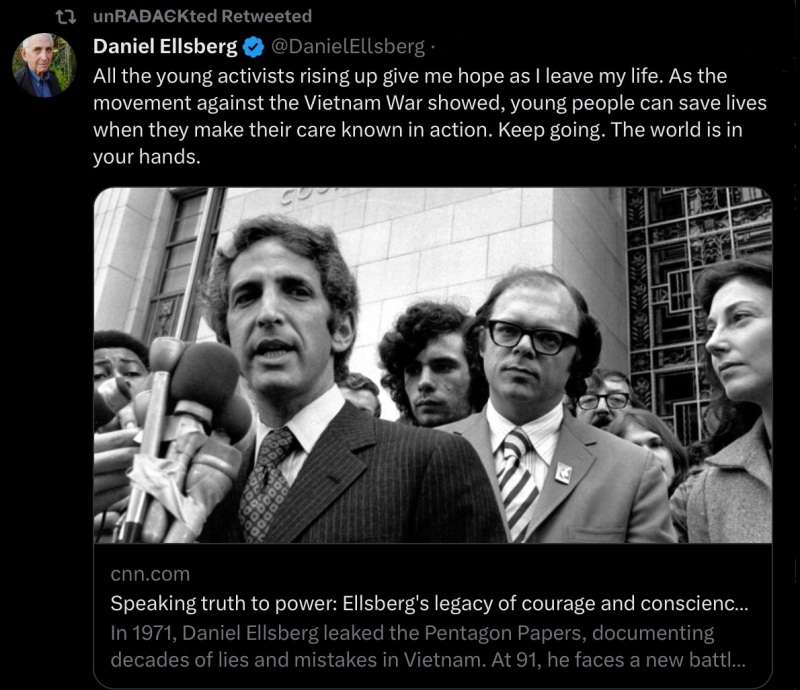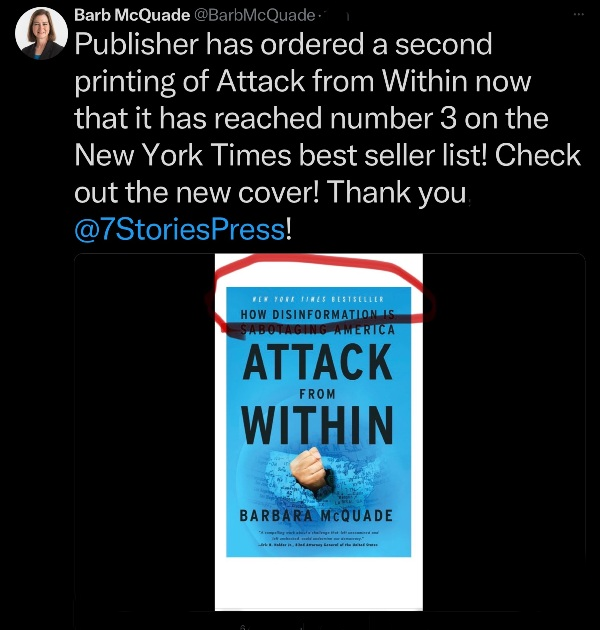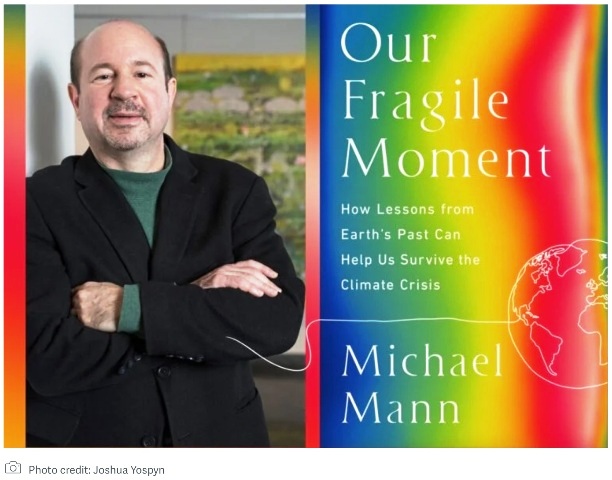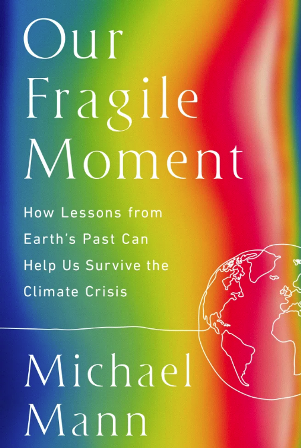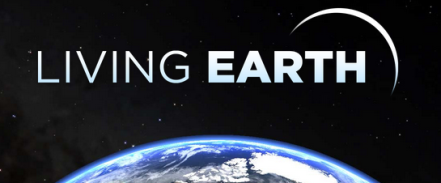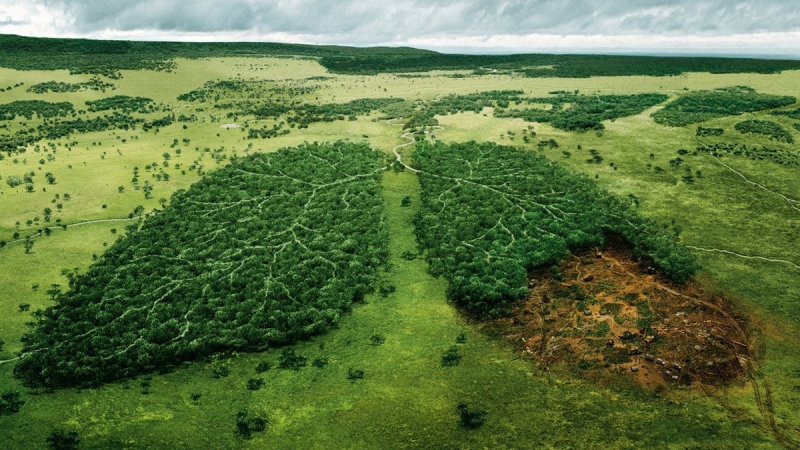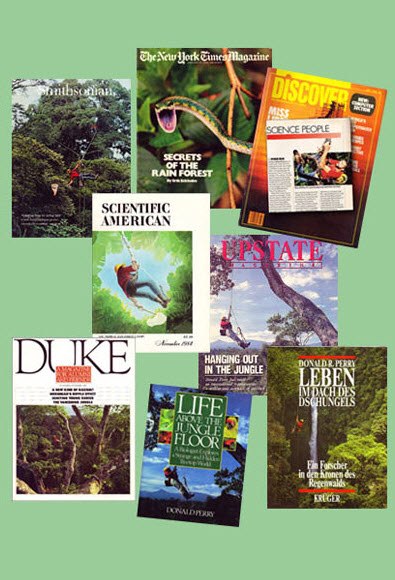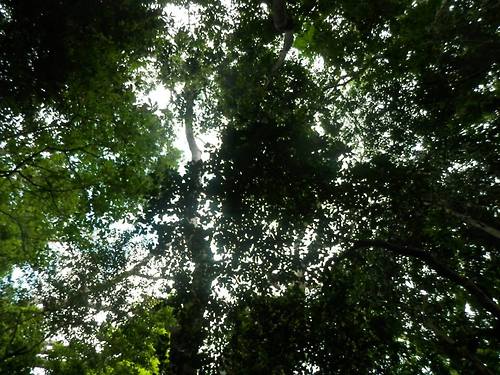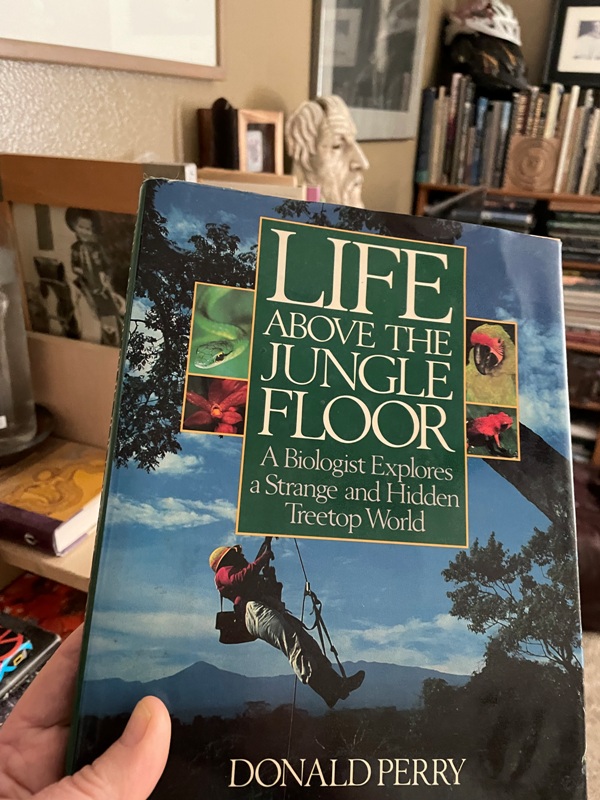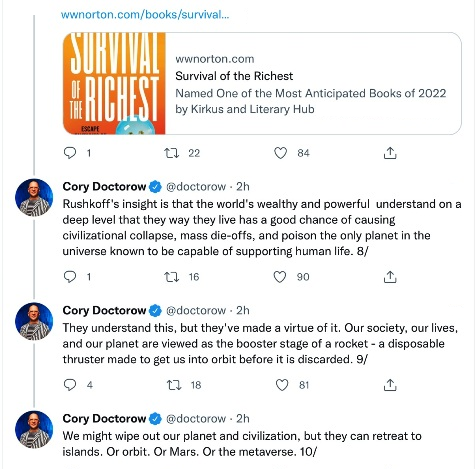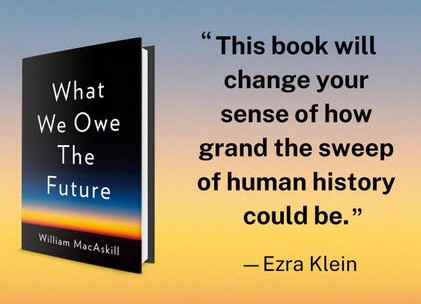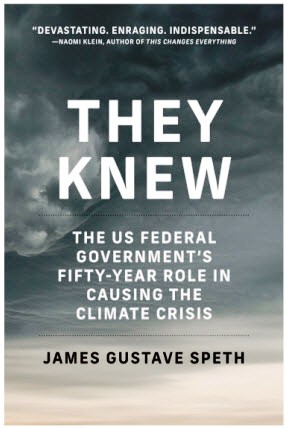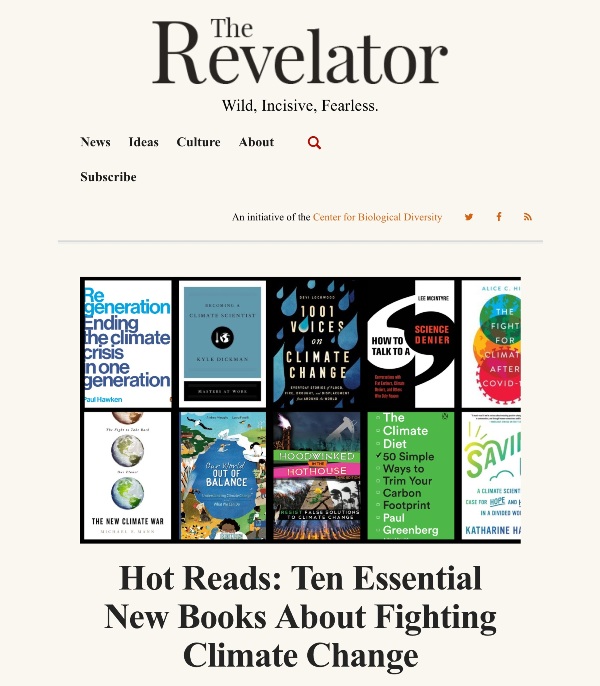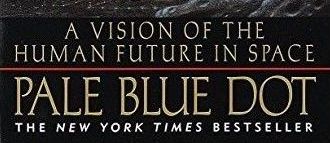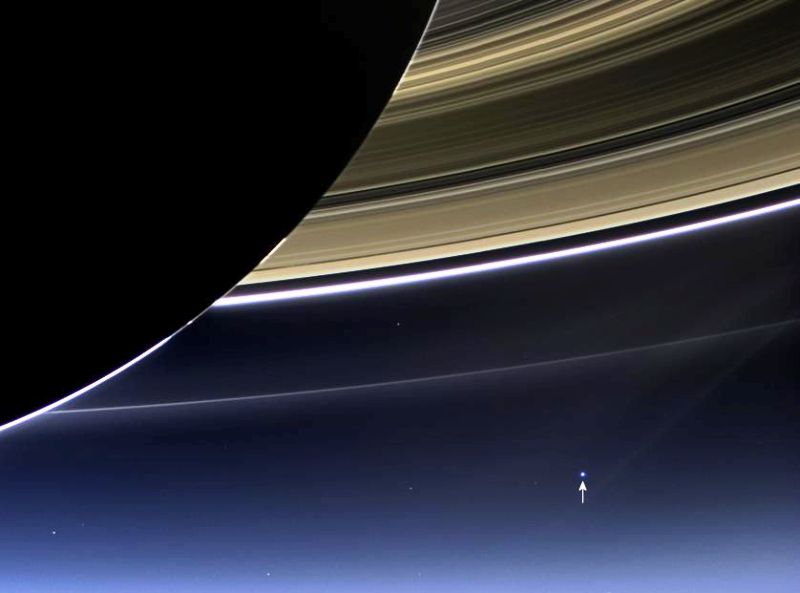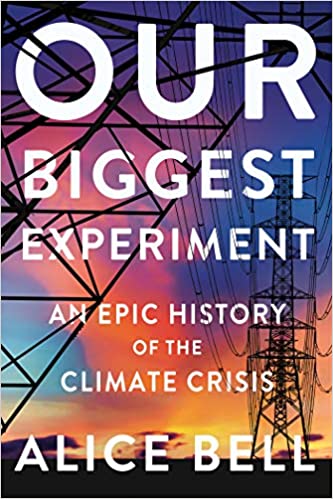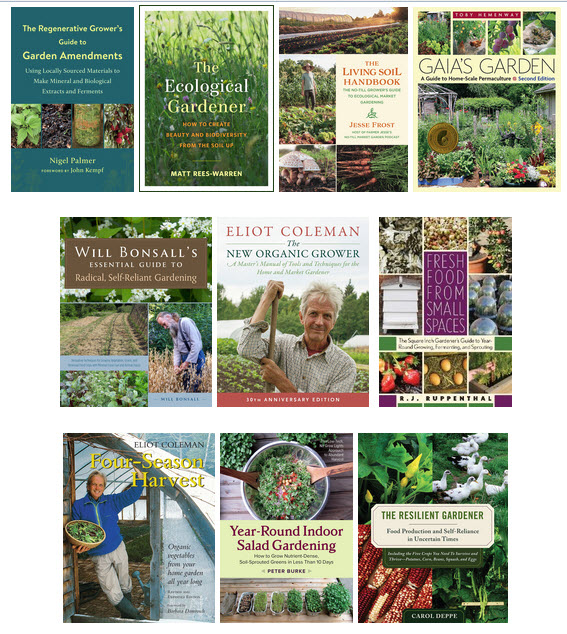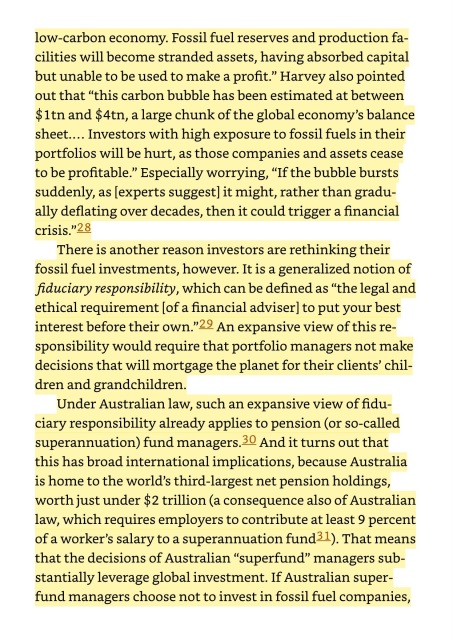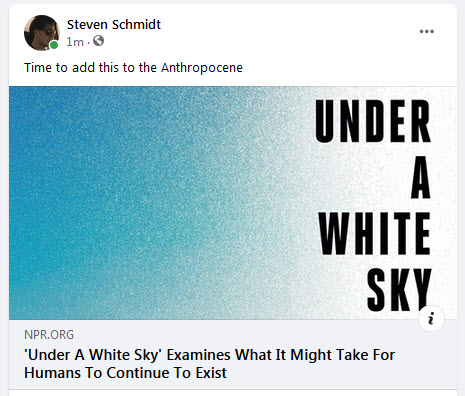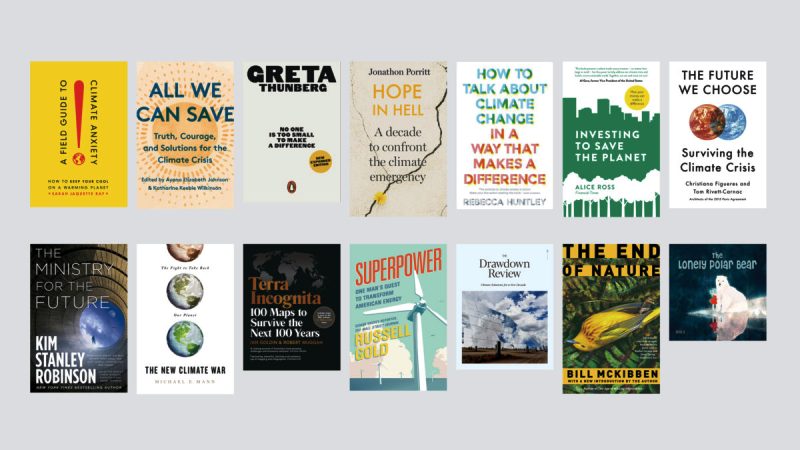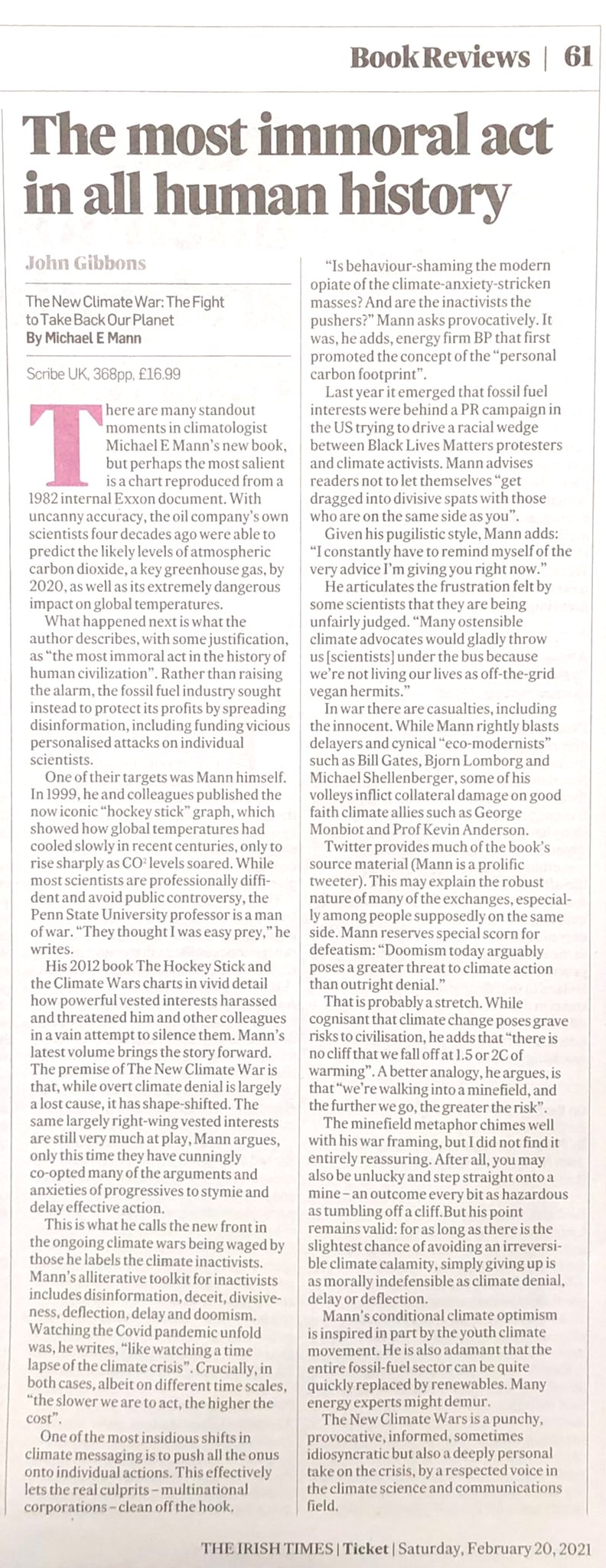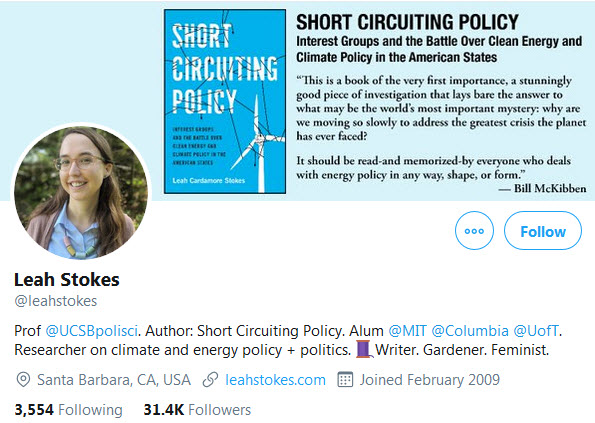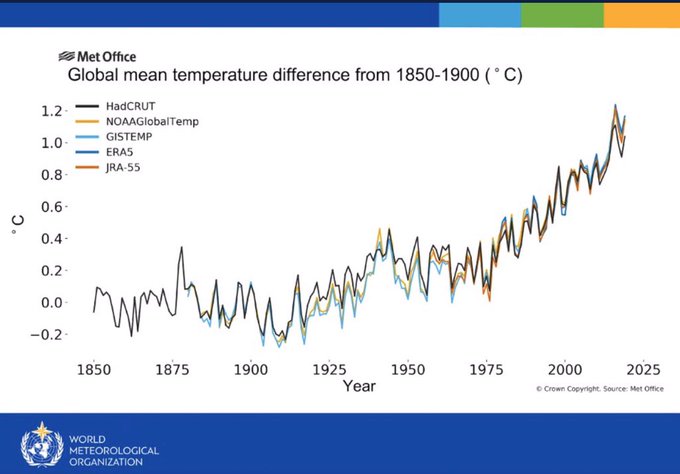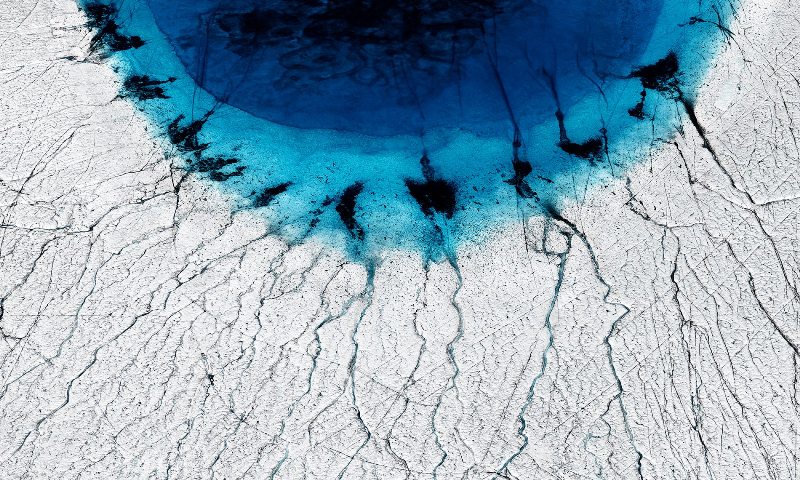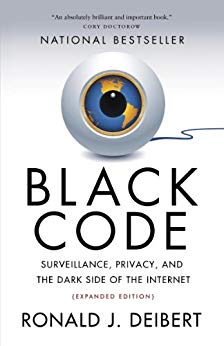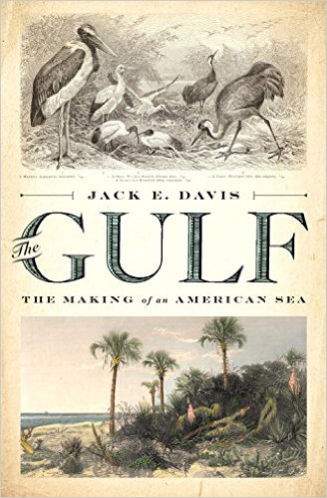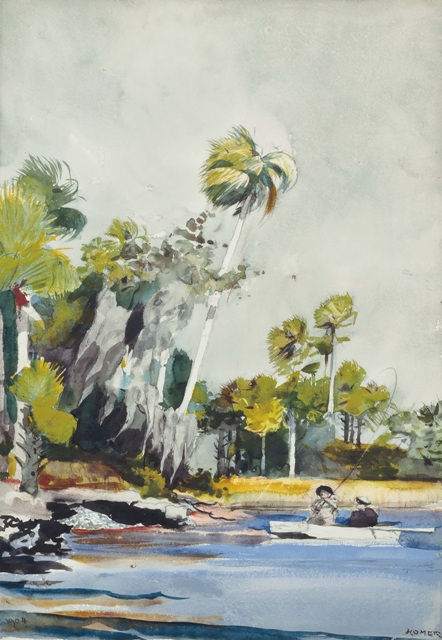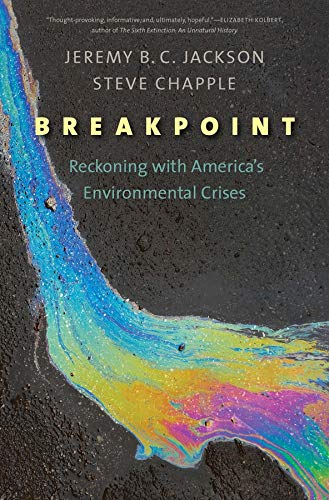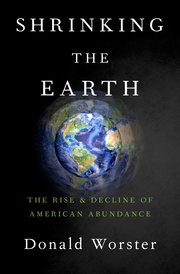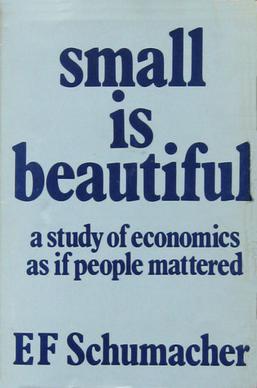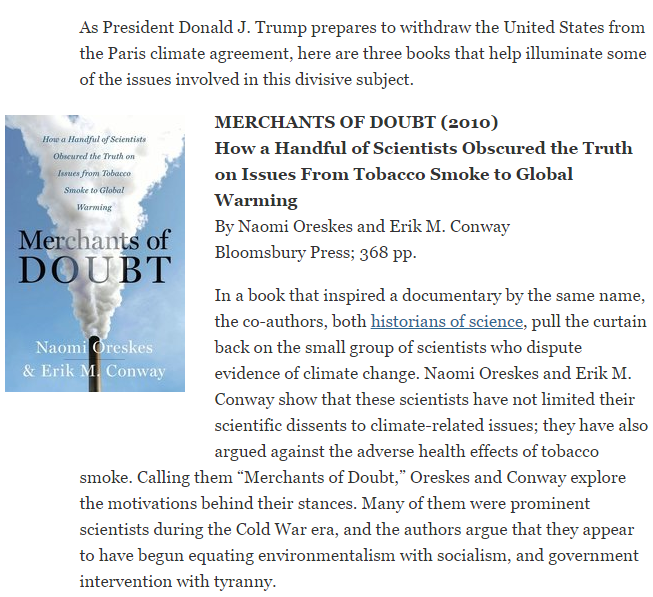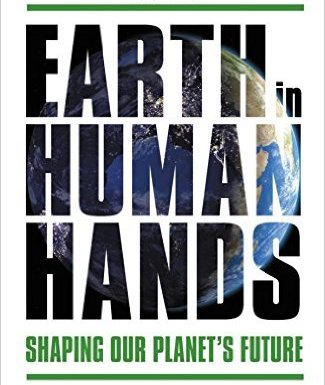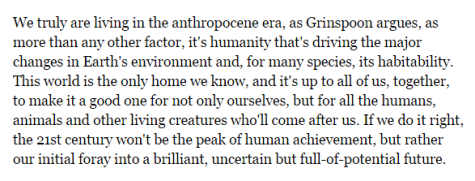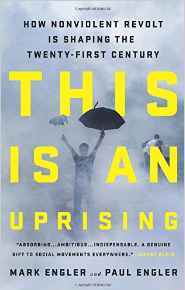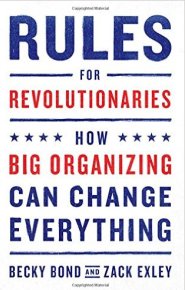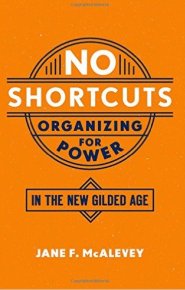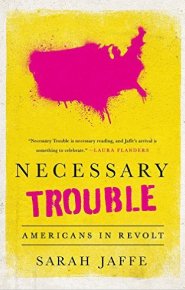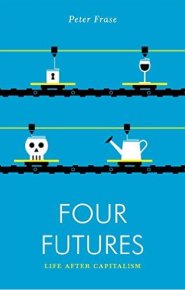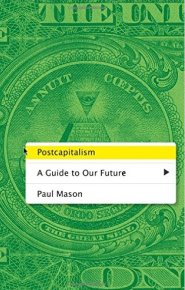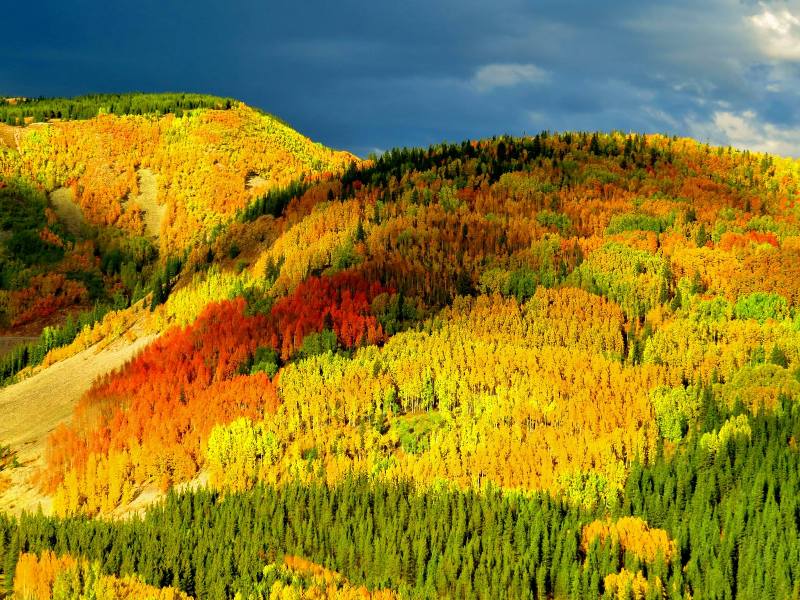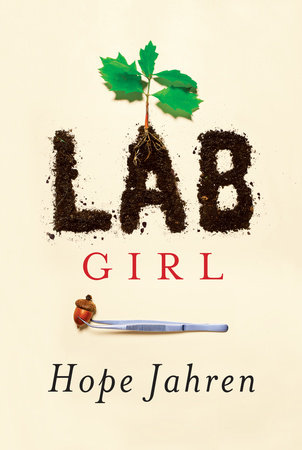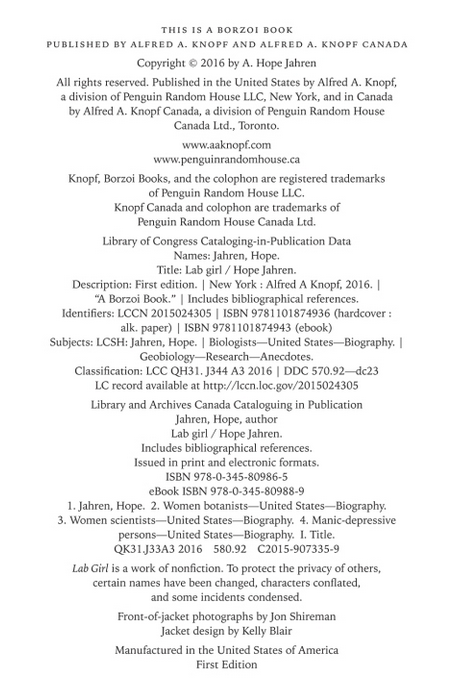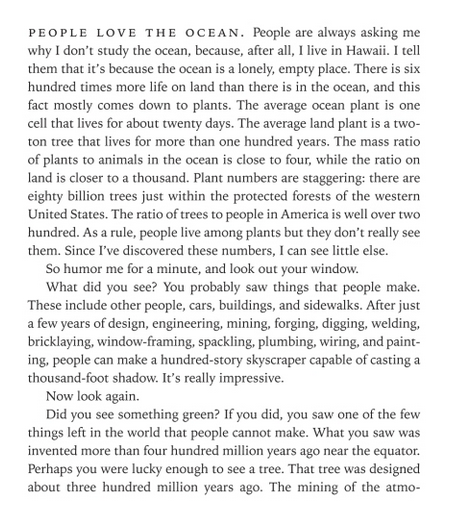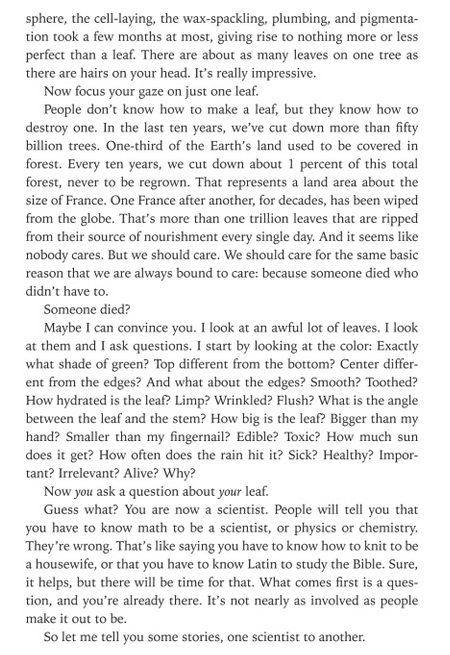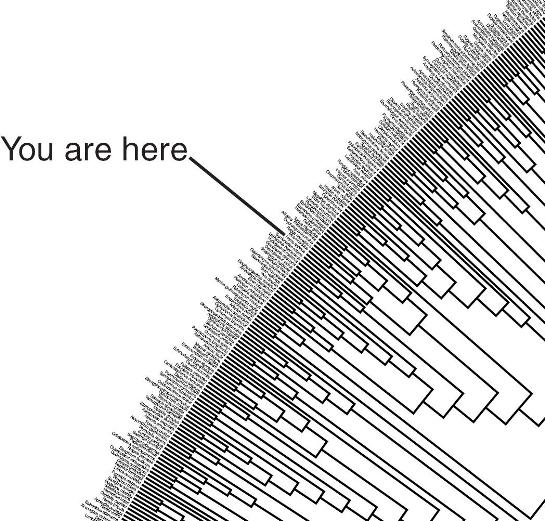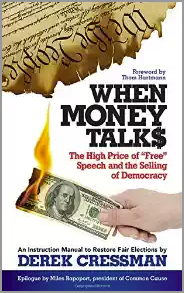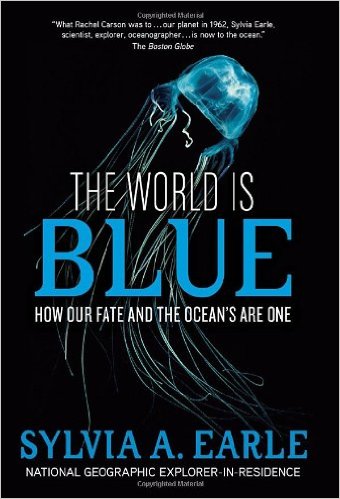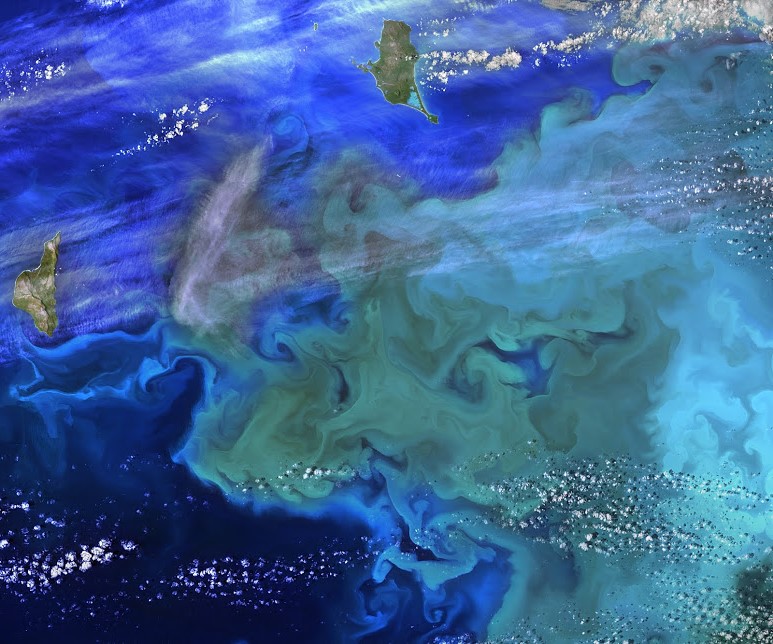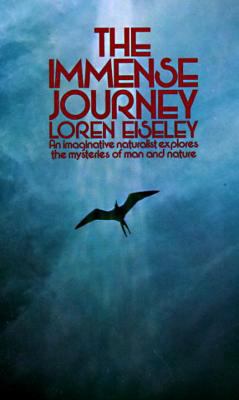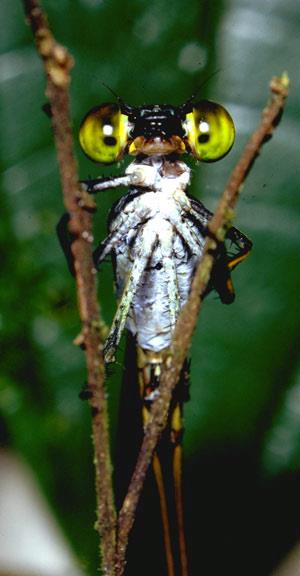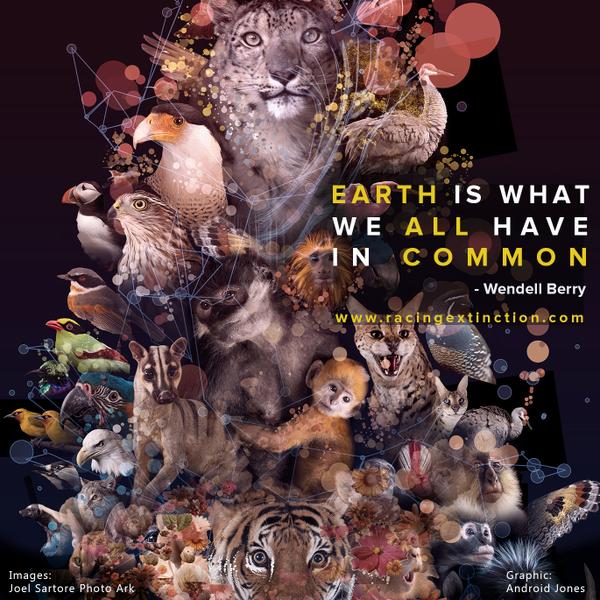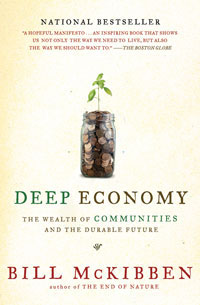Book Reviews @GreenPolicy
2024
GreenPolicy360 'Book of the Year'
May Contain Lies: How Stories, Statistics, and Studies Exploit Our Biases―And What We Can Do about It
By Alex Edmans (Author)
Alex Edmans is Professor of Finance at London Business School. Alex has a PhD from MIT as a Fulbright Scholar, and was previously a tenured professor at Wharton
Publisher: University of California Press
First Edition | 2024
Editorial Reviews
"A wonderful litany of the myriad ways in which we can be deceived, and deceive ourselves." ― The Guardian
"Entertaining, thorough and full of current examples. . . . It’s excellent." ― Wall Street Journal
"Confirmation bias can seem so engrained in us that it's difficult to shake. But Edmans highlights how first recognizing our biases and then taking small but intentional steps to overcome them can have an outsized effect on the quality of our decisions." ― Inc.
"A clear-headed guide to the exaggerations, sloppy research and the occasional downright lies peddled by companies, universities, authors and Ted Talk gurus. . . . Edmans is determined to make us better, more critical thinkers." ― The Times
"Edmans might believe that we’re post truth, but he also proposes that it is in everyone’s grasp to become smarter thinkers." ― Financial Times
"Edmans is out to help us better understand and analyse the data we are fed, and to aid us in becoming more sceptical. . . . The appendix (“a checklist for smarter thinking”) should be required reading." ― New Scientist
"Shows us how to be more discerning with evidence. . . . Is a statement a fact, is a fact truly data, is that data genuinely evidence, and is that evidence proof? The book provides tips for sussing that out." ― Times of India
“A practical-minded approach to various forms of mangled logic, appeals to bogus authority and other commonplace forms of cognitive distortion. . . . Besides identifying the problem, the author offers clearly formulated approaches to countering it. Every high school freshman should take a one-semester course with this as its textbook.” ― Inside Higher Ed
"Elegantly structured around an ascent up the ladder of ‘misinference.' " ― RealClearEnergy
"May Contain Lies is focused on identifying what is and isn’t reliable information. In a time when it feels like we are surrounded by more and more sources of misinformation and disinformation, this is certainly a welcome lesson." ― GeekDad From the Back Cover "Brilliantly researched and written and immensely practical in helping guide us through this thicket of (mis)information. I am already drawing on its insights in my everyday decision-making."—Andy Haldane, former Chief Economist, Bank of England
"A fascinating account of how to navigate through lies and misleading statistics to arrive at a reasonable approximation of the truth. A valuable aid to make sense of our confusing world."—Raghuram G. Rajan, Professor, University of Chicago, former Governor, Reserve Bank of India, and former Chief Economist, International Monetary Fund
"A powerful and punchy explanation of why misinformation is a problem that affects us all—be that in finance, politics, media, business, or anywhere else. Edmans offers clear ideas about how to counter this, not just in our own lives but also across society as a whole. Timely and very provocative!"—Gillian Tett, Editor-at-Large, Financial Times
"A masterpiece! A must-read book that is a delight to consume and sure to improve the quality of your thinking."—Katy Milkman, Professor, The Wharton School of the University of Pennsylvania, author of How to Change
"Mass disinformation and poor understanding of basic statistics are the hallmarks of our 'information age.' Alex Edmans's book is the much-needed antidote."—Vaclav Smil, author of How the World Really Works and Numbers Don't Lie
"A passionate and dispassionate call to truth—and how to achieve it—in a world of growing disinformation in which truth and common ground are the casualties."—Will Hutton, President, Academy of Social Sciences, author of The State We’re In
"A hard-hitting book with some great stories."—Andrew Gelman, Professor of Statistics and Political Science, Columbia University
"How should we determine what to believe and when to be skeptical of what we read and hear? Professor Alex Edmans has written a brilliant, engaging book about how to deal with our age of endless information. With terrific examples throughout, this is a book we all would benefit from reading."—Erwin Chemerinsky, Dean, University of California, Berkeley, School of Law
"May Contain Lies should be required reading for anyone venturing an opinion near a microphone or a screen. It's a lucid, honest, and vital guide to statistical reasoning, and a life raft of clarity in an ocean of lies."—Raj Patel, Research Professor, Lyndon B. Johnson School of Public Affairs, University of Texas at Austin
Read more on Fact Checking and Dis/Misinformation:
Responding to Denial of Climate Science
~
November 2024
October/September 2024
From the Publisher:
Confronting the Presidents
Washington to Jefferson, Lincoln to Franklin Delano Roosevelt, Kennedy to Nixon, Reagan to Obama and Biden, the 45 United States presidents have left lasting impacts on our nation. Some of their legacies continue today, some are justly forgotten, and some have changed as America has changed. Whether famous, infamous, or obscure, all the presidents shaped our nation in unexpected ways.
The authors' extensive research has uncovered never before seen historical facts based on private correspondence and newly discovered documentation, such as George Washington's troubled relationship with his mother.
In 'Confronting the Presidents', O’Reilly and Dugard present 45 wonderfully entertaining and insightful portraits of each president, with no-spin commentary on their achievements―or lack thereof. Who best served America, and who undermined the founding ideals? Who were the first ladies, and what were their surprising roles in making history? Which presidents were the best, which the worst, and which didn’t have much impact? How do decisions made in one era, under the pressure of particular circumstances, still resonate today? And what do presidents like to eat, drink, and do when they aren’t working―or even sometimes when they are?
These and many more questions are answered in each fascinating chapter of Confronting the Presidents. Written with O’Reilly and Dugard’s signature style, authority, and eye for telling detail, Confronting the Presidents will delight all readers of history, politics, and current affairs, especially during the 2024 election season.
Read a Sample:
A Table of Contents, then on to George Washington and, as the authors reveal, he and his mother have issues... Meanwhile, the new United States is announced and is officially standing among the nations of the world, as the Founders continue to argue about democracy, the republic, and the future of our democratic republic...
~
July
Nuclear War: A Scenario
"There is only one scenario other than an asteroid strike that could end the world as we know it in a matter of hours: nuclear war. And one of the triggers for that war would be a nuclear missile inbound toward the United States."
- Publisher: Dutton / Penguin-Random House
- Language: English
- Hardcover: 400 pages
- ISBN-10: 0593476093
- ISBN-13: 978-0593476093
- Item Weight: 1.3 pounds
- Dimensions: 6.2 x 1.24 x 9.27 inches
Reviews (2024):
J. Terrell
5.0 out of 5 stars Annie Jacobsen's Nuclear War Delivers a Heart-Pounding Journey into the Abyss of Nuclear Armageddon
Reviewed in the United States on April 30, 2024
A minute-by-minute account of a potential general nuclear war scenario, Annie Jacobsen's Nuclear War is one of the most dread-inducing and heart-pounding reading experiences I've ever had.
Beginning with the annihilation of the Washington D.C. by means of a 1-megaton nuclear warhead, Nuclear War rewinds the clock a full 24 minutes to the moment North Korea unexpectedly launches an intercontinental ballistic missile with trajectory aimed for somewhere in the United States. What follows is an account of "speculative narrative nonfiction" or "fictional nonfiction" as author Annie Jacobsen uses that postulated scenario to document the interplay between all of the various processes and policies that go into effect when the U.S. is under threat of nuclear attack—a scenario that leads, almost by accident, to full-bore nuclear exchange with Russia in a little over an hour.
The full breadth of Nuclear War... unfolds over just 72 minutes—from the first missile launch to the end of human civilization. Seem unrealistic? Well, in this account that unfolds in real time, Jacobsen's shows how it's not only plausible, it's possible. Based on recently declassified government reports and studies, reading Nuclear War is like having the veil of "assumed safety" torn from your eyes—it's being unplugged from the Matrix and realizing we're all just a hair trigger away from Armageddon because of the insatiable greed and madness that fueled the proliferation of "bigger and better" nuclear weapons in the wake of World War II and the Cold War.
Intercutting between various government agencies, military personnel, public officials, submarines, satellites, silos, and ground zero impact zones, Nuclear War demands to be read in as few sittings as possible. The cascading and escalating effects of the world's Mutually Assured Destruction (MAD) policies coupled with faulty, inconsistent deterrent technology and zero-sum game assumptions about human nature mean the 72 minutes Nuclear War depicts unfold with inevitable grimness typically reserved for the likes of horror novelists.
And in the final section of Nuclear War, Jacobsen reveals what a post-nuclear war Earth would actually look like and, in the process, shoots down any post-apocalyptic or prepper fantasies one might have about "surviving" the end of the world.
So, why read Nuclear War? For one, it's a morbidly fascinating depiction of one of the most likely endgame scenarios for human civilization. It also works as one of the most effective nuclear disarmament arguments you're likely to ever read and a fierce warning against the electing of morally incongruous, hot-headed, and incompetent political leaders. Nuclear War is disturbingly prescient, paced liked a thriller, and will stay with you for a long, long time.
JML
5.0 out of 5 stars One of the Best Books Ever
Reviewed in the United States on June 6, 2024
It's hard to express how good Nuclear War: A Scenario is, but let's start with Jacobsen herself: articulate, deeply informed, plausible. I've watched several podcasts with her discussing the book's contents, and she's totally convincing. Too bad for us: that angelic voice telling you you're doomed.
- (Ed: Podcasts/Video)
C. Brown
5.0 out of 5 stars A Gripping Chronicle of Unimaginable Catastrophe
Reviewed in the United States on April 12, 2024
Annie Jacobsen's "Nuclear War" achieves a rare feat in literary journalism by providing a near-minute-by-minute account of a hypothetical nuclear launch by North Korea against the United States. This scenario, expertly detailed by Jacobsen, captures the terrifying immediacy and catastrophic aftermath of such an event, immersing the reader in a vividly realistic, spine-chilling, and instructive narrative.
Jacobsen’s ability to describe complex military and technological procedures in an accessible way is particularly noteworthy. She sketches out the tense moments leading up to the launch, the frantic government responses, and the tragic human consequences with precision and depth, making the scenario feel alarmingly plausible.
The description of the aftermath is harrowing, detailing the environmental, political, and human toll with unflinching clarity. Jacobsen does not shy away from the grim realities of nuclear warfare, instead she lays them bare, forcing the reader to confront the potential real-world consequences of current nuclear strategies and the urgent need for diplomacy and disarmament.
This book is a masterclass in tension and realism, providing an essential perspective on the horrors of nuclear war. Jacobsen’s meticulous attention to detail and her compelling narrative style ensure that the subject matter's gravity is understood and felt. This is not just a book but a powerful call to awareness and action in the face of one of humanity's gravest threats.
"Nuclear War" is a must-read, not only for its educational value but also for its capacity to engage and challenge its audience.
Soso
4.0 out of 5 stars Must read despite the flaws
Reviewed in the United States on May 5, 2024
Tom Clancy once said, "The difference between fiction and reality? Fiction has to make sense."
This book shows the multi trillion dollar US nuclear war machine in action in what it presents as a plausible scenario for a nuclear war.
Read this book for its very well researched portrayal of the huge US nuclear war establishment, what it is, the logic behind it, and how it is likely to operate in a nuclear crisis. Very few people in the US are aware of the immense scale of America's preparation for nuclear war. This book will bring much of that to life.
The book is a revelation, presenting information in a non-political way that every voter should know. It does an outstanding job of credibly conveying how the many organizations and technologies in the US nuclear complex would interact and ratchet forward with unstoppable pseudo-logic in a war that kills hundreds of millions of people in less than two hours.
The details of how the US's vast nuclear military organizations, which already exist and practice their work every day, will function in a crisis make it clear that the death of hundreds of millions is neither fantasy nor exaggeration. Hundreds of millions of Americans will indeed be killed in a general nuclear war. If anything, the death of hundreds of millions is simply a base case on the way to killing billions of people around the world, including billions of bystanders.
But the fictional scenario the author employs to show the nuclear establishment in action does not make sense at almost all key junctures. Even allowing for the fog of war and the possibility that something as catastrophic as general nuclear war might result from a chain of unlikely accidents, the inexplicable implausibility of how the plot is written gives a sense of unreality to the book.
That's a bad thing because the accuracy, truth, and real consequences of how this book presents US nuclear war plans should not be tainted by any sense of unreality arising from readers considering the plot and thinking "Oh, that's absurd, it could never happen that way."
So read the book to understand what the US has already built and what those trillion dollar organizations will do in a nuclear crisis, while cutting the author some slack for an implausible plot. The author knows her stuff when it comes to the US weapons complex but she's no Tom Clancy. That's OK as the rest of the book delivers as it should.
I've been studying nuclear matters for many years and even for me there were many revelations in this book. Some of them, like the news that there were four nuclear explosions during the Cuban Missile Crisis (yes, really, up in space, two from the US and two from the USSR...) were annoyingly buried in the notes at the end of the book. But despite such flaws this book is full of wake up calls and fresh insights.
After reading this book, readers will know down to the marrow of their bones three key truths about the reality of nuclear war:
1. The scale of destruction. Some people tell themselves nukes aren't the problem they were because now there are fewer of them, they are smaller, and what's out of mind is not a threat. Not so. There are thousands of nukes on both sides on hair trigger alert, ready to launch, and a single one of them can annihilate an entire city, as shown in the opening sequence. A fraction of the nukes on either side can kill hundreds of millions of people. They're real and they're ready for action.
2. The speed of action. There is almost no time to deliberate how to de-escalate a war, given how the nuclear establishments have been designed for speed of action. It only takes 15 minutes from the time an order is given in Washington or Moscow for the missile subs of either side to have lifted to launch depth and to have launched all their missiles. With possibly only a few minutes of flight time for a sub-launched missile, not hours, the leaders of either side will have only a few minutes to make the decision of how many millions of people they will kill in their response, those decisions taken from complicated menus of options that usually US presidents will see for only the first time in the heat of a crisis.
3. The unstoppable decisions. There is no stopping a missile once launched, no self-destruct option from the launching side, and no realistic hope to defend. The hundreds of billions that have been spent on missile defense systems have been wasted on pork projects that have proven to be total failures.
T. Haugh
5.0 out of 5 stars Scared the Bejeezus Out of Me
Reviewed in the United States on June 12, 2024
My teenaged years covered most of the 1980’s. Exacerbated by my love of science fiction and post-apocalyptic fiction, I was obsessed by the idea of nuclear war. I still think that the final half hour of the movie War Games (besides being now a nostalgic snapshot of early home computer technology) is still some of the scariest moments ever put to film. From duck-and-cover-drills to the television event that was The Day After, fear of nuclear war was everywhere. Then, came the end of the Cold War and a shrinking of nuclear arsenals. Nuclear war seemed to fade from our collective consciousness. Now, in this excellent, frightening book, Ms. Jacobsen reminds us of how easily nuclear war could start and destroy the world.
In this book, Ms. Jacobson gives us a minute-by-minute scenario where North Korea launches a single nuclear missile targeting Washington DC, followed by a sub-launched missile targeting a nuclear power plant in Southern California. Within 24 minutes after launch, these 2 missiles lead to a cascading sequence of quick decisions and escalating events that are irreparable. In less than an hour, the entire world is engulfed in destruction. It is absolutely chilling because it could so easily happen.
Along the way, Ms. Jacobsen describes the history of the development of our nuclear arsenal and the way it could potentially be used. She shows how the president became the sole decision-maker on the use of our nuclear weapons but how choices are actually limited by the necessities of the military and the tiny timeframe in which to make decisions. She discusses the actual war games and scenarios that have been played out in all seriousness by our military and its scientists and the sad fact is that none of these scenarios lead to anything other than total obliteration.
Due to my interest in the subject, I was familiar with some of what Ms. Jacobson describes here, though to have it play out in real time is nerve-wracking. There were some things with which I was not familiar, however; in particular, I did not realize how shoddy Russia’s early warning system is. (Knowing that there are Russian spies living near silos to visually report a launch seems ridiculously low-tech.) I also admit that one major question I had was how, despite this, Russia was not aware of North Korea’s launch in a similar time frame to the U.S. How could they not know the launch was from there? How could they only become aware something was happening when we launched? It seems a bit beyond belief.
Anyway, I have rarely come across such a frightening read. The description of what happens once the bombs start to hit is sickening. Though I am an optimist who believes some form of human life will hang on in the wilds of New Zealand or Antarctica, surviving the decade of darkness and rebuilding some form of human culture is not something in which I would want to participate. Like Dr. Falken in War Games, I live close to a primary target: “a millisecond of brilliant light and we’re vaporized”. God willing, we’ll find a way past this deadly era. If a lot of people read this top-notch book, perhaps we’ll have a better chance.
Paige
5.0 out of 5 stars This book should be mandatory reading for all
Reviewed in the United States on July 2, 2024
This book is so well written that I set aside my new Jack Carr novel and read this instead. Full of research, facts, quotes, while presenting a gripping fictional story. I could not put this book down. When you read that the US President and his staff have less than 7 minutes to decide on, and activate, a course of action, then think about our current and past Presidents, you realize how vulnerable and naive we are as a nation. There are politicians who believe that nuclear war is survivable! A must read book for all voters.
E.Garrity
5.0 out of 5 stars Another weapon, another purpose; this one, Nuclear Weapons, developed for mass destruction.
Reviewed in the United States on May 3, 2024
There are Media Easter Eggs sprinkled throughout her books, delivered by the persons she interviewed and casted by her authorship, especially from those individuals who felt regrets towards the end of their lives.
From page 4 in the Kindle version of the book:
"In 2008, in his late eighties, a few years before he died, Rubel [John H. Rubel was an Assistant Director (to Herbert York) of Defense Research and Engineering in the Pentagon in 1959.] revealed this information in a short memoir. As Rubel prepared for his own death, he summoned the courage to express a long-repressed truth. That he felt remorse for having participated in such a “heart of darkness” plan. For saying nothing for so many decades after the fact. What he was part of, Rubel wrote, was a plan for 'mass extermination.' His words."
In that same memoir ("DOOMSDAY DELAYED - USAF Strategic Weapons Doctrine and SIOP-62, 1959-1962 - Two Cautionary Tales"), written on the third page, is the following:
"In 1945 von Karman headed a committee charged with finding out everything it could about German aeronautical developments during WWII. In 1946 the Air Force, still under the Army, set up the RAND (Research AND Development), think-tank in Santa Monica, California, a multidisciplinary group of engineers, scientists, economists, psychologists and others to think about war in general and new weapons in particular.
RAND quickly proposed a death-ray project, which the Air Force approved.
Was this mention of a "death-ray project" a foreboding of the weapon now used to produce Anomalous Health Incidents (Alternatively known as "Havana Syndrome")?
The books written by Annie Jacobsen are primarily about technology conceived and created for defense and warfare, but ultimately for power and control. Technology harnessed for such purposes. A paradox we have not been able to escape. It seems an historical rule that if a technology can be used as a weapon, it will be used as a weapon.
From page 299 in the Kindle version of the book: "Charles H. Townes (1915–2015), who won the Nobel Prize in 1964, left a profound impact on my thinking (which I write about in Phenomena). The concept of dual use technology—science that can be used to help or to harm—is a paradox. Townes’s invention, the laser, has done so much to benefit mankind, from laser surgery to laser printers, but the Pentagon’s classified laser weapons program is fostering a new kind of arms race."
From page 300 in the Kindle version of the book: "Marvin L. “Murph” Goldberger (1922–2014), founder of the Jason advisory panel, designed many weapons systems for the Pentagon. He shared with me his vast knowledge about sensor technology and its role in command and control. He also shared a regret. Goldberger told me he wished he’d spent more time doing science for science’s sake and not doing science for war. “At the end of your life you think about these things,” he said."
This is another interesting book by Annie Jacobson, the sixth I've read thus far, having read them in the following order of completion: 1.) "Operation Paperclip" on Sep 6, 2023, 2.) "The Pentagon's Brain, An Uncensored History of DARPA" on October 28, 2023, 3.) "Phenomena" on Dec 16, 2023, 4.) "Area 51" on Feb 26, 2024, 5.) "First Platoon" on Mar 25, 2024, and 6.) "Nuclear War: A Scenario" on May 2, 2024.
Everyone of these books mention or allude to the use of Electromagnetic (EM) waves as a means to obtain intelligence, create more weapon systems, or to deceive. There are references to the use of EM-based technologies throughout her books, such as in the "55 Minute" chapter of this book, describing the detonation of a "Super-EMP weapon" and the conception of a deception device discussed on page 296 in the Kindle version of "First Platoon - A STORY OF MODERN WAR IN THE AGE OF IDENTITY DOMINANCE":
"The Pentagon aims to have its hyper-enabled operators carry a device that has “the ability to project images that are not real but seem real, and have the ability to develop personalized message campaigns for the image to project.” In other words, three-dimensional deepfakes, to trick the enemy—in real time."
W. Miller
5.0 out of 5 stars A cautionary tale
Reviewed in the United States on April 6, 2024
Since the fall of the Soviet Union in 1991, global nuclear war has receded from the concerns of most people. However, the forbidden subject has reemerged with the Ukrainian-Russian war and nuclear-armed rogue states becoming a real threat. An award-winning journalist for the Los Angeles Times, Annie Jacobsen has written a convincing scenario for a worldwide nuclear war.
A scenario is an outline of predicted events. In a military scenario, the actors are commanding officers, military units, and civilian authorities. I wrote a scenario for how my army command would be relocated to Europe during the war with the Soviet Union. It is a work of fiction, but the courses of action are as realistic as possible. Scenarios in this case act as a guide for implementing policy.
In Jacobsen’s book, the scenario is this: A rogue nation, North Korea, and its leader, Kim Il Un, launch three ballistic missiles at the United States: The Pentagon, a nuclear power plant in California, and a third over the United States to produce an overwhelming Electro-Magnetic Pulse to wipe out America’s power grid. The government of the United States had no warning and, at this time, had no inkling of the impending attack. Through a series of miscalculations, Russia thinks the United States is attacking because the retaliatory strike of Minutemen missiles will cross over Russian territories. In the meantime, the President has around fifteen minutes to decide whether to authorize a counterstrike. He, at the last second, decides on a proper response. He’s whisked away to an underground bunker outside of the District of Columbia. Before he gets to the bunker, Marine Helicopter One crashes. Now, the top echelon of civilians must agree on a successor. While this happens a second hydrogen bomb-equipped missile hits the Canyon Diablo Nuclear Power Plant in California. Now, the Russians seeing the counterstrike against North Korea convince themselves that they are under attack and not waiting for a response from Washington, launch a retaliatory attack with Russia’s entire arsenal of bombs. Predictively, the Acting President retaliates with all the United States’ arsenal.
Two things I came away with were: the decisions being made with the idea that there may only be thirty minutes to decide the fate of mankind. Only one man, the President of the United States and the President of Russia will be carrying the burden of deciding the fate of mankind. The other point is that another man, Kim Il Un, can start the fuse being lit without a word of consultation from any other leader. Kim Il Un has the Hwasong-17 ICBM, he has most likely a one-megaton hydrogen bomb, and Un has an elaborate underground bunker which is on a par with or better than what the US or Russia has. Un has the disposition of doing things alone and has no allies to consult with.
The book's final section describes what a full-blown nuclear attack would be like. One thousand warheads were directed at every conceivable target in the United States. Hundreds of millions in the United States would die an extremely painful death. Russia, in Europe, and in close allied countries such as South Korea and Japan would face a similar fate. China, even if it didn’t get drawn into the war, would suffer hundreds of millions of casualties due to radioactive fallout.
The book is a quick read. She did a lot of research on this project and used heretofore highly classified documents and interviews with former department heads in several defense agencies. It doesn’t call for any recommendations. I recommend this book to anyone concerned with the war talk going around nowadays.
DES
5.0 out of 5 stars It May Be Non-Fiction, But This Book Will Scare You Into Sleepless Nights
Reviewed in the United States on April 30, 2024
Because I don’t read fiction, there has never been a book that scared me... until now. “Nuclear War: A Scenario” by Annie Jacobsen illustrates how, in less than an hour, a nuclear launch can lead to the distraction of our planet with a few simple errors and overreactions.
Jacobsen spent more than a decade interviewing dozens of experts while mastering the voluminous literature on the subject, some of which had only recently been declassified.
The book describes a mass extinction event that begins with an imaginary narrative that begins with North Korea launching a missile against the United States. The threat is real as nine governments possess nuclear weapons. For many of them, the decision to kill millions of people in an instant rests with one man, whether Kim, Putin, or the president of the United States.
Beginning with the historical context of atomic weapons development, Jacobsen highlights the evolution of nuclear arsenals and the policy frameworks guiding their potential use. She then delves into a hypothetical scenario triggered by North Korea's missile launch, illustrating the rapid escalation and devastation that ensue. With nine nuclear-armed nations and the power to unleash destruction resting in the hands of a few individuals, the book underscores the ever-present threat of annihilation. Key highlights include the mechanics of nuclear weaponry, the harrowing realities of nuclear winter, and the psychological toll of decision-making in a time-critical environment. Ultimately, the book serves as a sobering reminder of the madness inherent in nuclear warfare and the urgent imperative for global disarmament.
Among the key points:
HISTORICAL CONTEXT – The book includes information on the development of nuclear policy, including concepts like Launch on Warning and Hair-Trigger Alert, which underscore the precariousness of nuclear deterrence.
TECHNOLOGICAL REALITIES – Jacobsen shares insights into the mechanics of nuclear weapons, from thermonuclear bombs to intercontinental ballistic missiles, highlighting the sheer destructive power and complexity involved.
OPERATIONAL CHALLENGES - The book explores the intricacies of defense systems and decision-making processes, revealing the daunting task of mitigating the effects of a nuclear attack and the pressures leaders face under extreme time constraints.
HUMANITARIAN CONSEQUENCES – There are vivid descriptions that depict the unimaginable horrors of nuclear war, from immediate casualties to long-term environmental and health catastrophes, emphasizing the incomprehensible suffering inflicted on humanity.
STRATEGIC VULNERABILITIES - The book explores vulnerabilities in defense systems, such as the limited number of interceptor missiles available to defend against incoming nuclear warheads, revealing the potential inadequacy of current defense strategies.
"Nuclear War: A Scenario" drives home the stark reality that the use of nuclear weapons is inherently irrational and catastrophic. Jacobsen underscores the urgent imperative for global nuclear disarmament to prevent the unfathomable devastation depicted in the book from becoming a terrifying reality.
Read this book before bed, and you won’t sleep well.
__________________________________________
More on the Present Danger of Nuclear War
Scan Strategic Demands / StratDem
Nuclear Weapons / Command & Control
Dan Ellsberg / Before the 'Pentagon Papers' as a Nuclear War Planner
Nuclear War / Nuclear 'Cold War' Getting Hotter
A PBS Documentary, an 'American Experience' Special Event, Reveals How Close the World Came to Nuclear War
Dan Ellsberg book, "The Doomsday Machine, Confessions of a Nuclear War Plannet", brings film producers to tell a story that needs to be told
- https://www.greenpolicy360.net/w/File:Dan_Ellsberg_-_the_world_is_in_your_hands.png
- https://www.greenpolicy360.net/w/File:Dan_Ellsberg_-_March_2023.png
Truth-telling
For those who have followed the political work of GreenPolicy360, you know about our multi-year focus on fact checking and disinformation. As we often say -- "Facts count."
We have also cast a spotlight on how politics in the US, via a high velocity Internet, is spreading an epidemic of dis- and mis-information. Disinfo has become a virus. The viral disinfo results are delivering a weakened and increasingly at risk body politic.
In the past we've given 'dirty tricks' a call out of dysfunctional politics in the US. The history of this style of 'attack politics' in the modern media era traces back to the arrival of high-profile PR consulting firms in the 1960s. (Spencer-Roberts comes to mind). Aid of President Nixon became names known in the Watergate end of the presidency. The career of Hollywood actor turned Governor-then-President, Ronald Reagan, brought new partisan strategies and campaigning. Now, with state-of-the-art metrics, media, marketing, and information tech (IT) tools that have turned the Internet into a battleground, disinformation is everyday politics and is done to damage and destroy. Attack politics 'works', political consultants have shown, and the Internet is the enabler of this brand of politics..
'Digital citizens' are facing an ongoing onslaught of intent to deceive, anger and disrupt. From foreign governments and intel ops, to farmers in mid-America on a break from plowing, it's a wild world. The Internet era has become target rich with a data-gathering business model living off of 'clicks and views, engagement and responses'. Anyone and everyone is seemingly online, and targetable. The Net, the Web, it's where the big powers, the big money, the good, bad, and 'ugly' go... and disinformation, and dirty tricks, is targeted using data with unprecedented precision.
Barbara McQuade dives into this world. On an increasingly alarming scope and scale, she speaks of the public being manipulated for political results by disinformation meant to infect/effect and cause responses. Feverish behavior is out and about. Cyber wars are being waged, digital targeting and powerful databases are driving politcal campaigns, hacking (ala 'The Great Hack' of 2016, but now far advanced in techniques) prevail.
Fortunately, Barb McQuade's sharp mind, legal reasoning, and digital awareness are here for us as we must sort out the threats and remedies.
The message is blunt and powerful in its warning -- Democracy, democratic institutions, the republic is at risk in the United States, and across the world. Authoritarian regimes vs. Democratic governing and individual rights. Pay attention. Those behind the systems, operating with 'dark money' and contributions from players looking to manipulate outcomes, are embedded, capable, and aiming to exert their will. This all is brought into the light by McQuade, Esq.
Let the light shine far beyond Barbara's book.
Check out Barb McQuade's latest news on TW and follow her online interviews and her group of attorneys ('Sisters in Law') as they tour the US in 2024.
Barb McQuade, Jill Wine-Banks, Joyce Vance and Kimberly Atkins-Stohr
- ‘Sisters-in-Law’, the 2024 Tour
🌎
February
Attack from Within: How Disinformation Is Sabotaging America
by Barbara McQuade, Professor, University of Michigan Law School
An urgent, comprehensive explanation of the ways disinformation is impacting democracy, and practical solutions that can be pursued to strengthen the public, media, and truth-based politics.
Reviews (Via the Publisher)
"A concise introduction to the threat to American democracy . . . for those curious about the past and future of political disinformation.”
—Publishers Weekly
"A great public servant and one of the most acute observers of our time shares insightful views about the menace of disinformation—its history, its dangers, how it threatens America in particular and how we fix the problem. This is a compelling work about a challenge that—left unexamined and left unchecked—could undermine our democracy."
—Eric H. Holder Jr, 82nd Attorney General of the United States
“A comprehensive guide to the dynamics of disinformation and a necessary call to the ethical commitment to truth that all democracies require."
—Timothy Snyder, author of the New York Times bestseller On Tyranny
“Barbara McQuade brings an experienced and refreshingly sober lens to America's current challenges. Her writing and legal analysis is an antidote to both ignorance and political hysteria—at a time when we all need to be informed and vigilant about the threats posed by would-be authoritarians and their enablers.”
—Ari Melber, MSNBC Chief Legal Correspondent; Host, "The Beat with Ari Melber"
"Is our democracy destined for death by disinformation? That is among the urgent questions addressed by Barb McQuade in this timely and engaging book. McQuade, a former national security prosecutor, argues that information warfare is at the center of efforts by far-right operatives, including Republican party elites, to turn Americans against each other and inflame racial and other hatreds, sabotaging our civil society and America's position as a leader of the free world. She also offers solutions to the epidemic of disinformation, from enhanced regulation of social media companies to accountability measures against bots to support for local journalism. It is essential reading and her message that we must make truth in democracy our national purpose could not come at a better moment."
—Ruth Ben-Ghiat, author of Strongmen: From Mussolini to the Present.
"Meticulous, lucid, compelling. Spurred by the 'fierce urgency of now,' McQuade has laid out how we can recognize and then disarm the weapon of disinformation and, in the process, save American democracy."
—Carol Anderson, author of One Person, No Vote: How Voter Suppression is Destroying our Democracy and the New York Times bestseller White Rage
“Barb McQuade offers a sweeping and panoramic view of the disinformation landscape and how it contributes to the erosion of our shared reality, which is a sine qua non for the rule of law. Like any seasoned prosecutor she marshals the evidence, presents expert testimony, and makes the case for why this threat is one we must address together, as citizens. Her book is a wake-up call for the need to take back power from social media platforms and would-be authoritarians and restore our democratic norms and responsibility to the truth.”
—Asha Rangappa, Assistant Dean and Senior Lecturer, Jackson School of Global Affairs, Yale University, Former FBI Counterintelligence Agent
"Barbara McQuade offers a superb, easy-to-read assessment of the information war being waged in America right now, what the stakes are, and what can be done to turn things around. As someone who grew up behind the Iron Curtain, I understand the dangers of authoritarianism. If you want to understand the risks to democracy and how we can address them, read this important book."
— Martina Navratilova
“Barb McQuade has the rare ability to ask the right questions and then answer them. Her take on disinformation — how and why it's been used — is critical to understanding this point in our nation's history. Attack from Within is essential reading for everyone. “
—Joyce Vance, Distinguished Professor of the Practice of Law, University of Alabama School of Law, and former US Attorney in Alabama
“Barb McQuade traces the history of disinformation from its inception to modern day brilliantly linking past challenges of falsehoods and how they become amplified in the digital age. Barb then goes a step further offering a comprehensive plan for restoring the integrity of information and instilling resiliency in our democracies. A remarkable, well versed study that’s a must read for all citizens.”
—Clint Watts, Former FBI Special Agent, Consultant to FBI National Security Branch
"Whenever Professor McQuade has something to say, I listen—and learn. Attack from Within is a brilliantly vital defense of truth, justice and the rule of law against a multitude of political and technological threats to our precious democracy."
—David Maraniss, Pulitzer Prize-winning biographer
“In Attack from Within, Barbara McQuade offers a comprehensive and necessary account of the ways in which disinformation undermines American democracy. Drawing comparisons between authoritarians of the past through Trump, with a series of chilling anecdotes, McQuade crystallizes the seriousness of what happened on January 6th and the ongoing threat to our country. Now more than never, it’s critical to read this profound book.”
—Preet Bharara, Former United States Attorney for the Southern District of New York
"At a time when it couldn’t be more needed, Barbara McQuade provides readers with a clear, straightforward yet urgent warning about the true threat misinformation poses. As a journalist, I found particularly poignant McQuade’s clear-eyed view of the importance of a free press to a free society, and the way threats and attacks on journalists endanger everyone. This book is required reading for any American who wants to understand the threat misinformation poses, and a roadmap for how to fight against that threat."
—Kimberly Atkins Stohr, Senior Opinion Writer, The Boston Globe
"Barbara McQuade has written a compelling page turner. You’ll learn how authoritarians destroy democracy through mis- and disinformation and the psychological forces inherent in all of us that make us believe them even when we know it’s a con."
—Jill Wine-Banks, author of The Watergate Girl, MSNBC analyst, co-host, #SistersInLaw and iGenPolitics podcasts
2023
GreenPolicy360's work about the Internet continues... the importance of Digital Rights, education about the Internet, and the deep importance of protecting Democracy...
December
Representative Democracy and Defending the US Republic
Saving Democracy: A User's Manual for Every American
By David Pepper
David Pepper's online perspective on US politics
"Democracy... is under sustained attack. Not just in other countries, but here in the United States. In state after state. And it must be defended." -- David Pepper
From the Book's Publisher:
Saving Democracy --
— details how we all can and must play a role in saving democracy at this fraught time.
— explains how all levels of the pro-democracy side, from national political leaders to grassroots activists to everyday Americans, must switch to offense.
— explains how to stay on offense and win on offense. Immediately, and everywhere.
Saving Democracy is a user’s manual, intended to spur action. Your action. After a quick review of the true battle for democracy we are engaged in, each chapter explains how YOU, the reader, can and must play the leading role in lifting democracy. It details the concrete steps individuals and groups can take where you live, lists resources that can help along the way, and offers case studies and best practices that have worked elsewhere.
Saving Democracy is structured to challenge and guide each reader—no matter your role in your community or politics or where you work—on how you each can play a more active and effective role in lifting democracy than you might have imagined. Over the course of the book, you will construct your own personal plan to fight for democracy. And when you’re finished, you’ll be ready to get to work.
···················
October
Democracy Awakening
- Notes on the State of America
- By Heather Cox Richardson
Heather Cox Richardson is a professor of history at Boston College and an expert on American political and economic history. She is the author of seven books.
Publisher: Viking
Hardcover/Softcover: 304 pages
Best Seller: #1 in Democracy (Books) | #1 in Civics & Citizenship (Books)
Reviews:
"A fresh historical interpretation of American democracy and its many challenges...It’s an unusual but effective structure, allowing Richardson to do what she does best: show her readers how history and the present are in constant conversation. Reminding us that 'how it comes out rests…in our own hands,' Richardson empowers us for the chapters yet to come." —Kirkus *Starred Review*
“Engaging and highly accessible.”—Boston Globe
“This is a vibrant, and essential history of America's unending, enraging and utterly compelling struggle since its founding to live up to its own best ideals. From yesterday's enslavers to today's authoritarians, it shows how bad actors have always tried to twist history to serve their own purposes, but again and again, less powerful challengers have risen and often won. It's both a cause for hope, and a call to arms.” —Jane Mayer, author Dark Money: The Hidden History of the Billionaires Behind the Rise of the Radical Right
“With her characteristic powerful prose, Heather Richardson explores the raging (in every sense of the word) political, cultural, and social forces that an elite minority has fostered to divide Americans, erode democracy, and rise to power. By reclaiming this history, she reminds us that democracy is a process, not an endpoint -- and that it demands our efforts now, more than ever.” —Joanne Freeman, Professor of History at Yale University and author of Field of Blood
"No one understands the warp and woof of the complicated tapestry that is the United States, no one apprehends the undertow and disparate forces that have directed the tides of American politics, no one forges the connections between then and now better than Heather Cox Richardson does. The result is a cogent, challenging, thoughtful, riveting and beautiful narrative. Brava!" —Ken Burns, Filmmaker
“For the last several turbulent years, millions have looked to Heather Cox Richardson’s daily letters for vital historical perspective, wisdom, and moral clarity. In Democracy Awakening, Richardson goes beyond the news cycle to explain how we got here, placing our current political crisis against the age-old struggle to expand civil rights and economic opportunity. What emerges is a brilliant and honest account of our nation’s past and present. If you care about American democracy—and are engaged in the fight to preserve it—this book is a must-read.” —Preet Bharara, former U.S. Attorney for the Southern District of New York
···················
Prequel: An American Fight Against Fascism
By Rachel Maddow
From the Publisher: Rachel Maddow traces the fight to preserve American democracy back to World War II, when a handful of committed public servants and brave private citizens thwarted far-right plotters trying to steer our nation toward an alliance with the Nazis.
Inspired by her research for the hit podcast Ultra, Rachel Maddow charts the rise of a wild American strain of authoritarianism that has been alive on the far-right edge of our politics for the better part of a century. Before and even after our troops had begun fighting abroad in World War II, a clandestine network flooded the country with disinformation aimed at sapping the strength of the U.S. war effort and persuading Americans that our natural alliance was with the Axis, not against it. It was a sophisticated and shockingly well-funded campaign to undermine democratic institutions, promote antisemitism, and destroy citizens' confidence in their elected leaders, with the ultimate goal of overthrowing the U.S. government and installing authoritarian rule.
That effort worked--tongue and groove--alongside an ultra-right paramilitary movement that stockpiled bombs and weapons and trained for mass murder and violent insurrection.
At the same time, a handful of extraordinary activists and journalists were tracking the scheme, exposing it even as it was unfolding. In 1941 the U.S. Department of Justice finally made a frontal attack, identifying the key plotters, finding their backers, and prosecuting dozens in federal court.
None of it went as planned.
While the scheme has been remembered in history--if at all--as the work of fringe players, in reality it involved a large number of some of the country's most influential elected officials. Their interference in law enforcement efforts against the plot is a dark story of the rule of law bending and then breaking under the weight of political intimidation.
That failure of the legal system had consequences. The tentacles of that unslain beast have reached forward into our history for decades. But the heroic efforts of the activists, journalists, prosecutors, and regular citizens who sought to expose the insurrectionists also make for a deeply resonant, deeply relevant tale in our own disquieting times.
Publisher: Crown Publishing Group (NY)
Publish Date: Oct 17th, 2023
"Maddow's sublime research into the precursors of current existential threats is astonishingly deep. She finds rabbit holes even rabbits are unaware of." -- Booklist, starred review
···················
September
Our Fragile Moment: How Lessons from Earth's Past Can Help Us Survive the Climate Crisis
Thank you Michael -- https://earth.sas.upenn.edu/people/michael-mann
Michael E. Mann speaks of his newly published book -- "Our Fragile Moment"
‘Our Fragile Moment’ finds modern lessons in Earth's history of climate
The Financial Times takes a money-eye view of new best-selling books on climate change
Fragile Moment / Publisher's Weekly announcement
🌎
Individual Rights Are Worth Protecting and Acting to Defend
~
Facial recognition technologies -- software, hardware, firmware, databases -- continue to proliferate across the world. Authoritarian regimes have exercised their control by limiting rights, eliminating press and political opposition, and engaging in cyber ID, tracking, and deep intrusion into lives of citizens.
Artificial intelligence (AI) systems threaten exponential growth of citizen monitoring and facial recognition techniques are setting in motion systems to follow your face -- and like a bad Tom Cruise movie -- talk to and order you as the system-in-control (let's call it 'SIC') demands ...
Now, onto a book that may turn out to be tomorrow's dystopia...
Your Face Belongs to Us
Publisher: Penguin Random House
September 2023
The story of a small AI company that gave facial recognition to law enforcement, billionaires, and businesses, threatening to end privacy as we know it.
New York Times tech reporter Kashmir Hill was skeptical when she got a tip about a mysterious app called Clearview AI that claimed it could, with 99 percent accuracy, identify anyone based on just one snapshot of their face. The app could supposedly scan a face and, in just seconds, surface every detail of a person's online life: their name, social media profiles, friends and family members, home address, and photos that they might not have even known existed. If it was everything it claimed to be, it would be the ultimate surveillance tool, and it would open the door to everything from stalking to totalitarian state control. Could it be true?
Key phrases: Facial recognition, e-identification, data collection, Artificial Intelligence (AI), population monitoring, psychometrics, psy ops, biometrics / biometric identification, profiling, database marketing, 'Sky Net' (In 2018, People's Daily, the media mouthpiece of China's ruling Communist Party, claimed on English-language Twitter that the country's facial recognition system was capable of scanning the faces of China's 1.4 billion citizens in just one second), video surveillance
Back before an Internet / World Wide Web ......
There was a green 'whole earth' movement
and green eco-activists ala...
Green Flashback: Decades Ago, Seeds of Change in Santa Fe:
- Pioneering 'Bioneering'
- Seeds of Change: A Living Treasure
A global green activism was springing up, an environmental movement starting up, inspired by looking up... and around
'Earthrise', the first 'Earth Day' , and the beginning of 'Earth Summits'
······························································································
A new vision, life affirming, 'Earthrise'
Beginnings of the Modern Environmental Movement
* https://www.greenpolicy360.net/mw/images/1969_beginnings_of_the_modern_environmental_movement.pdf
The Life of a Young Scientist Ascending via a first-of-its-kind 'Canopy Web' into an Unknown Green 'Jungle Above'
- Publishing the Explorations and Science about "the Jacques Cousteau of the Rainforest"
Appreciating Life on Earth and Protecting, Preserving the Commons
Planet Citizen Vision of Living Earth
······························································································
Life on Earth: Up in the Canopy, a Richest Biosphere
GreenPolicy360 Editor:
Many years ago, I came to know and represent Don Perry. He remains an exceptionally brave, athletic, and visionary soul. Don was one of the very first explorers to go where no one had gone before in the modern world with the tools of science. Don used to say -- we came from up there (pointing to the treetops) -- and "when I'm up there and moving through the trees and the forest life and marveling at it all, deep feelings come back". For over 40 years Don and I have stayed friends and in multiple regions we have advanced earth science and green politics. Don taught me that the 'real jungle' is not so much the picture painted by Hollywood movies, the floor of the jungle and danger, but rather "it's up there", the jungle habitat brimming with life was "up above" ... from the tiny little ones, the insects never-before seen by humans, to the 'one-step' snakes (in other words don't get bit by them or else), the birds and their role in propagating the plants, and the flowers and on and on.... Don and his climbing network, a "canopy web", pioneered the ascent into the treetops and the richest biosphere on earth....
And yes, Don is still at it, up in the canopy, now in Costa Rica.
To Don Perry and the books, magazine articles, the photography, video, and science published around the world that we did where we attempted to show everyone what hadn't been seen before and now was being brought into the light. It was a magic time...
And yes we had a good run when Don was, as I used to say when introducing Don's adventures to publishers and producers, a man with a web 'inspired', like inspiration, 'looking up to the heavens'. Don traveled to rainforests with his invention and then up he went into a vital and life-enabling planet earth biosphere. I imagine it today sort of like an amazing fantasy and he brought back wondrous imagery. Our goal then was to introduce people from around the globe to protecting what's worth protecting, up there, high above the jungle floor. Life on our living earth...
Here is one of the first books. Simon & Schuster. Mid 1980s. It still has a special place on my bookshelf.
SJS: GreenPolicy360
https://www.greenpolicy360.net/w/File:Don_Perry,_Life_Above_the_Jungle_Floor.jpg
🌎
2022
Survival of the Richest: Escape Fantasies of the Tech Billionaires
Author: Douglas Rushkoff
Publisher: W. W. Norton
Publication Date: 2022-09-06
The tech elite have a plan to survive the apocalypse: they want to leave us all behind
Five mysterious billionaires summoned theorist Douglas Rushkoff to a desert resort for a private talk. The topic? How to survive the “Event”: the societal catastrophe they know is coming. Rushkoff came to understand that these men were under the influence of The Mindset, a Silicon Valley–style certainty that they and their cohort can break the laws of physics, economics, and morality to escape a disaster of their own making—as long as they have enough money and the right technology.
In Survival of the Richest, Rushkoff traces the origins of The Mindset in science and technology through its current expression in missions to Mars, island bunkers, AI futurism, and the metaverse. In a dozen urgent, electrifying chapters, he confronts tech utopianism, the datafication of all human interaction, and the exploitation of that data by corporations. Through fascinating characters—master programmers who want to remake the world from scratch as if redesigning a video game and bankers who return from Burning Man convinced that incentivized capitalism is the solution to environmental disasters—Rushkoff explains why those with the most power to change our current trajectory have no interest in doing so. And he shows how recent forms of anti-mainstream rebellion—QAnon, for example, or meme stocks—reinforce the same destructive order.
This book speaks of a world with algorithms and intelligences actively rewarding our most selfish tendencies. Survival of the Richest also speaks of rediscovering community, mutual aid, and human interdependency. In a thundering conclusion, Survival of the Richest argues that the only way to survive the coming catastrophe is to ensure it doesn’t happen in the first place.
By William MacAskill
Oxford University
Publish Date: August 16, 2022
And then there is this -- a counter-narrative review and strongly negative assessment of 'longtermism' ...
"Longtermism" per MacAskill continues to encounter critics
From the Publisher:
An Oxford philosopher makes the case for “longtermism” — that positively influencing the long-term future is a key moral priority of our time.
The fate of the world is in our hands. Humanity’s written history spans only five thousand years. Our yet-unwritten future could last for millions more — or it could end tomorrow. Astonishing numbers of people could lead lives of great happiness or unimaginable suffering, or never live at all, depending on what we choose to do today.
In What We Owe The Future, philosopher William MacAskill argues for longtermism, that idea that positively influencing the distant future is a key moral priority of our time. From this perspective, it’s not enough to reverse climate change or avert the next pandemic. We must ensure that civilization would rebound if it collapsed; counter the end of moral progress; and prepare for a planet where the smartest beings are digital, not human.
If we make wise choices today, our grandchildren’s grandchildren will thrive, knowing we did everything we could to give them a world full of justice, hope and beauty.
Thread
William MacAskill @willmacaskill
Apr 29
How would our priorities change if we truly took future lives as seriously as our own?
"What We Owe The Future" explores crucial questions about our long-term future, ranging from history to philosophy to economics to technology, such as:
What can we learn from previous social movements, such as the abolition of slavery, about changing society’s values for the better? And in general, how historically contingent is moral progress?
How likely is a global civilisational collapse, and would we recover from one? Could rapid advancements in artificial intelligence “lock in” our values this century for future generations?
Are we at risk of technological stagnation, and what does this mean for our ability to tackle risks of extinction and collapse from engineered pandemics, nuclear weapons, and extreme climate change?
Do we make the world better by bringing more happy people into existence? Will the future be good or bad, on balance?
Is this the most important century for the long-term future? How can we best use our careers and resources to leave our grandchildren’s grandchildren a world of justice, hope, and beauty?
This matters so much because the future is *big*. If humanity avoids collapse or extinction and lasts just as long as a typical mammalian species, future lives will outnumber us ten thousand to one.
The Future is Vast: Longtermism’s perspective on humanity’s past, present, and future
If we manage to avoid a large catastrophe, we are living at the early beginnings of human history.
And crucially, the nature of these lives — whether they will be flourishing or miserable, egalitarian or oppressed, or whether or not they will exist at all— might well be determined by what happens this century.
That’s the case for longtermism in a nutshell: future people count, there could be a lot of them, and we can make their lives go better.
My tentative hope is that What We Owe The Future will be like Animal Liberation but for future generations: impacting broadly how society thinks about the interests of future people, and inspiring us to take action to safeguard the long term.
🌎
The Code Breaker
- Jennifer Doudna, Gene Editing, and the Future of the Human Race
A magisterial biography of the co-discoverer of what has been called the greatest advance in biology since the discovery of DNA.
Biographer Walter Isaacson depicts science at its most exhilarating in this lively biography of Jennifer Doudna, the winner of the 2020 Nobel Prize in chemistry for her work on the CRISPR system of gene editing.
- https://www.kirkusreviews.com/book-reviews/walter-isaacson/the-code-breaker-isaacson/
- https://www.publishersweekly.com/978-1-9821-1585-2
- https://en.wikipedia.org/wiki/The_Code_Breaker
🌎
The Hidden History of Neoliberalism
by Thom Hartmann, best-selling author of 25 books currently in print in over a dozen languages on five continents
Publisher: Berrett-Koehler Publishers (September 13, 2022)
This book traces the history of neoliberalism — a set of capitalistic philosophies favoring free trade, low taxes on the rich, financial austerity, and deregulation of big business. Hartmann explains how neoliberalism was sold as a cure for wars and the Great Depression. He outlines the destructive impact that it has had on America, looking at how it has increased poverty, damaged the middle class, and corrupted our nation’s politics.
America is standing on the edge of a new progressive era. We can continue down the road to a neoliberal oligarchy, as supported by many of the nation’s billionaires and giant corporations. Or we can choose to return to Keynesian economics and Alexander Hamilton’s “American Plan” by raising taxes on the rich, reversing free trade, and building a society that works for all.
From the Hartmann Hidden History Series:
The Hidden History Series includes ten paramount and timely books that break down the biggest obstacles of today, placing them in historic context and providing real, tangible calls to action both for individuals and society at large. Each book concisely addresses these pressing current issues and offers a set of solutions with “roadmaps” for individuals and communities to follow to create a more equitable and prosperous economy and a safer, more just society for all.
The author lays out the ways in which inequality in America has shifted over the last 50 years and identify a handful of sensical, powerful solutions that address these issues at different levels, such as getting money out of politics, addressing social despair and economic inequality, strengthening democratic institutions of governance, and fighting fear.
More from Hartmann:
Leonardo DiCaprio was inspired by Thom's book "The Last Hours of Ancient Sunlight" to make the movie "The 11th Hour" (in which Thom appears), and a series of environmental videos narrated by Hartmann and DiCaprio, available at "Green World Rising".
Re: The Commons, "the stuff essential to life"
It’s almost entirely absent from our political dialogue, but the issue of who owns the commons and how they’re to be used (and by whom) is at the core of almost all the major debates between Democrats and Republicans, conservatives and liberals, and even those advocating democracy versus those trying to expand the American oligarchy.
The commons is the stuff we all use or is necessary to life: the air and water, the public roads and schools, the police and fire departments, the airways that our planes fly over and through which we send radio and TV signals, outer space, and our oceans.
The commons, in aggregate, are one of the major stores of the wealth of a nation.
One of the main reasons people throughout history have established governments is to protect and regulate the commons.
History and contemporary studies show that when the commons are administered by the people who use them, particularly healthcare, water, and electric systems, they are better cared for and their benefits are provided to the people at a lower cost.
Because one of the principal functions of government is to administer the commons, government itself — and, thus, our vote — is the single most important part of the commons.
Anybody who wants to exploit the commons for their own private profit has to go through government, or corrupt government, in order to make that happen.
This is one of the main reasons that we have laws against bribery of public officials: access to the commons for private exploitation is one of the most visible ways private interests corrupt government. Witness Donald Trump putting a coal lobbyist in charge of the EPA and an oil lobbyist in charge of our public lands running the Interior Department.
When we understand what the commons is, and have a collective consensus about what is and isn’t appropriately part of it, we can have an informed discussion about the proper role and size of government.
Privatizing public lands, public schools, prisons, and other obvious commons-related functions of government is a crime against Democracy.
A much bigger crime, however, is privatizing government itself, or “Shrinking it down to the size where you can drown it in the bathtub,” as K Street lobbyist Grover Norquist proposed some years ago on NPR.
Depriving people access to the commons of the vote, the vehicle by which we choose government that administers all the rest of the commons, is another crime against both the commons and democracy.
Until we frame our debates around the commons, they will continue to seem like most of our political debates are simply arguments about separate, discrete issues. In fact, most are about how the commons are controlled, protected, and used — and to whose benefit.
If our republic is to be successful and Americans are to have decent lives, we must stop the commodification of America’s commons and turn power over life’s essentials to We The People.
🌎
2021
September 2021
They Knew: The US Federal Governments Fifty-Year Role in Causing the Climate Crisis Hardcover
by James Gustave Speth
Publisher: The MIT Press
Published: August 24, 2021
From the Publisher:
A devastating, play-by-play account of the federal government's leading role in bringing about today's climate crisis.
In 2015, a group of twenty-one young people sued the federal government for violating their constitutional rights by promoting the climate catastrophe, depriving them of life, liberty, and property without due process of law. They Knew offers evidence for their claims, presenting a devastating, play-by-play account of the federal government's role in bringing about today's climate crisis. James Speth, tapped by the plaintiffs as an expert on climate, documents how administrations from Carter to Trump--despite having information about climate change and the connection to fossil fuels--continued aggressive support of a fossil fuel based energy system.
What did the federal government know and when did it know it? Speth asks, echoing another famous cover up. What did the federal government do and what did it not do? They Knew (an updated version of the Expert Report Speth prepared for the lawsuit) presents the most compelling indictment yet of the government's role in the climate crisis, showing a forty-year failure to take action.
Since Juliana v. United States was filed, the federal government has repeatedly delayed the case. Yet even in legal limbo, it has helped inspire a generation of youthful climate activists.
An Our Children’s Trust Book
·······································································································
Essential Reads About Fighting Climate Change
·················································································
August 2021
Visit GreenPolicy360's Earth and Space, Politics
- Scroll & surf thru the Portals!
- Remembering Carl: Planet Citizen
Earth seen between the rings of Saturn, from Voyager
"Our posturings, our imagined self-importance,
the delusion that we may have some privileged position,
are challenged by this point of pale light.
Our planet is a lonely speck in the great enveloping cosmic dark ....
There is no hint that help will come from elsewhere to save us from ourselves.
This distant image of our tiny world...
underscores our responsibility to deal more kindly with one another,
and to preserve and cherish the pale blue dot, the only home we've got."
--Carl Sagan
··································································
July 2021
Wonder about the Future?
As we grapple with the present-day effects of climate change—and as we try to imagine what it’ll be like to live with its effects in the future—the future-making potential of the novel will increasingly be used to explore the role humanity plays in the story of our world, and to design possible future outcomes for both human and nonhuman life.
Paolo Bacigalupi - The Water Knife / https://bookshop.org/books/the-water-knife/9780804171533
Matt Bell - Appleseed / https://bookshop.org/books/appleseed-9781665099394/9780063040144
Octavia Butler - Parable of the Sower / https://bookshop.org/books/parable-of-the-sower/9781609807191
Diane Cook - The New Wilderness / https://bookshop.org/books/the-new-wilderness/9780062333131
N.K. Jemisen - The Fifth Season / https://bookshop.org/books/the-fifth-season/9780316229296
Ursula Le Guin - The Word for World is Forest / https://bookshop.org/books/the-word-for-world-is-forest/9780765324641
Sam J. Miller - Blackfish City / https://bookshop.org/books/blackfish-city-9784153350502/9780062684875
Chana Porter - The Seep / https://bookshop.org/books/the-seep-9781641290869/9781641292153
Rebecca Roanhorse - Trail of Lightning / https://bookshop.org/books/trail-of-lightning-1/9781534413504
Jeff VanderMeer - Annihilation / https://bookshop.org/books/annihilation-9780374104092/9780374104092
·················································································
From the Publisher:
Traversing science, politics, and technology, Our Biggest Experiment shines a spotlight on the little-known scientists who sounded the alarm to reveal the history behind the defining story of our age: the climate crisis.
Our understanding of the Earth's fluctuating environment is an extraordinary story of human perception and scientific endeavor. It also began much earlier than we might think. In Our Biggest Experiment, Alice Bell takes us back to climate change science's earliest steps in the eighteenth and nineteenth centuries, through the point when concern started to rise in the 1950s and right up to today, where the “debate” is over and the world is finally starting to face up to the reality that things are going to get a lot hotter, a lot drier (in some places), and a lot wetter (in others), with catastrophic consequences for most of Earth's biomes.
Our Biggest Experiment recounts how the world became addicted to fossil fuels, how we discovered that electricity could be a savior, and how renewable energy is far from a twentieth-century discovery. Bell cuts through complicated jargon and jumbles of numbers to show how we're getting to grips with what is now the defining issue of our time. The message she relays is ultimately hopeful; harnessing the ingenuity and intelligence that has driven the history of climate change research can result in a more sustainable and bearable future for humanity.
Sixty years of climate change warnings: the signs that were missed (and ignored)
Via The Guardian / By Alice Bell
(extract from Our Biggest Experiment: An Epic History of the Climate Crisis by Alice Bell, published by Bloomsbury, 8 July 2021
Publication date - September 21, 2021
When Ronald Reagan was elected in November 1980, he appointed lawyer James G. Watt to run the Department of the Interior. Watt had headed a legal firm that fought to open public lands for drilling and mining, and already had a reputation for hating conservation projects, as a matter of policy and of faith. He once famously described environmentalism as “a leftwing cult dedicated to bringing down the type of government I believe in”. The head of the National Coal Association pronounced himself “deliriously happy” at the appointment, and corporate lobbyists started joking: “How much power does it take to stop a million environmentalists? One Watt.”
Watt didn’t close the EPA, as people initially feared he would, but he did appoint Anne Gorsuch, an anti-regulation zealot who cut it by a quarter. Pomerance and his colleagues in the environmental movement were going to be busy. They didn’t exactly have much time for picking up that lingering and still quite abstract problem of climate change. It would still be a while before Pomerance would see a public movement for climate action.
Just before the November 1980 election, the National Academy of Sciences (NAS) had set up a new Carbon Dioxide Assessment Committee to do a follow-up to the Charney report. The chair was Bill Nierenberg, one of the generation of scientists who, like Helmut Landsberg, had been through both the war and the subsequent boom in science funding. He was quite at home working with the government and military. He was even a Jason. He had been a fierce defender of the Vietnam war, which had set him apart from some of his colleagues, and he was still bitter about some of the leftwing protests on campus at the end of the 1960s, and the pushback against military-sponsored science that they had inspired. He also hated the environmentalist movement, which he saw as a band of Luddites, especially on the issue of nuclear power. In many ways, he must have seemed like the perfect person to lead a review that would report back to the new President Reagan.
Nierenberg decided to build his report around a mix of economics and science. In theory, this should have been brilliant. But when it came to publication, the two sides did not cohere. The writers had not worked together, but rather been sent off to be scientists in one corner and economists in another. It has been described as a report of two quite different views – five chapters by scientists that agreed global warming was a major problem, and then two more by economists that focused on the uncertainty that still existed about the physical impacts, especially beyond the year 2000, and even greater uncertainty about how this would play out economically. What’s more, it was the economists’ take on things that got to frame the report, as the first and last chapters, and whose analysis dominated the overall message. Nierenberg seemed to be advocating a wait-and-see approach. There is no particular solution to the problem, he argued at the start of the report, but we can’t avoid it: “We simply must learn to deal more effectively with their twists and turns as they unfold.”
For their 2010 book about climate scepticism, Merchants of Doubt, Naomi Oreskes and Erik Conway dug out the peer-review notes on Nierenberg’s report from the NAS archives. One of the reviews was from Alvin Weinberg, a physicist who had been raising concerns about climate change since the 1970s, and he was less than impressed. In fact, it might be better to say he was appalled by the stance Nierenberg had taken. At one point the report had suggested people would probably adapt, largely by moving. People had migrated because of climate change in the past, it argued, and they would manage again: “It is extraordinary how adaptable people can be,” the report muses.
Weinberg was scathing: “Does the committee really believe the United States or Western Europe or Canada would accept the huge influx of refugees from poor countries that have suffered a drastic shift in rainfall pattern?” Oreskes and Conway did some digging into the reviews and noted that Weinberg’s was not the only negative one (although the others were slightly more polite). Puzzled as to why these criticisms were not responded to, a senior scientist later explained to them: “Academy review was much more lax in those days.”
In the end, the report was launched in October 1983, at a formal gala with cocktails and dinner at the NAS’s cathedral-like Great Hall. Peabody Coal, General Motors and Exxon were all on the invite list – and Pomerance managed to sneak in via the press conference. The White House had briefed the Academy from the get-go, making it clear it did not approve of speculative, alarmist or “wolf-crying” scenarios; that it thought technology would find the answer and it did not expect to do anything other than fund research and see what happened. The NAS knew these people would be in charge for the next few years, and possibly figured that the best idea was to give them the most scientific version they could find of what the White House wanted. Or possibly it simply was what Nierenberg believed. Either way, from the perspective of today, it’s hard not to see it as a big misstep.
The report’s introduction stated up front: “Our stance is conservative: we believe there is reason for caution, not panic.” At the press conference, Roger Revelle, the first scientist to brief Congress on the climate crisis, back in 1957, told reporters they were flashing an amber light, not a red one. And so, the Wall Street Journal reported: “A panel of top scientists has some advice for people worried about the much-publicised warming of the Earth’s climate: you can cope.”
Where were the activists in all of this? Where was that big public movement for action on climate change that campaigners such as Pomerance were longing for? Environmental groups were booming, both in mainstream NGOs and more radical groups, but they tended to focus on other environmental issues...
···············
June 2021
Made to Stick; Why Some Ideas Survive and Others Die
Skeptical Science illustrates 'how an idea memorably survives' in the following linked article:
The headline, "Climate change like atom bomb", focused on the Hiroshima metaphor (which I believe was first used several years ago by James Hansen). The article was picked up by a number of outlets across the world with a curious concentration of coverage in India. Subsequently, a number of people have commented on this metaphor or emailed me questions. So I thought I would address in this post, with some help from Dana Nuccitelli, why we use this metaphor and how the "4 Hiroshima bombs worth of heat per second" was calculated.
Why use the 4 Hiroshimas Per Second metaphor?
A book I recommend to all communicators, particularly those working with a complex, abstract concept like climate, is Made to Stick by Chip & Dan Heath. The book explores what makes a message "sticky" - how do you communicate a message that attracts attention and sticks in the memory. They identify six traits, some of which appear in all sticky ideas:
~ Simple ~ Unexpected ~ Concrete ~ Credible ~ Emotional ~ Story
The difficulty of climate communication is we often have to explain statistical concepts that are complex, abstract, dry and opaque - everything opposite to a sticky idea. So the challenge is communicating what's happening to our climate in simple, concrete, unexpected ways.
This is even more important when debunking misinformation. Not only do we need to show how the myth is wrong, we also have to replace the myth with a credible, more compelling alternative narrative. The Heath brothers summate this process with characteristic stickiness:
"Fight sticky ideas with stickier ideas"
How 4 Hiroshimas Per Second was calculated
In 2012, several Skeptical Science contributors teamed up with John Church to publish a paper (Nuccitelli et al. 2012) in response to a flawed publication by Douglass & Knox (2012). In our paper, we analyzed global heat data, created by combining pentadal (5-year average) ocean heat content data to a depth of 2,000 meters from Levitus et al. (2012), and land, atmosphere, and ice heating data from Church et al. (2011).
As the above graphic shows, there has been no significant slowing in global heat accumulation, contrary to the mythical 'global warming pause'. So, how do we come up with 4 Hiroshima atomic bomb detonation equivalents per second from this data?
The slope of the global heat accumulation graph tells us how rapidly the Earth's climate is building up heat. Over the past decade, the rate is 8 x 1021 Joules per year, or 2.5 x 10^14 Joules per second. The yield of the Hiroshima atomic bomb was 6.3 x 1013 Joules, hence the rate of global heat accumulation is equivalent to about 4 Hiroshima bomb detonations per second. That's nearly 2 billion atomic bomb detonations worth of heat accumulating in the Earth's climate system since 1998, when we're told global warming supposedly 'paused'. That has to be the worst pause ever.
The data used in Nuccitelli et al. (2012) are now available for download so you can check it out for yourself.
·····················································
May 2021
Gates vs Mann; Solutions to the Climate Crisis
Via Techopian
Bill Gates says one thing about climate change, Michael E Mann, the world-leading climatologist, says something different. The billionaire and expert present solutions to climate change; one of them is right, is the other wrong though, and who do we believe?
Michael Mann suggests that Gates has become an advocate of net-zero or cleantech; that he has adopted the framing of (climate action) delayers, thereby becoming a de facto spokesperson for their cause.
But Gates is a billionaire; Mann merely an expert. Big bucks are riding on the net-zero approach; by contrast, renewables are efficient and may ultimately lead to super-cheap or even free energy. What are the commercial interests in that? If the source is free to all, it's only the infrastructure that is costly and that covers its own cost in years, not decades.
Michael Baxter, Editor of Techopian writes that... the Gates approach to climate change is advocating delay — because technology can reverse it all. In a way, he is failing to follow his own advice and advises being lulled into inaction.
In his new book, 'How to Avoid a Climate Disaster: The Solutions We Have and the Breakthroughs We Need', Bill Gates advocates geoengineering and nuclear...
The billionaire effect will tell. More people will read the Gates book than the Mann book because the cult of the billionaire is what we have today.
Professor Mann's latest book is both optimistic and pessimistic. Mann suggests that climate change deniers have mutated into delayers.
The New Climate War: The Fight to Take Back Our Planet
How fossil fuel groups and other polluters sow denial, disinformation, doomism, delayism, and others to stymie climate action.
Watch Michael Mann in a YouTube interview
Mann highlights renewables and cites the work of Mark Zachary Jacobson, a professor of civil and environmental engineering at Stanford University, who has written innumerable papers and books to make his point.
- ·····················································
The New Climate War
- 'Follow the Money'... banking, finance and climate change
- Michael Mann's New Book
- The New Climate War: The Fight to Take Back Our Planet
- https://www.californiaherald.com/michael-mann-talks-of-a-new-war-against-climate-change-in-his-book/
E&E Interview with Michael Mann
- ········································································
- What It Might Take for Humans to Continue to Exist
As Kolbert showed in her previous book, the Pulitzer Prize-winning “The Sixth Extinction,” humans can thrive in different environments, outcompeting other species and/or destroying whatever doesn’t suit us. From one vantage point (ours), we are “good”; from another, we are a catastrophe. Reading Kolbert, I was reminded of William Gass’s novel “Middle C,” in which the apocalyptically-minded protagonist keeps rewriting a version of the same sentence over and over: “The fear that the human race might not survive has been replaced by the fear that it will endure.”
2020
- ···········································································································
The Entangled Life
GreenPolicy360: We often speak of green eco-politics with an eye on how life on earth is interrelated -- here, Marlin Sheldrake looks closely at the mysteries and marvels of fungi as a web of life... a web that is supporting and revealing how connections go deeper, much deeper, than we almost always tend to see. Here, linear distinctions, class distinctions, individual boundaries merge with systems of life that overlap, systems that mutually support larger systems. Well, let Merlin Sheldrake explain...
From the Publisher: When we think of fungi, we probably think of mushrooms. But mushrooms are only fruiting bodies, analogous to apples on a tree. Most fungi live out of sight, yet make up a massively diverse kingdom of organisms that support and sustain nearly all living systems. The more we learn about fungi, the less makes sense without them.
Sheldrake’s mind-bending journey into this hidden world ranges from yeast to psychedelics, to the fungi that sprawl for miles underground and are the largest organisms on the planet, to those that link plants together in complex networks known as the ‘Wood Wide Web’, to those that infiltrate and manipulate insect bodies with devastating precision.
Fungi throw our concepts of individuality and even intelligence into question. They can change our minds, heal our bodies, and even help us remediate environmental disaster. By examining fungi on their own terms, Sheldrake reveals how these extraordinary organisms – and our relationships with them – are changing our understanding of how life works.
The Bioneers talks with Merlin Sheldrake about the Entangled Life
- https://bioneers.org/entangled-life-ze0z2007/ - Excerpt from the Book
Buy the Book - Entangled Life
How Fungi Make Our Worlds, Change Our Minds, & Shape Our Futures
Symbiotic Rootscapes
In this photoessay, Merlin uses laser scans of roots to explore the astonishing intercourse between plants and their fungal partners, subterranean worlds of intimacies within intimacies.
Granta 153: Second Nature, 19 November 2020
Why the hidden world of fungi is essential to life on Earth
Fungi have long supported and enriched life on our planet. They must be protected as fiercely as animals and plants.
·················································································
Climate change: watershed or endgame?
From the Publisher
In this compelling new book, Noam Chomsky, the world's leading public intellectual, and Robert Pollin, a renowned progressive economist, map out the catastrophic consequences of unchecked climate change--and present a realistic blueprint for change: the Global Green New Deal.
Together, Chomsky and Pollin show how the forecasts for a hotter planet strain the imagination: vast stretches of the Earth will become uninhabitable, plagued by extreme weather, drought, rising seas, and crop failure. Arguing against the misplaced fear of economic disaster and unemployment arising from the transition to a green economy, they show how this bogus concern encourages climate denialism.
Humanity must stop burning fossil fuels within the next thirty years and do so in a way that improves living standards and opportunities for working people. This is the goal of the Green New Deal and, as the authors make clear, it is entirely feasible. Climate change is an emergency that cannot be ignored. This book shows how it can be overcome both politically and economically.
·······················································································
‘All We Can Save’ Brings Hope to the Climate Crisis
New anthology spotlighting women climate leaders offers solutions, encouragement, and an invitation to join the movement
50 female thought leaders across age, race, geography, and experience — including scientists, artists, poets, lawyers, architects, activists, and designers... their voices form a mosaic that honors the complexity of the climate crisis like few, if any, books have done
········································
Leah Stokes@leahstokes
July 21, 2020 / BREAKING NEWS: The FBI just arrested Ohio Speaker Larry Householder in connection with *$60 MILLION* in bribes linked to the BILLIONS he jammed through last summer for FirstEnergy's coal bailout.
Corruption. Plain and simple. Read all about it in my book.
A quote from an advocate in my book was *very* prescient with hindsight: "the real owners of FirstEnergy Solutions are hedge funds, who are gamblers. They see distressed assets and they put in $60 million into lobbying to get a return for $1 billion."
HB6... It also gutted energy efficiency and renewables.
Leah Stokes Retweeted Brian Kahn@blkahn
"We knew for quite a while that Larry Householder was doing the bidding of FirstEnergy" - @leahstokes
On the wild bribery case coming out of Ohio right now... #MoneyinPolitics
FBI Arrests Ohio Republicans in Alleged $60 Million Bribery Case for Coal and Nuclear Bailout
·······················································································
Anointed with Oil: How Christianity and Crude Made Modern America
Reviews
"One of the most original and insightful accounts of recent American history to appear in many years...A major step forward in our understanding of the American past and of the ways that energy, business, faith and politics intertwined to shape the country we live in today."―Wall Street Journal
"[Dochuk] writes fluidly, and his lively volume traces the booms and busts of oil, taking us from the squalid boom towns and hellish drilling sites to the lavish executive suites...[He] makes a strong case that oil continues to shape American foreign policy and regulatory policy today."―Financial Times
"Anointed with Oil helps to clarify the twin passions for wealth and Jesus that have brought us to our current dependence on fossil fuels. But it also makes clear that to get beyond, we will need to stop treating oil as a sacred liquid-to turn away from the melodrama of religious faith, and to see our reliance on it with clear-eyed realism as a matter of social and political choices."―Boston Review
"In recent years, scholars have delved deeper than ever before into the longstanding synergies between American Christianity and American capitalism...Darren Dochuk's landmark book, Anointed with Oil: How Christianity and Crude Made Modern America, at once builds on this important body of work and represents its most stunning achievement...[Dochuk] opens a breathtaking new window onto the making of the modern nation...Historians will be talking about Dochuk's book for a very long time to come."―Christianity Today
"Meticulously researched...A sobering study of the tightly interwoven forces of capitalism and Christianity that shape American life."―Publishers Weekly
"Fascinating...Anointed with Oil is a must-read for historians of the United States...By focusing on Christianity's relationship to oil, Dochuk unearths elements that diplomatic and economic historians have partly ignored or not yet combined...Oil and Christianity have never been separate threads of American history, and their synthesis gives clues about what we can expect in the future."―Energy Reporters
·······················································································
'Apocalypse Never' by Michael Shellenberger
A new book that critiques environmentalism is 'deeply and fatally flawed'
Reviewed by Dr. Peter H. Gleick | Wednesday, July 15, 2020
GreenPolicy360 Siterunner:
We have closely followed the career of Peter Gleick.
Over the years at GreenPolicy360, we have also built our global green site on a foundation of science, facts, logic... here, here, here and here, readers and users can see our focus on sharing green best practices and best science.
Dr. Gleick carries forward our 'school of thought', a new environmental and earth science school that gathers data to manage earth systems.
Read this review both for the conclusions and judgments, but also for how a very astute mind works, applying baseline science, facts, data and logic including the rejection of logical fallacies and 'strawman' arguments by Michael Schellenberger.
Amid the turmoil of our era, the global coronavirus pandemic, the threats of climate disruption and a new nuclear weapons arms race, those who can still focus on the critical importance of clear, concise thinking deserve special attention and GreenPolicy360 attempts to do so everyday.
Here, from Dr. Peter Gleick
Also read an 'oldie but goodie' (1987) by James Gleick
·······························································································
·······························································································
Hottest Five Years, Hottest Ten Years on Record / WMO Report
Based on the year-to-date figures, the past five years, 2015 to 2019, are almost certain to be the five warmest years on record. The five-year (2015-2019) and ten-year (2010-2019) averages are, respectively, almost certain to be the warmest five-year period and decade on record5. Since the1980s, each successive decade has been warmer than any preceding decade since 1850.
2019
Remembering William Greider, December 25th, Rest in Peace
GreenPolicy360 Siterunner: In May 1992 William Greider's book "Who Will Tell the People" was formally published. In pre-print it had already impacted the direction of the 1992 U.S. campaign of one presidential candidate, California Governor Jerry Brown. The "We the People / Platform-in-Progress" formed a critique of Neoliberal economics and global financial services. The book was detailed, convincing and powerful. It further developed Greider's analysis of 'Reaganomics' and served as a call for a new political economy. As powerful as was the case Greider made, and the Brown campaign's 'new economics' platform continued to build upon with needed electoral and economic reform, Brown and Greider were set aside by Democrats and Republicans.
Today, as 2020 approaches, the economic landscape portends increasing corporate dominance that Greider warned of and Governor Brown continues to confront... The people have been told. Political action, real change, is the most pressing challenge of our time. William Greider, I am certain, would agreed. His warnings telling the people carry on...
Who Will Tell the people", reviewed @GoodReads
The Greider Message & the Brown Campaign
At the 1992 Platform hearings of the Democratic party, a potential turning point for the Democratic party...
A Runner-up campaign is set aside as the Democratic party turns to Neoliberalism and corporate support
"Platform in Progress"
Arguing the Brown campaign platform v. the Clinton campaign platform
···········································
Six Books on Climate Change -- and Climate Crisis
Take a few minutes to read about them, please. Thank you.
································································
The End of Ice: Bearing Witness and Finding Meaning in the Path of Climate Disruption by Dahr Jamail
Visit the Arctic @GreenPolicy360 -- https://www.greenpolicy360.net/w/Category:Arctic
GreenPolicy360 Arctic Watch
What happens in the North doesn't stay in the North
·································································
On Fire: The Burning Case for a Green New Deal
Michael Mann at Nature.com reviews Naomi Klein's new book
Published by Simon & Schuster (September 17, 2019)
Hardcover: 320 pages (Also avail w/ Kindle, Audiobook)
ISBN-10: 1982129913
ISBN-13: 978-1982129910
https://images-na.ssl-images-amazon.com/images/I/41UCBBLA1sL._SX324_BO1,204,203,200_.jpg
While it is true that climate change is a crisis produced by an excess of greenhouse gases in the atmosphere, it is also, in a more profound sense, a crisis produced by an extractive mind-set, by a way of viewing both the natural world and the majority of its inhabitants as resources to use up and then discard. I call it the “gig and dig” economy and firmly believe that we will not emerge from this crisis without a shift in worldview at every level, a transformation to an ethos of care and repair.
·································································
“Burning Up: A Global History of Fossil Fuel Consumption”
Reviewed by H. Patricia Hynes
In “Burning Up: A Global History of Fossil Fuel Consumption,” Pirani sets out to plumb the political, social and economic causes of the “madness that is producing global warming.” His is a critically needed departure from much climate crisis writing (and activism) that focuses solely on technology, individual consumption and population growth as drivers of climate change.
“Burning Up” takes a structural and a muscular evidence-based tack; in doing so, it shows us the dominant axis of evil driving climate change. For example, though individuals are consumers of fossil fuel for electricity, heat, air conditioning, goods and services, the author contends, “they do so in the context of social and economic systems over which they may have little control.”
Fossil Fuels, Addicted
··································································
The Overstory / Winner of the 2019 Pulitzer Prize in Fiction
Reviewed: The Overstory, the latest book from the American novelist Richard Powers
Global ecological collapse is the biggest story of our age. Broken cycles of air, water and earth are challenges against which trade wars pale in comparison. But it has also proved one of the hardest narratives for writers to tell. Novels such as Cormac McCarthy’s The Road have offered powerful warnings about the aftermath of disaster, yet few writers have grappled with how the journey towards catastrophe unfurls. Any agency the natural world might possess – its ability to feel, communicate and adapt – has rarely provided more than background to humanity’s self-centred toil.
Richard Powers’s eco-novel The Overstory urgently challenges our ideas about humanity and nature.
Powers collapses the idea that human consciousness is paramount. The novel opens up questions about the “personhood” of plants, how ecology has shaped our minds, and the potential for digital life to shift our consciousness again. It also challenges preconceptions about hippy tree-huggers.
Most importantly, Powers queries earlier representations that might be cluttering our relationship to the natural world. In a section entitled “Trunk”, the activists camp out in the branches of an ancient Californian sequoia, and the tree’s monumental scale is an echo of the 19th-century romantic-sublime. Yet far from portraying nature as an “other”, to be conquered and surveyed, Powers gives us the experiences of daily, tree-top living... pulling the tone back towards the intimate and entwined.
Tracing the lives of nine individuals as they attempt to save the virgin forests of North America, the novel ties together the struggles of humans and plants, and reveals a world “where the wrong people have all the rights”.
Doing so requires a fable-like narrative that sprawls across decades.
The Overstory, the latest book from the American novelist Richard Powers, a writer who puts science at the heart of his fiction...
··························································
"An Epic Saga"
• https://www.climateone.org/audio/david-wallace-wells-uninhabitable-earth
"It's an epic saga,” David Wallace-Wells says. “It's the kind of thing that we only used to see in mythology and theology. We really do have the fate of the world and the species in our hands.”
Another climate communicator, Katherine Hayhoe from Texas Tech University, goes on to explain the need for storytellers like Wallace-Wells to translate the work of scientists like her.
“We’re not missing the apocalyptic vision of the future, I think we've got that in spades... What David’s book does is it takes what we've been saying in scientific assessments for years and even decades, and it rephrases in a way that’s hopefully more accessible for people to understand how bad this could be.”
·····································································
PBS / Read a chapter from ‘The Uninhabitable Earth,’ a dire warning on climate change
David Wallace-Wells' new book about the effects of climate change begins with this line: “It is worse, much worse, than you think.”
Cascades
It is worse, much worse, than you think.
The slowness of climate change is a fairy tale, perhaps as pernicious as the one that says it isn’t happening at all, and comes to us bundled with several others in an anthology of comforting delusions: that global warming is an Arctic saga, unfolding remotely; that it is strictly a matter of sea level and coastlines, not an enveloping crisis sparing no place and leaving no life un-deformed; that it is a crisis of the “natural” world, not the human one; that those two are distinct, and that we live today somehow outside or beyond or at the very least defended against nature, not circumscribed and literally overwhelmed by it; that wealth can be a shield against the ravages of warming; that the burning of fossil fuels is the price of continued economic growth; that growth, and the technology it produces, will allow us to engineer our way out of environmental disaster; that there is any analogue to the scale or scope of this threat, in the long span of human history, that might give us confidence in staring it down.
None of this is true. But let’s begin with the speed of change...
- https://www.penguinrandomhouse.com/books/586541/the-uninhabitable-earth-by-david-wallace-wells/9780525576709/
- https://www.vox.com/energy-and-environment/2019/2/22/18188562/climate-change-david-wallace-wells-the-uninhabitable-earth
- https://en.wikipedia.org/wiki/The_Uninhabitable_Earth
- https://grist.org/article/the-uninhabitable-earth-puts-words-to-a-future-you-dont-want-to-live-in/
Editorial Reviews
"The Uninhabitable Earth is the most terrifying book I have ever read. Its subject is climate change, and its method is scientific, but its mode is Old Testament. The book is a meticulously documented, white-knuckled tour through the cascading catastrophes that will soon engulf our warming planet. . . . Wallace-Wells’s imagine-the-worst approach has become prescient. . . . I read it with an unfolding mix of horror and hopelessness, the way you might learn of a terminal diagnosis that affects yourself and your family and everyone else you might ever hope to know.” — Farhad Manjoo, The New York Times
“'The Uninhabitable Earth' is unabashedly pornographic. It is also riveting. . . . Some readers will find Mr. Wallace-Wells’s outline of possible futures alarmist. He is indeed alarmed. You should be, too.” — The Economist
"Most of us know the gist, if not the details, of the climate change crisis. And yet it is almost impossible to sustain strong feelings about it. David Wallace-Wells has now provided the details, and with writing that is not only clear and forceful, but often imaginative and even funny, he has found a way to make the information deeply felt. This is a profound book, which simultaneously makes me terrified and hopeful about the future, ashamed and proud of being a human." — Jonathan Safran Foer, author of Everything is Illuminated
"David Wallace-Wells argues that the impacts of climate change will be much graver than most people realize, and he's right. The Uninhabitable Earth is a timely and provocative work." — Elizabeth Kolbert, author of The Sixth Extinction
"One of the very few books about our climate change emergency that doesn't sugarcoat the horror." — William T. Vollmann, author of No Immediate Danger
“Powerfully argued. . . . A masterly analysis of why—with a world of solutions—we choose doom.” — Nature
"This gripping, terrifying, furiously readable book is possibly the most wide-ranging account yet written of the ways in which climate change will transform every aspect of our lives, ranging from where we live to what we eat and the stories we tell. Essential reading for our ever-more-unfamiliar and unpredictable world." — Amitav Ghosh, author of Flood of Fire
“Urgent and humane. . . . Wallace-Wells is an extremely adept storyteller. . . . A horrifying assessment of what we might expect as a result of climate change if we don’t change course.” — Susan Matthews, Slate
“If we don’t want our grandchildren to curse us, we had better read this book.” — Timothy Snyder, author of Black Earth
“Lively. . . . Vivid. . . . If you’ve snoozed through or turned away from the climate change news, this book will waken and update you. If you’re steeped in the unfolding climate drama, Wallace-Wells’s voice and perspective will be stimulating.” — David George Haskell, The Guardian
"Trigger warning: when scientists conclude that yesterday's worst-case scenario for global warming is probably unwarranted optimism, it's time to ask Scotty to beam you up. At least that was my reaction upon finishing Wallace-Wells' brilliant and unsparing analysis of a nightmare that is no longer a distant future but our chaotic, burning present. Unlike other writers who speak about human agency in the abstract, he zeros in on the power structures and capitalist elites whose mindless greed is writing an obituary for our grandchildren." — Mike Davis, author of Ecology of Fear
"A lucid and thorough description of our unprecedented crisis, and of the mechanisms of denial with which we seek to avoid its fullest recognition.” — William Gibson, author of Neuromancer
"David Wallace-Wells has produced a willfully terrifying polemic that reads like a cross between Stephen King and Stephen Hawking. The Uninhabitable Earth hits you like a comet, with an overflow of insanely lyrical prose about our pending Armageddon. Written with verve and insight and an eerie gusto for its own horrors, it comes just when we need it; it could not be more urgent than it is at this moment. I hope everyone will read it and be afraid." — Andrew Solomon, author of The Noonday Demon
··························································
• 80+ Top-Rated Books on Climate Change
··························································
Black Code: Inside the Battle for Cyberspace
From the Publisher: Cyberspace is all around us. We depend on it for everything we do. We have reengineered our business, governance, and social relations around a planetary network unlike any before it. But there are dangers looming, and malign forces are threatening to transform this extraordinary domain. In Black Code, Ronald J. Deibert, a leading expert on digital technology, security, and human rights, lifts the lid on cyberspace and shows what’s at stake for Internet users and citizens.
°°°°°°°°°°°°°°°°°°°°°°°°°°°°°°°°°°°°°°°
Fall List / 2018
Climate & Business: Featured Books in 2018
Strategic Demands / Gas/Oil, Global Conflict
- Costs of War
(From Chelsea Green, the US publisher of Or Noir. The Chelsea 2018 English edition book has been translated from the orginal French publication.)
Oil, Power, and War follows the oil industry from its heyday when the first oil wells were drilled to the quest for new sources as old ones dried up. It traces the rise of the Seven Sisters and other oil cartels and exposes oil’s key role in the crises that have shaped our times: two world wars, the Cold War, the Great Depression, Bretton Woods, the 2008 financial crash, oil shocks, wars in the Middle East, the race for Africa’s oil riches, and more. And it defines the oil-born trends shaping our current moment, such as the jockeying for access to Russia’s vast oil resources, the search for extreme substitutes for declining conventional oil, the rise of terrorism, and the changing nature of economic growth.
The author, Matthieu Auzanneau, is the director of The Shift Project, a European think tank focusing on energy transition and the resources required to make the shift to an economy free from fossil fuel dependence, and also from greenhouse gas emissions. Previously he was a journalist, based in France, and mostly writing for Le Monde. He continues to write his Le Monde blog, Oil Man, which he describes as “a chronicle of the beginning of the end of petroleum.” The original French edition of this book, Or Noir: La grande histoire du pétrole, was awarded the Special Prize of the French Association of Energy Economists in 2016.
°°°°°°°°°°°°°°°°°°°°°°°°°°°°°°°°°°°°°°°
A Policy Guide for Low-Carbon Energy
By Hal Harvey, Robbie Orvis, and Jeffrey Rissman
(From Island Press, the San Francisco Publisher)
With the effects of climate change already upon us, the need to cut global greenhouse gas emissions is nothing less than urgent. It’s a daunting challenge, but the technologies and strategies to meet it exist today. A small set of energy policies, designed and implemented well, can put us on the path to a low carbon future. Energy systems are large and complex, so energy policy must be focused and cost-effective. One-size-fits-all approaches simply won’t get the job done. Policymakers need a clear, comprehensive resource that outlines the energy policies that will have the biggest impact on our climate future, and describes how to design these policies well.
Designing Climate Solutions: A Policy Guide for Low-Carbon Energy is the first such guide, bringing together the latest research and analysis around low carbon energy solutions. Written by Hal Harvey, CEO of the policy firm Energy Innovation, with Robbie Orvis and Jeffrey Rissman of Energy Innovation, Designing Climate Solutions is an accessible resource on lowering carbon emissions for policymakers, activists, philanthropists, and others in the climate and energy community. In Part I, the authors deliver a roadmap for understanding which countries, sectors, and sources produce the greatest amount of greenhouse gas emissions, and give readers the tools to select and design efficient policies for each of these sectors. In Part II, they break down each type of policy, from renewable portfolio standards to carbon pricing, offering key design principles and case studies where each policy has been implemented successfully.
"In the real world of environmental protection, decision makers need detailed information on which policies will have the biggest impact, and how to design those policies so they really deliver. Designing Climate Solutions is an outstanding resource." -- Lisa P. Jackson, Administrator of the US Environmental Protection Agency, 2009-2013
"We are dangerously behind in the existential race to deal with climate change. The cost of inaction far exceeds the cost of action. Hal Harvey has been on the front lines of this fight for years. He knows what he is writing about and his book offers focused, tested strategies for policy makers who are serious about making a difference." -- John Kerry, former US Secretary of State and former US Senator
"Hal Harvey's response to increasing temperatures, rising sea levels, and extreme weather is this timely, thoughtful roadmap to a sustainable future for our planet and its inhabitants. He combines pragmatic optimism and common sense to produce science-based policy options that can enable us to save our planet while strengthening the world's economies." -- Tom Carper, US Senator
"The cognitive dissonance between the real impacts of climate change and responses to it is dangerous in the extreme. Hal Harvey's new book shows us, with crystal-clear analysis, how to do more and faster. It is a bright master plan and a must-read for policy makers." -- Laurence Tubiana, former French climate ambassador
"Hal Harvey has earned an international reputation as adviser to governments, businesses, and utilities, showing which levers can most effectively deal with climate change. The innovative economic and regulatory techniques found here can solve tough energy problems. Harvey provides a gift—a handbook to his techniques as understandable as a storybook." -- Rush D. Holt, CEO, American Association for the Advancement of Science
·······································································
"The 'living shoreline' is the best defense against sea-level rise."
-- Jack E. Davis, author of "The Gulf: The Making of An American Sea"
Jack E. Davis interview with Sarasota Magazine, FL (2018)
Professor Davis talks to the Tampa Bay Times
Davis explains his approach in the prologue with a description of a 1904 work made by the great American painter Winslow Homer during one of his frequent sojourns to Homosassa, just up the coast from Tampa Bay: "In one such painting, Shell Heap, sabal palms shade an aboriginal mound spilling discarded oyster shells down to the water's edge where two anglers float in a skiff, suggesting a continuity between the ancient and the recent. Like all of Homer's Homosassa paintings, Shell Heap conveys an intimate and vital connection linking humankind, nature, and history. I call this triad Homer's truth, and it lies at the heart of this book."
Davis begins with the gulf's origin — not a meteor impact, as was once thought, but something much slower. It began to form 150 million years ago, "midwifed by the breakup of what was then Earth's sole landmass, Pangaea, surrounded by a single global ocean, Panthalassa." That origin, he notes, was confirmed by geologists using core drillings made by petroleum hunters in the 20th century.
Gulf waters rose and fell over eons, sometimes sinking 250 feet lower than they are now, sometimes rising until they reached up to modern Illinois. As it settled into its modern form, the 10th-largest body of water on the planet, the gulf's depths and shores became home to a rich assortment of plants and animals, and eventually human inhabitants.
Davis writes about several of the indigenous cultures that flourished around the gulf for thousands of years, notably the Calusa. He describes the discovery of artifacts by a worker digging peat on Marco Island in 1895, artifacts that excited the attention of legendary archaeologist Frank Hamilton Cushing and led to modern understanding of that ancient culture. The Calusa built cities and towns atop shell mounds they constructed all over southwest Florida, dug miles of canals and artificial lakes, and traveled around the gulf by canoe. The gulf provided them with such a rich diet of fish and shellfish that when the Spanish arrived in the 16th century, they described the tribe's members as giants, glowing with strength and health. Yet the Spanish saw the region as worthless — they sought only gold, silver and slaves — and many conquistadors starved amid its plenty... / More from the Tampa Bay Times Review by Colette Bancroft
The 2018 Pulitzer prize for History went to Jack E. Davis’s “The Gulf: The Making of an American Sea,” a look at the planet’s 10th largest body of water, the Gulf of Mexico.
In Philip Connors' cover review for the New York Times, he tells us “the story reads like a watery version of the history of the American West.” / More from the New York Times Review
THE GULF
The Making of an American Sea
By Jack E. Davis
Illustrated. 592 pp. Liveright Publishing
For those who live distant from it, the Gulf of Mexico made its most vivid appearance on the national stage for all the wrong reasons: the biggest accidental oil spill ever to occur in offshore waters. The 2010 Deepwater Horizon blowout poured 4.9 million barrels of crude into the gulf, damaged beaches and coastal estuaries, and poisoned marine life up and down the food chain, from algae to dolphins. The burning drill rig and underwater plume of hydrocarbons was a media sensation, an unfolding crisis replete with stunning pictures and a herculean mobilization of humans and technology.
In Jack E. Davis’s sprightly and sweeping new history, “The Gulf: The Making of an American Sea,” the spill is both culmination and footnote to five centuries of restless human energies. The largest gulf and 10th-largest body of water on earth, it began forming 150 million years ago, after the breakup of the supercontinent Pangea. Its depth and breadth have fluctuated over the ensuing eons: Its northern tides once lapped shoreline in present-day Illinois. In its current configuration it touches more than 3,000 miles of mainland coast along five American states and six in Mexico, and supports a commercial fishery worth three-quarters of a billion dollars in landings revenue annually.
In Davis’s hands, the story reads like a watery version of the history of the American West. Both places saw Spanish incursions from the south, mutual incomprehension in the meeting of Europeans and aboriginals, waves of disease that devastated the natives and a relentless quest by the newcomers for the raw materials of empire. There were scoundrels and hucksters, booms and busts, senseless killing in sublime landscapes and a tragic belief in the inexhaustible bounty of nature. A few artists and eccentrics fought to preserve the ecology of the place and sometimes succeeded. Whereas the West was re-engineered to account for a shortage of water, the Gulf of Mexico was re-engineered to account for a surfeit of oil.
America’s southern lip is almost entirely flat where land meets water, with none of the cliffs that here and there greet the Atlantic and Pacific. But it was once ringed with mounds of discarded mollusk shells, middens of the Calusa people whose size and robust health astonished the early Spaniards. Davis quotes the Texas naturalist and writer Roy Bedichek, who said, “There remains the unimpeachable evidence of ancient oyster production along the coast which staggers the imagination.” Centuries after the Calusa’s disappearance, Americans quarried the mounds and crushed the shells for road bed material, pillaging antiquarian monuments for the paved expressways of the petroleum age...
···········································································
Amy Brady & Elizabeth Rush
Have you chosen the books for your summer vacation reading?
···········································
Spring / 2018
- ···················································································
- Shrinking the Earth
- By Donald Worster
- When Nick Carraway spoke of the mysterious green light in the distance, Worster contends, he could have been referring to “nature’s green light of infinite promise.”
The discovery of the Americas around 1500 AD was an extraordinary watershed in human experience. It gave rise to the modern period of human ecology, a phenomenon global in scope that set in motion profound changes in almost every society on earth. This new period, which saw the depletion of the lands of the New World, proved tragic for some, triumphant for others, and powerfully affecting for all.
In this work, acclaimed environmental historian Donald Worster takes a global view in his examination of the ways in which complex issues of worldwide abundance and scarcity have shaped American society and behavior over three centuries. Looking at the limits nature imposes on human ambitions, he questions whether America today is in the midst of a shift from a culture of abundance to a culture of limits--and whether American consumption has become reliant on the global South. Worster engages with key political, economic, and environmental thinkers while presenting his own interpretation of the role of capitalism and government in issues of wealth, abundance, and scarcity. Acknowledging the earth's agency throughout human history, Shrinking the Earth offers a compelling explanation of how we have arrived where we are and a hopeful way forward on a planet that is no longer as large as it once was.
··························································
Recalling the message of "Small Is Beautiful"
······································································
Rethinking the Global Commons in an Era of Rising Nationalism
In the Middle Is To Be In the Crossfire
It's so easy to criticize the way things are. And it's very difficult to see how things can change for the better in ways that are achievable and meaningful.
Visions from political and social theorists are the realm of academia and, of course, there are those who propose utopias and those who propose going step at a time toward a 'realistic' destination. These pragmatic types often find themselves in the middle between more extreme types who have little regard for those 'in the middle'. Being in the middle, a 'moderate', is to step away from 'the tribe', the prevailing verities, and to strike out in an independent, critical thinking way.
Of course, being in a tribe (with the 'truths' of the tribe and protections of the tribe (to be protected by the tribe and "in the bubble") is quite a bit more reassuring than to be out in front, on a path of your own making.
The 'somewhere in the middle' types often care enough to set out goals, even as they deal with constant criticisms from extreme points of view. The goal-oriented types want to make a real difference for the common good and so they tend to identify problems, achievable solutions and destinations to be realized.
Then there are those who're 'up in the clouds' and aren't really interested in the day-to-day but see their work as 'future-oriented', as if they are prophets of things to come. These types are often engaged in 'faith-based' politics, whether holier-than-thou, neo-puritan or strict ideologues, fundamentalists, follower of a faith or tribe or engaged in a like-minded pursuit within any of the 'bubbles' that are forming a social media internet of digital connectivity.
In the meantime, down here on earth, a volatile of persuasions argues and mixes it up, giving those who are otherwise engaged in quotidian pursuits something to discuss at school or home, or debate or fight out on fields of battle.
And GreenPolicy's point of view is a bit different. Ours is a belief in the lessons of fact and science, earth science is near the center of our work and our belief that diversity is "nature's strategy of survival". With biomimicy in mind (i.e. learning from nature) we suggest nature as a guide as we identify and look to green best practice to bring people together and create health, sustainable environments.
We tend to think of diversity as a guide, a tapestry, many threads coming together to form a colorful and richly woven, strong cloth. Practical, wearable, usable.
Green diversity and valuing life. That's what we write and network about at #GreenPolicy360 #Sustainable #GreenBestPractices #Eco-nomics
Here's our newest 2018 book we're reading.
From down in Texas, center of the fossil fuel energy world.
Let's see what they have to say. It will take a while to turn in our review...
An interview with UT’s Raj Patel
Texas Climate News / Permalink
January 12, 2018
Don’t let the title fool you. A History of the World in Seven Cheap Things (University of California Press, $24.95) by Raj Patel and Jason W. Moore is a serious and sophisticated approach to the socioeconomic forces that over six centuries have brought our world to its present ecologically perilous state.
Subtitled “A Guide to Capitalism, Nature, and the Future of the Planet,” the book explores how capitalism as we know it arose from the ruins of the European Middle Ages and grew and spread on the back of “Cheap Nature,” “Cheap Money,” “Cheap Work,” “Cheap Care,” “Cheap Food,” “Cheap Energy,” and “Cheap Lives.” The problem, they say, is that the age of cheap things is coming to an end. The challenge is what kind of age will come after.
Patel is a writer, activist and research professor in Public Affairs at the University of Texas with degrees from the University of Oxford, the London School of Economics and Cornell University...
We begin with the Patel interview @ http://texasclimatenews.org/?p=14439
····················
Fall / 2017
September 2, 2017
by Joe Romm
More on Joe Romm @GreenPolicy "Stories of the Day"
- Dr. Joseph Romm, creator of climateprogress.org -- https://www.youtube.com/watch?v=P6ag3b1WCYc -- http://www.climateprogress.org
- ○ ○ ○ ○ ○ ○ ○ ○ ○ ○ ○ ○ ○ ○ ○ ○ ○ ○ ○ ○ ○ ○
Climate Change: What Everyone Needs to Know
Publisher: Oxford University Press
ISBN-13: 978-0190250171
ISBN-10: 0190250178
Quotes from Reviews:
"Given the pressing need for action, Climate Change is the right book at the right time: accessible, comprehensive, unflinching, humane." --The Daily Beast
"Climate Change, What Everyone Needs to Know is a must-read for those who want to become climate literate and join the growing conversation about the greatest threat humanity faces today." -- The Guardian
"Romm provides a useful primer on the drivers of climate change, the ways that the world might achieve that target, and the obstacles to moving away from business as usual... [the book] is full of useful information and accessible analysis." -- Foreign Affairs
"An up-to-date, comprehensive examination of the science behind climate change, what these environmental issues mean for the future, and possible clean energy solutions." -- Mother Earth News
"Joe Romm's book is, for my money, the best single-source primer on the state of climate-change science - a wide-ranging survey organized into bite-size chapters that covers both the present tense of warming and what is possible down the road." -- NY Magazine
About the Author:
Joseph Romm, Ph.D., is one of the country's most influential communicators on climate science and solutions. Romm is Chief Science Advisor for "Years of Living Dangerously," which won the 2014 Emmy Award for Outstanding Nonfiction Series. He is the founding editor of Climate Progress, which New York Times columnist Tom Friedman called "the indispensable blog." In 2009, Time named him one of its "Heroes of the Environment," calling him "The Web's most influential climate-change blogger." In 2009, Rolling Stone put Romm on its list of 100 "people who are reinventing America." Romm was acting assistant secretary of energy in 1997, where he oversaw $1 billion in low-carbon technology development and deployment. He is a Senior Fellow at American Progress and holds a Ph.D. in physics from MIT.
○
Further reading:
Merchants of Doubt: How a Handful of Scientists Obscured the Truth on Issues from Tobacco Smoke to Global Warming
by Naomi Oreskes and Erik M. Conway, published by Bloomsbury Press, 2011, New York
Defiant Earth: The Fate of Humans in the Anthropocene
by Clive Hamilton, published by Polity Press, Cambridge, 2017
Climate scientist Clive Hamilton reports that “the reluctant conclusion of the most eminent climate scientist is that the world is now on a path to a very unpleasant future and it is too late to stop it.” He describes the scientists’ mood as one of “barely suppressed panic.” He says this in his book ominously entitled Requiem for a Species.
Requiem for a Species: Why We Resist the Truth about Climate Change
by Clive Hamilton, published by Earthscan, Oxfordshire, 2010
Affluenza: How Overconsumption Is Killing Us -- and How to Fight Back
by Clive Hamilton, Berrett-Koehler Publishers, Inc., San Francisco, 2014
Storms of my Grandchildren: The Truth About the Coming Climate Catastrophe and Our Last Chance to Save Humanity
by James Hansen, published by Bloomsbury, 2010, New York
Six Degrees: Our Future on a Hotter Planet
by Mark Lynas, published by National Geographic, 2008
Eaarth: Making a Life on a Tough New Planet
by Bill McKibben, published by St. Martin's Griffin, 2011
○
Summer / 2017
https://biomimicry.org/summer-reading-list-biomimics/ Biomimicry Reading
The biomimicry community's summer reading recommendations -- all will provide a new perspective in thinking about sustainability, innovation, design, and our relationship with the natural world.
- Braiding Sweetgrass: Indigenous Wisdom, Scientific Knowledge and the Teachings of Plants by Robin Wall Kimmerer
- Gathering Moss: A Natural and Cultural History of Mosses by Robin Wall Kimmerer
- The Hidden Half of Nature by Anne Biklé and David R. Montgomery
- I Contain Multitudes: The Microbes Within Us and a Grander View of Life by Ed Yong
- Adapt: How Humans Are Tapping into Nature’s Secrets to Design and Build a Better Future by Amina Khan
- Evolution by Stephen Baxter (Sci-Fi)
- Storms of my Grandchildren by James Hansen
- Birthright: People and Nature in the Modern World by Stephen Kellert
- The Nature Fix: Why Nature Makes Us Happier, Healthier, and More Creative by Florence Williams
- The Soil Will Save Us: How Scientists, Farmers, and Foodies Are Healing the Soil to Save the Planet by Kristin Ohlson
- Science of Seeing: Essays on Nature from Zygote Quarterly by Adelheid Fischer
- Designing Regenerative Cultures by Daniel Christian Wahl
Visit the Bioneers
https://biomimicry.org/network-event/biomimicry-national-bioneers-conference/
https://biomimicry.org/bioneers-ray-of-hope/
https://www.bioneers.org/biomimicry-finalist-interviews/
http://www.bioneers.org/watch-new-video-featuring-biomimicry-guru-janine-benyus/
https://biomimicry.net/bioneers-revolution-heart-nature/
- -=-=-=--=-=-=-=-=-=-=-=-=-=-=-=-=--=-=-=-=-
A Look at Forces Acting to Slow and Prevent Needed Adaptation to Climate Change
- An Investigation Into Tactics & Techniques, How to Sow Doubt and Raise Fear
John Abraham / Guardian: A hugely important work on the underlying motivations of people who deny the reality of climate change was performed by Dr. Naomi Oreskes in her book (and accompanying movie) Merchants of Doubt.
One of her central conclusions is that the denial of human-caused climate change is driven by peoples’ distrust of the government and of government solutions to a problem, particularly when the solutions may impinge on personal freedoms.
- -=-=-=--=-=-=-=-=-=-=-=-=-=-=-=-=--=-=-=-=-
"In his wonderful writing style, Dr. Grinspoon spells it out: A single species is inducing more profound changes to our planet than any other organism in geologic history. It's us. If you have family and friends here on Earth, read this book. The Earth is in our hands."
- — Bill Nye "The Science Guy", Author of "Unstoppable: Harnessing Science to Change the World"
Earth in Human Hands is a page-turning masterpiece of speculative nonfiction that will keep new and veteran science aficionados spellbound for hours at a time. It is quite simply the kind of book that can change a young reader's life, or inspire parents and teachers to do the same... David Grinspoon ties together a dozen disparate themes pulled from a host of sub-fields seamlessly, making the book a delightful, flowing feast of science and commentary...Given Earth in the title, one might expect the book to revolve solely around our planet, the immediate concerns of humanity, or the growing anxiety voiced by environmentalists and a few scientists over our growing impact on this world. Grinspoon delivers all that with seeming ease. But he takes an epic, cosmic course to do so, one successfully charted by only a handful of visionaries before him. It's a journey that ranges from the planets Venus and Mars, where he deftly reviews the critical contributions NASA and other agencies have added to our understanding of our home by studying these alien worlds, to the farthest reaches of space and time revealed by modern astronomy....The only disappointment was when the last page was turned, and I found myself wishing there was more.If Carl Sagan were alive today, and had available to him all the science done since he left us, this is the book he would write....Earth in Human Hands is Cosmos for the 21st century, retooled for a new wave of readers, and hopped up on the best science modern research has to offer. ...Your copy of this masterpiece is destined to become a familiar friend, proudly dog-eared and creased with age, after being read and reread time after time, and year after year."
- — Daily Kos
In flavorful prose, [David Grinspoon] dives deep into the history of life on Earth (and beyond) and muses on ways that geoengineering, interplanetary colonization or contact with galactic civilizations could define this human-dominated epoch just as much as climate change, overpopulation and resource scarcity...What comes next? This hybrid of a meditative memoir, a scientific primer and a call to arms presents possible answers."
- — Scientific American
Barnes & Noble Nook / Read a Sample
Hachette Book Group / Read a Sample
- Take a ride with Dr. Grinspoon on Twitter -- https://twitter.com/DrFunkySpoon
-=-=-=--=-=-=-=-=-=-=-=-=-=-=-=-=--=-=-=-=-=-=-
Blue Mind: A Way to See & Feel
Visit the author, Wallace J. Nichols - http://wallacejnichols.org/122/bluemind.html
- https://www.bookshopsantacruz.com/event/wallace-j-nichols
- https://www.kirkusreviews.com/book-reviews/wallace-j-nichols/blue-mind/
- https://www.theguardian.com/books/2014/jul/16/blue-mind-review-wallace-j-nichols-philip-hoare
-=-=-=-=-=-=-=-=-=-=--=-=-=-=-=-=-=-=-=-=--=-=-=-=-=-=-=-=-=-=-=-=-=--=-=-=-=-=-=-=-
Eco-nomics + Activism as a New US President Is Elected
Think Like a 21st Century Economist
○ ○ ○ ○ ○ ○ ○ ○ ○ ○ ○ ○ ○ ○ ○ ○ ○ ○ ○
This Is an Uprising ≈ Rules for Revolutionaries ≈ No Shortcuts
-=-=-=-=-=-=-=-=-=-=--=-=-=-=-=-=-=-=-=-=--=-=-=-
Treehugging Will Never Be the Same
-=-=-=-=-=-=-=-=-=-=--=-=-=-=-=-=-=-=-=-=--=-=-=-=-=-=-=-
https://images-na.ssl-images-amazon.com/images/I/510oNbeXu8L._SX329_BO1,204,203,200_.jpg
How Bad Can a President Be?
July 4th
Jean Edward Smith’s biography of George W. Bush goes on sale a day before the former President’s seventieth birthday, and it’s safe to say that no one will be bringing it as a present to the ranch outside Crawford. Smith, a well-regarded practitioner of military history and Presidential-life writing, comes straight to the point in the first sentence of his preface: “Rarely in the history of the United States has the nation been so ill-served as during the presidency of George W. Bush.” By the book’s last sentence, Smith is predicting a long debate over whether Bush “was the worst president in American history,” and while the biographer doesn’t vote on the question himself, the unhappy shade of James Buchanan will feel strongly encouraged by his more than six hundred pages.
And yet, for all the overheated denunciations—a rhetorical comparison gets made between Bush and Hitler—“Bush” (Simon & Schuster) doesn’t feel like a hatchet job...
The writer certainly doesn’t revile the compassionately conservative candidate of 2000... By Smith’s reckoning, Bush ran a better campaign, and then a better recount, than his opponent. If the author favors the dissent in Bush v. Gore, he never questions Bush’s legitimacy or lets up on the unappetizing aspects of his opponent, from Gore’s inclination toward “résumé enhancement” to his pompous debating demeanor...
Smith points out that Bush attended no meetings of the National Security Council in the seven months prior to September 11, 2001. In her reports on these gatherings, Condoleezza Rice—Bush’s national-security adviser, workout partner, and something of an alter ego—tended to synthesize disagreements among the participants, leaving Bush with a false feeling of consensus...
If he is moderately critical of the President for being “asleep at the switch” in the period before the terrorist attacks—Bush felt no particular alarm when an August 6th C.I.A. briefing indicated that Osama bin Laden was up to at least something—the biographer is simply aghast once Bush seizes the controls. Within three days of September 11th, he says, the President had acquired a “boundless” confidence that put the country on a “permanent war footing” and the White House into a “hothouse climate of the President’s certitude.”
Smith suspects that the invasion of Iraq will “likely go down in history as the worst foreign policy decision ever made by an American president.” The thirteen-year legacy of “preëmption” makes this a hard prophecy to counter, and Smith’s well-ordered scenes on the subject—Paul Wolfowitz pushing for war against Saddam on September 12th, just as he’d been pushing for it in April—do dismaying work. James Baker and Brent Scowcroft, the wise men of his father’s Administration, tell Bush to go slowly or not at all, but George Tenet, the holdover C.I.A. director from the Clinton years, assures him that convincing the public of the need to invade Iraq over W.M.D.s will be a “slam dunk.”
- Bush
- Hardcover: 832 pages
- Publisher: Simon & Schuster (July 5, 2016)
- $35.00 (Amazon sale price - $25.54)
- ISBN-10: 1476741190
- ISBN-13: 978-1476741192
-=-=-=-=-=-=-=-=-=-=--=-=-=-
June 2016
SJS / GreenPolicy siterunner: Years ago I studied with the Graduate Faculty of the New School for Social Science in New York. The History of Ideas curriculum brought us from the earliest Greek oral tradition to modern science and schools of thought. I read, discussed and debated, wrote and carried on an old intellectual tradition at the university that in many ways carried on the European liberal studies tradition. Our faculty was, in many regards, academically famous and professors/authors such as Hannah Arendt and Robert Heilbroner kept my mind engaged as I read hundreds of classics over the years, including "The Wealth of Nations". Although I focused on "political economy", I ranged wide over the history of ideas.
- "The ideal subject of totalitarian rule is not the convinced Nazi or the dedicated communist, but people for whom the distinction between fact and fiction, true and false, no longer exists." ― Hannah Arendt
Today, I am very pleased to present an exceptional book for your summer reading.
This book with a light-touch of a title, Who Cooked Adam Smith's Dinner, is anything but a light main course. It's overview and perspective are ripe for today's times. Multiple economic crises and increasingly serious environmental issues globally call out for alternatives to business-as-usual. An awakening realization is growing alongside an economic system that's driven by growth and has multiple problems shifting to sustainable production, environmental security and what is referred to as "national security" by forces carried forward from imperial Britain.
Aye, this is at the Brits say, 'the rub', how to move a nation and a world from old ways to news of thinking.
Katrine, whose livelihood is an editorial writer for one of the largest daily newspaper in the northern Europe, is well-capable and -positioned to take on the challenge.
Our GreenPolicy section on eco-feminism and history of feminism, the influences and importance of seeing eco-nomics in ways much different than the prevailing the neo-liberalism and neo-conservatism coming together as Margaret Thatcher described as the "the only alternative"
The Guardian: Thatcher became one of neo-liberal / neo-conservative "structural adjustment's" most enthusiastic promoters, not only for Britain but the world, popularising her approach with the slogan "There is no alternative". With Thatcher and the US president Ronald Reagan as its main boosters, and the World Bank and IMF as its executors, structural adjustment or the Washington consensus was generalised throughout the developing world.
Well, structural adjustment are a necessity, but not those that Thatcher-Reagan trumpeted in their brief reigns.
A different structure and way of thinking is needed without a doubt, but the new vision take into account a new "eco-nomics" and "new definitions of security".
Katrine is clearly getting close to the nub, the rub and the truth as she takes on a political economic paradigm, a male-described and -dominated economic system that is long due for a change, a serious change.
______________________________________
Who Cooked Adam Smith's Dinner?
- A Story About Women and Economics
by Katrine Marça
https://portobellobooks.com/who-cooked-adam-smiths-dinner
Trade Paperback 240 pages ISBN: 9781846275647 £12.99 / $26.95
Katrine Marçal is the lead editorial writer for the Swedish newspaper Aftonbladet, where she writes articles on Swedish and international politics, economics and feminism.
On publication in Sweden, Who Cooked Adam Smith's Dinner was shortlisted for The August Prize and won the Lagercrantzen Award. Katrine lives in London.
- Mom’s Invisible Hand: What men got wrong about the economy
- Reviewed by: Malcolm Harris / New Republic / June 2016
- -=-=-=-=-=-=-=-=-=-=--=-=-=-=-=-=-=-=-=-=--=-=-=-=-=-
Update / June 25, 2016: Rome elects first female mayor in 2800 years
- Once seen as a protest party, Virginia Raggi’s ‘Five Star Movement’ says it’s ready to rule.
- Political party takes into account the concept of 'degrowth'.
- M5S (movimento cinque stelle), was started by Italian comedian and blogger Peppe Grillo.
- Populist, anti-establishment and antigrowth, the movement’s five pillars are: public water, sustainable transport, sustainable development, right to internet access and environmentalism.
- The Five Star Movement Brings Forward 'Degrowth', a New Political Vision and a 'New Economy'
Read about the Concept of 'Degrowth'
"This book argues that 'growth' is the cause of economic crisis".
Economic growth, as it is currently defined, has become "uneconomic, ecologically unsustainable and intrinsically unjust".
A "new economy is necessary" ... a "totally different way of life".
- ‘Simplicity’, ‘conviviality’, ‘autonomy’, ‘care’, ‘commons’ and ‘dépense’ are some of the words that express what a degrowth (‘décroissance’) society might look like.
- Edited by Giacomo D'Alisa, Federico Demaria, Giorgos Kallis
- © 2015 – Routledge
- Paperback / 220 pages
- -=-=-=-=-=-=-=-=-=-=--=-=-=-=-=-=-=-=-=-=--=-=-=-=-=-
More:
The Joy and Otherness of Trees / Audio Interview w/ Hope Jahren
Excerpts from Reviews
“Gratifying, spirited . . . a moving chronicle of an eminent research scientist’s life . . . It takes a passionate geobiologist with the soul of a poet to make us swoon in the face of computational amplitude . . . Jahren’s aim is to make the reader appreciate the fascinations of studying flora, to infect us with the same enthusiasm that has driven her ever since she was a child hanging around in her father’s lab, falling hard for the sensuous allures of the slide rule. Early on she discovers one generous mystery of scientific inquiry—in the course of making it, it makes you . . . Jahren’s literary bent renders dense material digestible and lyrical, in fables that parallel personal history. Her lab partner Bill [is] a character every bit as extraordinary as any of the wild organisms she describes . . . Jahren is determined we stop taking trees for granted: so plant one tree this year, she implores. Trees nourish life in uncountable, always beautiful, ways, and to plant one is to plant hope.” — Melissa Holbrook Pierson, The New York Times Book Review
“Engrossing . . . Vladimir Nabokov once observed that ‘a writer should have the precision of a poet and the imagination of a scientist.’ The geobiologist Hope Jahren possesses both in spades. Her new memoir is at once a thrilling account of her discovery of her vocation and a gifted teacher’s road map to the secret lives of plants—a book that, at its best, does for botany what Oliver Sacks’s essays did for neurology, what Stephen Jay Gould’s writings did for paleontology . . . By crosscutting between chapters about the life cycle of trees and flowers and other green things, and chapters about her own coming-of-age as a scientist, Jahren underscores the similarities between humans and plants—tenacity, inventiveness, an ability to adapt—but, more emphatically, the radical otherness of plants . . . [In] the laboratory of her father, who taught introductory physics and earth science at a local community college, she discovered the rituals and magic of science: She embraced its rules and procedures and the attention to detail it demanded. Science gave her what she needed: ‘a home as defined in the most literal sense, a safe place to be’ . . . She communicates the electric excitement of discovering something new—something no one ever knew or definitively proved before—and the grunt work involved in conducting studies and experiments: the days and weeks and months of watching and waiting and gathering data, the all-nighters, the repetitions, the detours, both serendipitous and unfruitful . . . Along the way, she comes to realize that her work as a scientist is also part of a larger enterprise: she is part of the continuum of scientists who have each built upon their predecessors’ work, and who will hand down their own advances to the next generation.” — Michiko Kakutani, The New York Times
“Warm, witty . . . Born and raised in a rural Minnesota town built around a meat-processing plant and defined mostly by its brutal winters and Scandinavian restraint, Jahren assumed that the grim endurance of her Norwegian-immigrant ancestors was her legacy. She did turn out to be tenacious, though not exactly in the way she had pictured: Long hours spent entertaining herself as a child in her physics-teacher father’s work space piqued Jahren’s interest in science, and her housewife mother’s unhappiness propelled her to pursue higher education all the way to a UC Berkeley Ph.D. Today, she’s an internationally renowned geobiologist with three Fulbrights, her own world-class laboratory, and a Wikipedia page longer and starrier than most U.S. senators’. Lab Girl is her recounting of the near half century of adventures, setbacks, and detours that brought her from there to here. But even more than that, it’s a fascinating portrait of her engagement with the natural world: she investigates everything from the secret life of cacti to the tiny miracles encoded in an acorn seed, studding her observations with memorable sentences . . . Jahren’s singular gift is her ability to convey the everyday wonder of her work: exploring the strange, beautiful universe of living things that endure and evolve and bloom all around us, if we bother to look. A-” — Leah Greenblatt, Entertainment Weekly
“Deeply affecting . . . a totally original work, both fierce and uplifting: a biologist’s natural history of her subjects, and herself. In Lab Girl, pioneering geobiologist Jahren limns her journey [from] insecure young scientist [to] medals and professional and personal fulfillment. Jahren recognized as an undergrad that science would be her true home—a place of safety, warmth, and light [where] she could be part of something larger than herself. A belletrist in the mold of Oliver Sacks, she is terrific at showing just how science is done. But her prose reaches another dimension when she describes her remarkable relationship with a lab guy, an undergraduate loner named Bill. The research partners dig holes, gather soil samples, battle personal demons, and keep each other grounded. Jahren’s writing is precise, as befits a scientist who also loves words. She’s an acute observer, prickly—and funny as hell.” — Elizabeth Royte, ELLE
“Jahren grew up in small-town Minnesota, playing in her father’s science lab and laboring in her mother’s garden. Her first book invites readers to fall in love, as she did, with science and plants. The award-winning scientist travels the world studying trees with her best friend and lab partner, and finds refuge from life’s conflicts in the lab. ‘There I transformed from a girl into a scientist, just like Peter Parker becoming Spider-Man, only kind of backward,’ she writes.” — Jennifer Maloney, The Wall Street Journal, “The Hottest Spring Nonfiction Books”
“Jahren, a professor of geobiology, recounts her unfolding journey to discover ‘what it’s like to be a plant’ in this darkly humorous, emotionally raw, and exquisitely crafted memoir. Jahren, who ‘loves [her] calling to excess,’ describes the joy of working alone at night, the ‘multidimensional glory’ of a manic episode, scavenging jury-rigged equipment from a retiring colleague, or spontaneously road-tripping with students. She likens elements of her scientific career to a plant driven by need and instinct. But the most extraordinary and delightful element of her narrative is her partnership with Bill, her lab partner and caring best friend. It’s a rare portrait of a deep relationship in which mutual esteem [is] unmarred by sexual tension. For Jahren, a life in science yields the gratification of asking, knowing, and telling; for the reader, the joy is in hearing about the process as much as the results.” — Publishers Weekly
“Award-winning scientist Jahren delivers a personal memoir and a paean to the natural world. The author’s father was a science teacher who encouraged her play in the laboratory, and her mother was a student of English literature who nurtured her love of reading. Both of these early influences engrossingly combine in this adroit story of a dedication to science. Jahren’s journey from student to scientist has the narrative tension of a novel, and characters she imbues with real depth. The heroes in this tale are the plants that the author studies, and throughout, she employs her facility with words to engage her readers. We learn much along the way . . . Trees are of key interests to Jahren, and at times she waxes poetic. The author draws many parallels between her subjects and herself. This is her story, after all, and we are engaged beyond expectation as she relates her struggle in building and running laboratory after laboratory at the universities that have employed her. Present throughout is her lab partner, a disaffected genius named Bill, whom she recruited when she was a graduate student and with whom she’s worked ever since. The author’s tenacity, hope, and gratitude are all evident as she and Bill chase the sweetness of discovery in the face of the harsh economic realities of the research scientist. Jahren transcends both memoir and science writing in this literary fusion of both genres.” — Kirkus Reviews
“Lab Girl made me look at trees differently. It compelled me to ponder the astonishing grace and gumption of a seed. Perhaps most importantly, it introduced me to a deeply inspiring woman—a scientist so passionate about her work I felt myself vividly with her on every page. This is a smart, enthralling, and winning debut.” — Cheryl Strayed
“Hope Jahren’s Lab Girl burns with her love of science, teaching us the way great teachers can. This is a powerful book that is as original as it is deeply felt.” — Adrian Nicole LeBlanc
“Lab Girl surprised, delighted, and moved me. I was drawn in from the start by the clarity and beauty of Jahren’s prose, whether she was examining the inner world of a seed, the ecosystem around the trunk of a tree, or recounting her own inspiring journey. With Lab Girl, Jahren joins those talented scientists who are able to reveal to us the miracle of this world in which we live.” — Abraham Verghese
“Some people are great writers, while other people live lives of adventure and importance. Almost no one does both. Hope Jahren does both. She makes me wish I’d been a scientist.” — Ann Patchett
○
Editorial Comment by GreenPolicy: We would like to see and hear a wide-ranging discussion between Hope Jahren and Sylvia Earle. Subject: Life on Land and Life in the Ocean. Author Jahren's opening statement in her book: "The ocean is a lonely, empty place..." sets the stage for a first question. Perhaps the 'microbiomes' and the 'ecoregions' of the seas and soils would do well to be more deeply looked at in the web of life and evolving science. We believe expanding our understanding of the extent and role of 'little ones' on the tree of life as it is coming to be understood as a necessary step in geo-science, -biology and ecology studies.
Blue-Green in the Oceans & Connection to Life on Earth
- "A single kind of blue-green algae in the ocean produces the oxygen in one of every five breaths we take"
- ~ from "The World Is Blue: How Our Fate and the Ocean’s Are One" by Sylvia Earle / National Geographic
- "A single kind of blue-green algae in the ocean produces the oxygen in one of every five breaths we take"
from: Tiny Blue-Green - www.tinybluegreen.com
-=-=-=-=-=-=-=-=-=-=--=-=-=-=-=-=-=-=-=-=--=-=-=-=-=-=-=-=-=-=-=-=-
April/May 2016
- The Power of Introverts in a World That Can't Stop Talking
- The Power of Quietness by Susan Cain presenting at TED
- With examples you can relate to, especially if you enjoy time reading...
SJS: This second quarter of 2016 is a time for reflection. Personally, your siterunner is recalling a period with Danny Moses and David Brower and working on new visions with Green Education as our goal.
Visit our friends at Earth Island Institute for the latest new environmental books and projects. For years they have funded, hosted, supported and shared many worthwhile ventures with green energy and foresight.
https://www.islandpress.org/books
https://www.earthisland.org/index.php/aboutUs/legacy/
-=-=-=-=-=-=-=-=-=-=--=-=-=-=-=-=-=-=-=-=--=-=-=-=-=-=-=-=-=-=-=-=-
March 2016
Nation on the Take: How Big Money Corrupts Our Democracy
By: Wendell Potter, Nick Penniman
- Published: 03-01-2016
- ISBN: 9781632861108
- Imprint: Bloomsbury Press
- List price: $19.99
Q&A with Authors Wendell Potter and Nick Penniman
-=-=-=-=-=-=-=-=-=-=--=-=-=-=-=-=-=-=-=-=--=-=-=-=-=-=-=-=-=-
February 2016
https://ecx.images-amazon.com/images/I/51x5Me0w7zL._SX324_BO1,204,203,200_.jpg
Paperback: 704 pages
Publisher: Penguin - May 2013
ISBN-10: 0143123548
ISBN-13: 978-0143123545
“ExxonMobil has met its match in Coll, an elegant writer and dogged reporter… extraordinary… monumental.”
- -- Washington Post
“Fascinating… Private Empire is a book meticulously prepared as if for trial, a lawyerly accumulation of information that lets the facts speak for themselves… a compelling and elucidatory work.”
- -- Bloomberg
“Private Empire is meticulous, multi-angled and valuable… Mr. Coll’s prose sweeps the earth like an Imax camera.”
- -- Dwight Garner, NY Times
"ExxonMobil has cut a ruthless path through the Age of Oil. Yet intense secrecy has kept one of the world's largest companies a mystery, until now. Private Empire: ExxonMobil and American Power is a masterful study of Big Oil's biggest player… Coll's in-depth reporting, buttressed by his anecdotal prose, make Private Empire a must-read. Consider Private Empire a sequel of sorts to The Prize, Daniel Yergin's Pulitzer-winning history of the oil industry… Coll's portrait of ExxonMobil is both riveting and appalling… Yet Private Empire is not so much an indictment as a fascinating look into American business and politics. With each chapter as forceful as a New Yorker article, the book abounds in Dickensian characters.”
- -- San Francisco Chronicle
"Coll makes clear in his magisterial account that Exxon is mighty almost beyond imagining, producing more profit than any American company in the history of profit, the ultimate corporation in 'an era of corporate ascendancy.' This history of its last two decades is therefore a revealing history of our time, a chronicle of the intersection between energy and politics."
- -- Bill McKibben, NY Review of Books
"Groundbreaking... Masterful as a corporate portrait, Private Empire gushes with narrative."
- -- American Prospect
○
NYT: ExxonMobil, "A Well Oiled Machine"
○
GrnPolicy360: Threat Environment
NY's State Attorney, Calif's AG Go After Exxon Mobil -- ExxonMobil Bkrd
Oil Change International ... "Exposing the true costs of fossil fuels"
Markets Are Spooked ... Oil Slide Continues
ExxonMobil predicts "long-term demand growth" and profits in investor report
○ ○ ○ ○ ○ ○ ○ ○ ○ ○ ○ ○ ○ ○ ○ ○ ○
January 2016
Before Bill McKibben's newest book, Oil and Honey, arrives, we're revisiting his classic: The End of Nature.
As a notable 'niche' in nature's Tree of Life, human's have created a new era, an anthropogenic age where humanity has so impacted the natural world as to have created an 'Anthropocene Era'.
As some rail against and fear the future, any a 'New World Order', as if state or corporate forces will arrive to dictate how human lives must be lived, in fact the world has already been reshaped and reordered and is continuing apace to be impacted in new ways yet to be understood, measured, or taken into account.
The End of Nature, by Bill McKibben, is one of the first looks at this new reality, where one no longer can stand on top of a mountain and 'feel' unallayed nature at work. In the new world the natural order has be impacted, changed, shaped by humans upwind and upriver, in ways too numerous to know, and so the wind blows from distant cities now, with distant forces at work, atmospherically, above, and hydrologically below and nearby. The physics of change are real and humans are an integer and ecological integral in this active new world order.
The world is alive and is changing with dynamic, fluid elements moving around, through and with the human species, homo sapiens, in ways nature has never moved before.
Welcome to the Anthropocene.
You are the Anthropocene, you are a New World Order.
○ ○ ○ ○ ○ ○ ○ ○ ○ ○ ○ ○ ○ ○ ○ ○ ○ ○
The End of Nature
by Bill McKibben
Random House
ISBN-10: 0812976088
ISBN-13: 978-0812976083
• https://tech.mit.edu/V110/N19/nature.19a.html
Excerpt of MIT Review By Eva Regnier
The message of The End of Nature justifies its ominous title: According to Bill McKibben, true nature, which was independent of human influence, has been replaced by an artificial nature in whose processes human beings play a part.
This concept may not seem frightening but McKibben points out that the changes we have made, and are continuing to make, in the chemistry of our atmosphere are not the kind of environmental changes we have experienced in the past. We cannot escape them by fleeing to the woods. We have progressed beyond removing parts of the earth from the domain of true nature -- through farming, mining, construction -- to actually altering the global processes that define our environment.
The human hand acting on the earth is not a guiding hand but a clumsy hand. Most of our influence on climate, for example, has been inadvertent. The new natural world we have made -- complete with changing temperatures, sea levels, and atmospheric chemistry -- will be less predictable and perhaps more violent than the natural world of the past. The human race has evolved in the old natural world that brings hurricanes and other natural disasters; on a large scale this is quite predictable. McKibben tries to give a sense of the magnitude of the risk we take as we fiddle with the controls of "spaceship Earth" (an expression McKibben uses and an idea whose implications he should have discussed).
- See Buckminster Fuller for more on Spaceship Earth.
McKibben's incisive discussion of the components of the environmental crisis is broad but detailed, and illustrated brilliantly in terms both human and scientific.
○ ○ ○ ○ ○ ○ ○ ○ ○ ○ ○
When Money Talks
by Derek Chessman
Berrett-Koehler Publishers (January 2016)
ISBN-13: 978-1626565760
ISBN-10: 1626565767
• https://www.derekcressman.com/whenmoneytalks
• https://billmoyers.com/story/will-america-be-able-to-overturn-citizens-united/
The connection between money and politics in Washington DC and throughout the US is a matter of fact. The extent of lobbying, the power of lobbyists and well-funded (and often secretive) interest groups, Super Pacs and individual billionaires have risen to impact most every substantive policy element of the US government.
Campaign financing is acknowledged as a sine qua non of realistic politics. Candidates are products of campaign 'war chests' and elected officials literally devote most every day to fundraising. Campaign cycles every two and four years approach new political campaign spending records, in the billions at the presidential level.
As a result of quid pro quo politics, a payback system that directly ties money to policy, the public's business and common good of environmental protection are systematically neglected.
"When Money Talks" casts a light on this quotidian reality, the business of political power and the escalating, extensive costs of pay-to-play politics.
According to Derek Chessman, without a serious change in how politics is conducted in the US, the future portends crisis.
It is difficult to argue with this -- that the US democratic system of governing is at a crossroads.
∞ ∞ ∞ ∞ ∞ ∞ ∞ ∞ ∞ ∞ ∞ ∞ ∞ ∞
Speaking of 'Dark Money' by Jane Mayer
"Apparently, impending catastrophe doesn't mean much to some of the United States' wealthiest people. Once again a report has arisen documenting how fossil fuel millionaires pumped more than $100 million into Republican presidential super PACs last year. That means that $1 out of every $3 donated to Republican candidates coming from hyper-rich individuals came from people who made their fortunes from fossil fuels. In boosting GOP politicians, these funders were simply acting to protect their cash cows from those of us who happen to give a damn about the planet.
"A recent report by the Center for American Progress Action Fund shows that more than six out of every 10 Americans are represented by someone in Congress who denies the reality of ACD. According to the report, 59 percent of the Republican House caucus and an amazing 70 percent of the Republicans in the Senate deny ACD is real. The report also reveals that, according to the US Census, 202,803,591 Americans are represented by an ACD denier."
March 2016 / Truthout
∞
More on money-in-politics:
The dominance of influence of big money in U.S. politics is becoming an issue-of-issues, how a handful of ultra-rich political players can change American politics, policies, and ultimate outcomes. Media coverage of the issue is increasing and is sharply drawn across the political spectrum. Two recent books stand out covering the 'dark' and billion-dollar plus 21st century money-in-politics arena... Washington DC is awash with dollars lobbying, drafting legislation, writing and rewriting 'mark-ups', setting agendas, and shaping campaigns. Every state has targeted legislative initiatives that are coordinated across the nation by monied groups. 'Legislative exchanges' like the "American Legislative Exchange Council" are developing model laws as templates that are funded state-by-state. Voting/districting/apportionment create legislative districts that are the result of well-organized and -funded campaigns. Many of the most high profile political headlines have individual players behind the scenes and spending hundreds of millions in supporting activities.
Think-tanks with agendas, media, educational influence at work -- the modern money game has powerful interests that act to shape U.S. politics, domestic and foreign. The unprecedented power of the U.S. military, from 800 overseas bases and nuclear arsenal, to dealing with interests at home with wealth, inequality, poverty and infrastructure all have at core the influence of dark money and big money.
○ ○ ○ ○ ○ ○ ○ ○ ○
Dark Money
- The Hidden History of the Billionaires Behind the Rise of the Radical Right
By Jane Mayer
Publisher: Doubleday (January 19, 2016)
ISBN-10: 0385535597
ISBN-13: 978-0385535595
Dark Money / NYT - January 2016]
What Happened to Jane Mayer When She Wrote About the Koch Brothers / NYT - January 2016
○
Dark Money is “Revelatory. . .persuasive, timely and necessary. . . . [O]nly the most thoroughly documented, compendious account could do justice to the Kochs’ bizarre and Byzantine family history and the scale and scope of their influence.” : — The New York Times
[D]eeply researched and studded with detail. . .it seems destined to rattle the Koch executive offices in Wichita as other investigations have not. [Dark Money] could inspire a more intense discussion about the impact of this wealthy conservative cadre on the Republican Party and the recent course of American politics.” : — Washington Post
“[B]ombshells explode in the pages of Dark Money, Jane Mayer’s indispensible new history . . . .combines her own research with the work of scores of other investigators, to describe how the Kochs and fellow billionaires like Richard Scaife have spent hundreds of millions to ‘move their political ideas from the fringe to the center of American political life.’”
- — The Guardian
“A careful exposé. . . . Mayer closely documents her charges. . .while delivering a swiftly flowing narrative. . . . A valuable contribution to the study of modern electoral politics in an age that Theodore White, and perhaps even Hunter S. Thompson, would not recognize.”
- — Kirkus
○
Big Money:
- 2.5 Billion Dollars, One Suspicious Vehicle, and a Pimp—on the Trail of the Ultra-Rich Hijacking American Politics
by Kenneth Vogel
PublicAffairs (June 2014)
ISBN-10: 1610393384
ISBN-13: 978-1610393386
From Editorial Reviews
James Kwak, New York Times Book Review
- “What Vogel gives us is a detailed look at this new political landscape, where voracious money-sucking beasts mingle with megadonors hungry for behind-the-scenes access…Whether we are witnessing is a tectonic shift or a gradual evolution, ‘Big Money’ amply and colorfully makes the case that our elected leaders are increasingly dependent on a small number of seven-digit checks written by a few dozen members of the 0.01 percent, and therefore politics are becoming a type of thoroughbred horse racing.”
Barton Swaim, Wall Street Journal
- “With ‘Big Money’—-which takes up the Kochs and other rich political contributors, including Sheldon Adelson, Rob McKay and liberal Texas lawyers Steve and Amber Mostyn—-Mr. Vogel has succeeded in doing what I, for one, didn't think possible. He has made the subject of money in politics entertaining—indeed, gripping. He does this by a combination of factual analysis, eyebrow-raising scoops and zany stories.”
Michael Levin, Huffington Post
- “Vogel is a master of Politico's deliciously snarky political style and offers us glimpses of our elders and betters at their least dignified. …Vogel's Big Money is a must-read if you are concerned about politics and the future of this country.”
Bethany McLean, Washington Post
- “[Vogel] knows the characters and gets the game. Want to understand Mitt Romney’s fundraising operation, how Jim Messina mobilized big donors for Obama’s 2012 campaign or the war chest that is already growing underneath Hillary Clinton? Vogel tells the stories. He also offers lots of detail on one of the most fascinating frenmities in modern right-wing politics: Karl Rove and the Koch brothers. And he offers great facts to bolster his overall claim...To his great credit, Vogel is also pretty even-handed...This is a book by an insider, for insiders.”
Daniel Ben-Ami, Financial Times
- “Kenneth Vogel, chief investigative reporter for Politico, the news organisation, does an excellent job in untangling this story. Much of the book consists of reportage, with him trying to attend secretive meetings between ultra-wealthy donors and electoral candidates seeking funding. Often he was barred from entering or ejected after being identified as a journalist….He is commendably non-partisan in his reporting. Vogel sketches the shadowy fundraising worlds of both of the main parties. He also reports on the intense factional rivalry that sometimes exists within their respective camps.”
Walter Shapiro, Brennan Center for Justice
- “Vogel's paparazzi tactics -- coupled with relentless traditional reporting -- have made Big Money the smartest and most revealing book chronicling the Super PAC era. Instead of predictable legal analysis and a mind-numbing march of statistics, Vogel tries to grasp what motivates the wealthy to invest so heavily in Super PACs. And his answers do not fit into the neat ideological cubbyholes of either campaign reformers or believers in the nonsensical, but powerful, doctrine that money equals free speech.”
Chris Moody, Yahoo! News
- “Pull[s] back the curtain on some of the most important players... Through impressive sourcing, Vogel’s work...offers a peek into the secretive universe of megadonors in the post-Citizens United era.”
The Economist's Democracy in America blog
- “A highly entertaining account of the adventures of billionaires in politics.”
Joel Connelly, SeattlePI.com
- “Vogel manages to entertain while reporting on the politics of excess, even when things turn sinister… The most fascinating aspect of Vogel’s book is what manner of candidate big money culture produces, with a look back to 2012 and ahead at 2016... Buy Hillary’s book for your coffee table, but take 'Big Money' on vacation.”
Jim Newell, Bookforum
- “Vogel’s decision to adopt a gonzo-style approach allows us to check out our new oligarchic digs as the contractors near completion. Throughout the book, Vogel shares versions of the same first-person story that never seems to lose its alternatingly comedic and terrifying edges: Here’s a closed-door donor conference I snuck into, and here’s what happened when they found me out.”
Truthdig
- “Excellent and revealing.”
Politix
- “Big Money is a fascinating, yet often depressing, tale about what—and who—really matter in American elections…Most books about campaign finance are dry tomes detailing the technicalities of political action committees (PACs), hard vs. soft money, and the like. It's enough to make a reader's eyes glaze over after the first chart or regression analysis. Big Money is instead an incisive, at-time hilarious, look at the very rich human beings who now dominate big-time political fundraising…To learn about who is likely to give and why, Kenneth P. Vogel's Big Money is a must-read.”
About the Author
Ken Vogel is chief investigative reporter at Politico and covers the confluence of money, politics, and influence. He’s won awards from the Association of Capitol Reporters and Editors, the Society of Professional Journalists, and Investigative Reporters and Editors. He analyzes politics on national television and radio, and lives in Alexandria, Virginia, with his wife, Danielle, and their dog, Ali.
∞ ∞ ∞ ∞ ∞ ∞ ∞ ∞ ∞ ∞
Ultimate Security
- The Environmental Basis of Political Stability
by Norman Myers
W.W. Norton & Company / Island Press
ISBN-10: 1559634995
ISBN-13: 978-1559634991
GP360: Looking back to the beginning of the concept of "environmental security" as it began to be seen as an integral idea in the 1980s and 1990s...
Ultimate Security: The Environmental Basis of Political Stability
Reviewed by Francis Fukuyama: This book seeks to present environmental concerns as security concerns in a way that will be convincing to even the most hardheaded traditional realists...
"I do not see how anyone can claim to be informed about what is probably humanity's single most important problem without having read Ultimate Security."
- — Robert Heilbroner, New School of Social Research (and faculty adviser in the 1980s to GreenPolicy's siterunner)
"In a provocative description of the new concept of environmental security, which he helped establish, the author offers much evidence that environmental factors-from deforestation and desertification to global warming and ozone depletion-will loom larger in world affairs. His book is chockablock with recent portents ... and [predictions of] loss of stability or out-and-out conflict over natural resource related issues."
- — Publishers Weekly
https://www.greenpolicy360.net/w/File:Ultimate_Security_BoC.jpg
References on Environmental Security
The Discovery of Global Warming
-=-=-=-=-=-=-=-=-=-=-=-=-=-=-=-=-=-=-=-=-=-=-=-=-=-=-=-=-=-
October 2015
The Invention of Nature by Andrea Wulf
Knopf; First Edition September 2015
ISBN-10: 038535066X
ISBN-13: 978-0385350662
In "The Invention of Nature: Alexander von Humboldt’s New World,” Andrea Wulf reclaims Humboldt from the obscurity that has enveloped him. Wulf, author of several works that combine biography with explorations of natural history in the Age of Enlightenment, is as enthusiastic as her subject. “Humboldt revolutionized the way we see the natural world. He found connections everywhere . . . ‘In this great chain of causes and effects,’ Humboldt said, ‘no single fact can be considered in isolation.’ With this insight, he invented the web of life, the concept of nature as we know it today.”
○ ○ ○ ○ ○ ○ ○ ○ ○ ○ ○ ○ ○ ○
The key word is “connections."
As we (GreenPolicy360 and the Bioneers) often say: "It is all connected, it's all related"
Alexander Humboldt is one of the first scientists to study and explore shared connectivity of all natural systems...
○ ○ ○ ○ ○ ○ ○ ○ ○ ○
From initial reviews:
“Andrea Wulf reclaims Humboldt from the obscurity that has enveloped him.... [She] is as enthusiastic as her subject.... Vivid and exciting.... Wulf’s pulsating account brings this dazzling figure back into a dazzling, much-deserved focus.”
- — Matthew Price, The Boston Globe
“[Makes an] urgent argument for Humboldt’s relevance. The Humboldt in these pages is bracingly contemporary; he acts and speaks in the way that a polyglot intellectual from the year 2015 might, were he transported two centuries into the past and set out to enlighten the world’s benighted scientists and political rulers.... At times The Invention of Nature reads like pulp explorer fiction, a genre at least partially inspired by Humboldt’s own travelogues.... It is impossible to read The Invention of Nature without contracting Humboldt fever. Wulf makes Humboldtians of us all.”
- — Nathaniel Rich, New York Review of Books
“A magnificent work of resurrection, beautifully researched, elegantly written, a thrilling intellectual odyssey.”
- — Christopher Hart, The Sunday Times (London)
“A superb biography. Andrea Wulf makes an inspired case for Alexander von Humboldt to be considered the greatest scientist of the 19th century. . . . Wulf is especially good, [on the ways that] his ideas enjoyed an afterlife.... Ecologists today, Ms. Wulf argues, are Humboldtians at heart. With the immense challenge of grasping the global consequences of climate change, Humboldt’s interdisciplinary approach is more relevant than ever.”
- — The Economist
“On one level, [The Invention of Nature] is a rollicking adventure story.... Yet it is also a fascinating history of ideas.”
- — Sarah Darwin, Financial Times (London)
-=-=-=-=-=-=-=-=-=-=-=-=-=-=-=-=-=-=-=-=-
Climate Change, Capitalism, and Corporations: Processes of Creative Self-Destruction
By Christopher Wright
Publisher: Cambridge University Press
September 2015
From the Publisher:
Climate change is one of the greatest threats facing humanity, a definitive manifestation of the well-worn links between progress and devastation. This book explores the complex relationship that the corporate world has with climate change and examines the central role of corporations in shaping political and social responses to the climate crisis. The principal message of the book is that despite the need for dramatic economic and political change, corporate capitalism continues to rely on the maintenance of 'business as usual'. The authors explore the different processes through which corporations engage with climate change. Key discussion points include climate change as business risk; corporate climate politics; the role of justification and compromise; and managerial identity and emotional reactions to climate change. Written for researchers and graduate students, this book moves beyond descriptive and normative approaches to provide a sociologically and critically informed theory of corporate responses to climate change.
Reviews
'Christopher Wright and Daniel Nyberg shatter the myth of corporate social responsibility as a solution for our climate crisis. Their compelling and hard-hitting analysis exposes the raw destructive power of capitalism - of unsustainable growth, corporations, and consumption. A stable future is still possible. But not unless the world's elite sit bolt upright and listen hard to Wright and Nyberg.' -- Peter Dauvergne, University of British Columbia
'This book makes clear that climate change is not a 'problem' for which there can be a 'solution'. It requires a re-examination of the core structures of our society, and in particular our economy. Using solid research and analysis, Christopher Wright and Daniel Nyberg untangle the complex and multiple ways that corporations are shaping humanity's response to the climate crisis, ways that are unfortunately inadequate to the challenge at hand. In this engaging text, we are challenged to envision alternative futures that will, indeed they must, challenge how we think, who we are, and how we relate to each other and to the natural world around us.' -- Andrew J. Hoffman, Holcim (US) Professor and Director of the Erb Institute for Sustainable Enterprise, University of Michigan
'It's possible that there's no greater example of corporate irresponsibility than climate change - I mean, these companies melted the Arctic, and then rushed to drill in the open water. Thank heaven the authors of this book are beginning the necessary work of calling them to account. If we can break their power then we have a fighting chance against global warming; if not, the ruined earth will be their legacy.' -- Bill McKibben, author of Earth: Making a Life on a Tough New Planet - Co-founder, 350.org
'With the phenomenon of human-caused climate change, we have arrived at a point in history where technological progress is now threatening, rather than facilitating, societal welfare. How is it that we have arrived at this point? And what can we do to right the ship? Christopher Wright and Daniel Nyberg address these and other key questions in the very readable, crisp and well-researched book Climate Change, Capitalism, and Corporations: Processes of Creative Self-Destruction. I recommend this book highly to anyone who wants to learn more not only about how corporations have shaped our response to climate change but also re-imagining alternatives to our current path.' -- Michael Mann, Distinguished Professor of Meteorology, Pennsylvania State University and author of The Hockey Stick and the Climate Wars
'In these crucial years to save the global climate, Christopher Wright and Daniel Nyberg have written an important book, boldly explaining the role of big business in global warming. By going inside the minds and boardrooms of big corporations, the authors give us extraordinary insight into not only how businesses think about climate change, but also the creative self-destruction they are unleashing. Scholarly, yet easy to read, this is an essential contribution to understanding the role of big business in climate change - and what we can do to challenge it.' -- David Ritter, Chief Executive Officer, Greenpeace Australia Pacific
-=-=-=-=-=-=-=-=-=-=-=-=-=-=-=-=-=-=-=-=-
September 2015
Ecological Civilization: China
- Pulitzer Center on Crisis Reporting (2015)
- https://itunes.apple.com/us/book/id1041101539
Meltdown: China's Environment
- Pulitizer Center on Crisis Reporting (2013)
- https://www.amazon.com/Meltdown-Chinas-Environment-Sean-Gallagher-ebook/dp/B00EOA5J9Y
-=-=-=-=-=-=-=-=-=-=-=-=-=-=-=-=-=-=-=-=-
- Lessons in Seeing the Big Picture from a Journey of 71 Million Miles
by Astronaut Ron Garan
iBook-Apple - Kindle-Amazon
Publisher: Berrett-Koehler Publishers (February 2, 2015)
ISBN-10: 1626562466
ISBN-13: 978-1626562462
• http://www.greenpolicy360.net/w/Orbital_Perspective
○ https://twitter.com/Astro_Ron
○ https://plus.google.com/+RonGaran/posts
"You don't need to be an astronaut to have the orbital perspective..."
-=-=-=-=-=-=-=-=-=-=-=-=-=-=-=-=-=-=-=-=-
Higher Education in the Digital Age by William G. Bowen
Environmental Studies Online ---- Higher Education / Continuing Education / Distance Learning
Two of the most visible and important trends in higher education today are its exploding costs and the rapid expansion of online learning.
Will the growth in online courses slow the rising cost of college and help solve the crisis of affordability? Can the rapid rise of online learning internationally change education and bring new opportunities?
Networking experiences of environmental science-earth science-bio-sciences / planetary science/engineering / appropriate technology/media-IT provide guideposts...
-=-=-=-=-=-=-=-=-=-=-=-=-=-=-=-=-=-=-=-=-=-=-=-=-=-=-=-
The World Is Blue:
- How Our Fate and the Ocean's Are One
By Sylvia Earle
- "A Silent Spring for our era..."
Sylvia Earle, National Geographic Explorer
○ ○ ○ ○ ○ ○ ○ ○ ○ ○ ○ ○ ○ ○ ○ ○ ○ ○ ○ ○ ○ ○ ○ ○
The World Is Blue: Reviewed by Readers at GoodReads
○ ○ ○ ○ ○ ○ ○ ○ ○
TinyBlueGreen
"A single kind of blue-green algae in the ocean (Prochlorococcus) produces the oxygen in one of every five breaths we take"
- --Sylvia Earle
Breathe freely, tiny plankton -- Plankton climate dance
○ ○ ○ ○ ○ ○ ○ ○ ○ ○ ○ ○ ○ ○ ○ ○ ○ ○ ○ ○ ○ ○ ○
○ ○ ○ ○ ○ ○ ○ ○ ○ ○ ○ ○ ○ ○ ○ ○ ○ ○ ○ ○ ○ ○ ○
https://images-na.ssl-images-amazon.com/images/I/51jPT27rTqL._SX331_BO1,204,203,200_.jpg
Don't Even Think About It: Why Our Brains Are Wired to Ignore Climate Change
... Or How to go beyond preaching to the choir
• https://www.amazon.com/Dont-Even-Think-About-Climate/dp/163286102X/
- Paperback: 272 pages
- Publisher: Bloomsbury USA (August 18, 2015)
- ISBN-10: 163286102X
○ ○ ○ ○ ○ ○ ○ ○ ○ ○ ○ ○ ○ ○ ○ ○ ○ ○ ○ ○ ○ ○ ○
August 2015
Small to Immense
○ ○ ○ ○ ○ ○ ○ ○ ○ ○ ○ ○ ○ ○ ○ ○ ○ ○ ○ ○ ○ ○ ○
Windfall: The Booming Business of Global Warming
Climate profiteers, winners and losers
"These are the gamblers who see profit where others see doom"
By McKenzie Funk
• https://www.mckenziefunk.com/book
- Hardcover: 320 pages
- Publisher: Penguin Press; First Paperback Edition edition (January 23, 2014)
- ISBN-10: 1594204012
- ISBN-13: 978-1594204012
○ ○ ○ ○ ○ ○ ○ ○ ○ ○ ○ ○ ○ ○ ○ ○ ○
Looking around at our GreenPolicy360 'terrestrial home' on a geo-Karstian peninsula called Florida
• https://www.press.umich.edu/334271/mirage
• https://www.amazon.com/Mirage-Florida-Vanishing-Eastern-Paperback/dp/B014GG5382
Mirage: Florida and the Vanishing Water of the Eastern U.S.
By Cynthia Barnett
The community-wide read of Mirage is the first step in the Florida’s Eden Water Awareness Campaign, designed to build citizen knowledge and dialogue on the most important natural resource – and most valuable economic asset – in our region.
“Pressure on North Florida’s water supply is building from all sides, as Atlanta taps the Apalachicola River to the west and Central Florida looks to pipe the St. Johns to the east,” says Annie Pais, Florida’s Eden director.
“We can become a model for water conservation, but only if we work together as a region and build civic and political muscle to insist on a more sustainable water future.
”Mirage was the 2008 Gold medal winner for best nonfiction in the Florida Book Awards.
Publisher’s Weekly called it “vital reading for citizens and policymakers as global concerns over water scarcity grow.
Mirage is a compelling and timely portrait of the use and abuse of freshwater in an era of rapidly vanishing natural resources.
"In the days before the Internet, books like Rachel Carson's Silent Spring and Marjory Stoneman Douglas' River of Grass were groundbreaking calls to action that made citizens and politicians take notice. Mirage is such a book." — St. Petersburg Times (now Tampa Bay Times)
"Never before has the case been more compellingly made that America's dependence on a free and abundant water supply has become an illusion. Cynthia Barnett does it by telling us the stories of the amazing personalities behind our water wars, the stunning contradictions that allow the wettest state to have the most watered lawns, and the thorough research that makes her conclusions inescapable. Barnett has established herself as one of Florida's best journalists and Mirage is a must-read for anyone who cares about the future of the state." — Mary Ellen Klas, Capital Bureau Chief, Miami Herald
"Mirage is the finest general study to date of the freshwater-supply crisis in Florida. Well-meaning villains abound in Cynthia Barnett's story, but so too do heroes, such as Arthur R. Marshall, Jr., Nathaniel Reed, and Marjorie Harris Carr. The author's research is as thorough as her prose is graceful. Drinking water is the new oil. Get used to it." — Michael Gannon, distinguished professor of history, University of Florida, and author of Florida: A Short History
"A rigorous look at the relentless pressure of development and burgeoning human populations on natural water supplies, particularly in the wetlands of Florida. . . .Barnett finds that successful allocation agreements are rare, lessons learned are quickly forgotten and an ever-growing population spells more trouble to come. . . ." — Publishers Weekly
🌎
Let us begin with a Creative Commons sharing of a short, seminal essay from a visionary scientist, Loren Eisely.
A modest man who was a planet citizen, a star dreamer, an uncommon man who could see far beyond what most of us see...
Let us begin with Planet Earth and our shared Immense Journey... perhaps begin by picturing millions of years ago when "there were no flowers at all."
○
“The truth is, however, that there is nothing very “normal” about nature. Once upon a time there were no flowers at all.”
― Loren Eiseley, The Immense Journey: An Imaginative Naturalist Explores the Mysteries of Man and Nature
“HOW FLOWERS CHANGED THE WORLD”
From the Immense Journey by Loren Eiseley
If it had been possible to observe the Earth from the far side of the solar system over the long course of geological epochs, the watchers might have been able to discern a subtle change in the light emanating from our planet. That world of long ago would, like the red deserts of Mars, have reflected light from vast drifts of stone and gravel, the sands of wandering wastes, the blackness of naked basalt, the yellow dust of endlessly moving storms. Only the ceaseless marching of the clouds and the intermittent flashes from the restless surface of the sea would have told a different story, but still essentially a barren one. Then, as the millennia rolled away and age followed age, a new and greener light would, by degrees, have come to twinkle across those endless miles.
This is the only difference those far watchers, by the use of subtle instruments, might have perceived in the whole history of the planet Earth. Yet that slowly growing green twinkle would have contained the epic march of life from the tidal oozes upward across the raw and unclothed continents. Out of the vast chemical bath of the sea--not from the deeps, but from the element-rich, light- exposed platforms of the continental shelves-- wandering fingers of green had crept upward along the meanderings of river systems and fringed the gravels of forgotten lakes.
In those first ages plants clung of necessity to swamps and watercourses. Their reproductive processes demanded direct access to water. Beyond the primitive ferns and mosses that enclosed the borders of swamps and streams the rocks still lay vast and bare, the winds still swirled the dust of a naked planet. The grass cover that holds our world secure in place was still millions of years in the future. The green marchers had gained a soggy foothold upon the land, but that was all. They did not reproduce by seeds but by microscopic swimming sperm that had to wriggle their way through water to fertilize the female cell. Such plants in their higher forms had clever adaptations for the use of rain water in their sexual phases, and survived with increasing success in a wet land environment. They now seem part of man's normal environment. The truth is, however, that there is nothing very "normal" about Nature. Once upon a time there were no flowers at all.
A little while ago--about one hundred million years, as the geologist estimates time in the history of our four billion-year-old planet--flowers were not to be found anywhere on the five continents. Wherever one might have looked, from the poles to the equator, one would have seen only the cold dark monotonous green of a world whose plant life possessed no other color.
Somewhere, just a short time before the close of the Age of Reptiles, there occurred a soundless, violent explosion. It lasted millions of years, but it was an explosion, nevertheless. It marked the emergence of the angiosperms--the flowering plants. Even the great evolutionist, Charles Darwin, called them "an abominable mystery," because they appeared so suddenly and spread so fast.
Flowers changed the face of the planet. Without them, the world we know--even man himself--would never have existed.
Francis Thompson, the English poet, once wrote that one could not pluck a flower without troubling a star. Intuitively he had sensed like a naturalist the enormous interlinked complexity of life.
Today we know that the appearance of the flowers contained also the equally mystifying emergence of man. If we were to go back into the Age of Reptiles, its drowned swamps and birdless forests would reveal to us a warmer but, on the whole, a sleepier world than that of today. Here and there, it is true, the serpent heads of bottom-feeding dinosaurs might be upreared in suspicion of their huge flesh-eating compatriots. Tyrannosaurs, enormous bipedal caricatures of men, would stalk mindlessly across the sites of future cities and go their slow way down into the dark of geologic time.
In all that world of living things nothing saw save with the intense concentration of the hunt, nothing moved except with the grave sleepwalking intentness of the instinct-driven brain. Judged by modern standards, it was a world in slow motion, a cold-blooded world whose occupants were most active at noonday but torpid on chill nights, their brains damped by a slower metabolism than any known to even the most primitive of warmblooded animals today.
A high metabolic rate and the maintenance of a constant body temperature are supreme achievements in the evolution of life. They enable an animal to escape, within broad limits, from the overheating or the chilling of its immediate surroundings, and at the same time to maintain a peak mental efficiency. Creatures without a high metabolic rate are slaves to weather. Insects in the first frosts of autumn all run down like little clocks. Yet if you pick one up and breathe warmly upon it, it will begin to move about once more.
In a sheltered spot such creatures may sleep away the winter, but they are hopelessly immobilized. Though a few warm-blooded mammals, such as the woodchuck of our day, have evolved a way of reducing their metabolic rate in order to undergo winter hibernation, it is a survival mechanism with drawbacks, for it leaves the animal helplessly exposed if enemies discover him during his period of suspended animation. Thus bear or woodchuck, big animal or small, must seek, in this time of descending sleep, a safe refuge in some hidden den or burrow. Hibernation is, therefore, primarily a winter refuge of small, easily concealed animals rather than of large ones.
A high metabolic rate, however, means a heavy intake of energy in order to sustain body warmth and efficiency. It is for this reason that even some of these later warm-blooded mammals existing in our day have learned to descend into a slower, unconscious rate of living during the winter months when food may be difficult to obtain. On a slightly higher plane they are following the procedure of the cold-blooded frog sleeping in the mud at the bottom of a frozen pond.
The agile brain of the warm-blooded birds and mammals demands a high oxygen consumption and food in concentrated forms, or the creatures cannot long sustain themselves. It was the rise of the flowering plants that provided that energy and changed the nature of the living world. Their appearance parallels in a quite surprising manner the rise of the birds and mammals.
Slowly, toward the dawn of the Age of Reptiles, something over two hundred and fifty million years ago, the little naked sperm cells wriggling their way through dew and raindrops had given way to a kind of pollen carried by the wind. Our present-day pine forests represent plants of a pollen-disseminating variety. Once fertilization was no longer dependent on exterior water, the march over drier regions could be extended. Instead of spores, simple primitive seeds carrying some nourishment for the young plant had developed, but true flowers were still scores of millions of years away. After a long period of hesitant evolutionary groping, they exploded upon the world with truly revolutionary violence.
The event occurred in Cretaceous times in the close of the Age of Reptiles. Before the coming of the flowering plants our own ancestral stock, the warm-blooded mammals, consisted of a few mousy little creatures hidden in trees and underbrush. A few lizard-like birds with carnivorous teeth flapped awkwardly on ill-aimed flights among archaic shrubbery. None of these insignificant creatures gave evidence of any remarkable talents. The mammals in particular had been around for some millions of years, but had remained well lost in the shadow of the mighty reptiles. Truth to tell, man was still, like the genie in the bottle, encased in the body of a creature about the size of a rat.
As for the birds, their reptilian cousins the Pterodactyls, flew farther and better. There was just one thing about the birds that paralleled the physiology of the mammals. They, too, had evolved warm blood and its accompanying temperature control. Nevertheless, if one had been seen stripped of his feathers, he would still have seemed a slightly uncanny and unsightly lizard.
Neither the birds nor the mammals, however, were quite what they seemed. They were waiting for the Age of Flowers. They were waiting for what flowers, and with them the true encased seed, would bring. Fish-eating, gigantic leather-winged reptiles, twenty-eight feet from wing tip to wing tip, hovered over the coasts that one day would be swarming with gulls.
Inland the monotonous green of the pine and spruce forests with their primitive wooden cone flowers stretched everywhere. No grass hindered the fall of the naked seeds to earth. Great sequoias towered to the skies. The world of that time has a certain appeal but it is a giant's world, a world moving slowly like the reptiles who stalked magnificently among the boles of its trees.
The trees themselves are ancient, slow-growing and immense, like the redwood groves that have survived to our day on the California coast. All is stiff, formal, upright and green, monotonously green. There is no grass as yet; there are no wide plains rolling in the sun, no tiny daisies dotting the meadows underfoot. There is little versatility about this scene; it is, in truth, a giant's world.
-=-
A few nights ago it was brought home vividly to me that the world has changed since that far epoch. I was awakened out of sleep by an unknown sound in my living room. Not a small sound--not a creaking timber or a mouse's scurry -- but a sharp, rending explosion as though an unwary foot had been put down upon a wine glass.
I had come instantly out of sleep and lay tense, unbreathing. I listened for another step. There was none.
Unable to stand the suspense any longer, I turned on the light and passed from room to room glancing uneasily behind chairs and into closets. Nothing seemed disturbed, and I stood puzzled in the center of the living room floor. Then a small button-shaped object upon the rug caught my eye. It was hard and polished and glistening. Scattered over the length of the room were several more shining up at me like wary little eyes. A pine cone that had been lying in a dish had been blown the length of the coffee table. The dish itself could hardly have been the source of the explosion. Beside it I found two ribbon-like strips of a velvety green. I tried to place the two strips together to make a pod. They twisted resolutely away from each other and would no longer fit.
I relaxed in a chair, then, for I had reached a solution of the midnight disturbance. The twisted strips were wisteria pods that I had brought in a day or two previously and placed in the dish. They had chosen midnight to explode and distribute their multiplying fund of life down the length of the room. A plant, a fixed, rooted thing, immobilized in a single spot, had devised a way of propelling its offspring across open space. Immediately there passed before my eyes the million airy troopers of the milkweed pod and the clutching hooks of the sandburs. Seeds on the coyote's tail, seeds on the hunter's coat, thistledown mounting on the winds--all were somehow triumphing over life's limitations. Yet the ability to do this had not been with them at the beginning. It was the product of endless effort and experiment.
The seeds on my carpet were not going to lie stiffly where they had dropped like their antiquated cousins, the naked seeds on the pine-cone scales. They were travelers. Struck by the thought, I went out next day and collected several other varieties. I line them up now in a row on my desk -- so many little capsules of life, winged, hooked or spiked. Everyone is an angiosperm, a product of the true flowering plants. Contained in these little boxes is the secret of that far-off Cretaceous explosion of a hundred million years ago that changed the face of the planet. And somewhere in here, I think, as I poke seriously at one particularly resistant seedcase of a wild grass, was once man himself.
When the first simple flower bloomed on some raw upland late in the Dinosaur Age, it was wind pollinated, just like its early pine-cone relatives. It was a very inconspicuous flower because it had not yet evolved the ideal of using the surer attraction of birds and insects to achieve the transportation of pollen. It sowed its own pollen and received the pollen of other flowers by the simple vagaries of the wind. Many plants in regions where insect life is scant still follow this principle today. Nevertheless, the true flower--and the seed that it produced--was a profound innovation in the world of life.
In a way, this event parallels, in the plant world, what happened among animals. Consider the relative chance for survival of the exteriorly deposited egg of a fish in contrast with the fertilized egg of a mammal, carefully retained for months in the mother's body until the young animal (or human being) is developed to a point where it may survive. The biological wastage is less--and so it is with the flowering plants. The primitive spore, a single cell fertilized in the beginning by a swimming sperm, did not promote rapid distribution, and the young plant, moreover, had to struggle up from nothing. No one had left it any food except what it could get by its own unaided efforts.
By contrast, the true flowering plants (angiosperm itself means "encased seed") grew a seed in the heart of a flower, a seed whose development was initiated by a fertilizing pollen grain independent of outside moisture. But the seed, unlike the developing spore, is already a fully equipped embryonic plant packed in a little enclosed box stuffed full of nutritious food. Moreover, by featherdown attachments, as in dandelion or milkweed seed, it can be wafted upward on gusts and ride the wind for miles; or with hooks it can cling to a bear's or a rabbit's hide; or like some of the berries, it can be covered with a juicy attractive fruit to lure birds, pass undigested through their intestinal tracts and be voided miles away.
The ramifications of this biological invention were endless. Plants traveled as they had never traveled before. They got into strange environments heretofore never entered by the old spore plants or stiff pine-cone-seed plants. The well-fed, carefully cherished little embryos raised their heads everywhere. Many of the older plants with more primitive reproductive mechanisms began to fade away under this unequal contest. They contracted their range into secluded environments. Some, like the giant redwoods, lingered on as relics; many vanished entirely.
The world of the giants was a dying world. These fantastic little seeds skipping and hopping and flying about the woods and valleys brought with them an amazing adaptability. If our whole lives had not been spent in the midst of it, it would astound us. The old, stiff, sky-reaching wooden world had changed into something that glowed here and there with strange colors, put out queer, unheard-of fruits and little intricately carved seed cases, and, most important of all, produced concentrated foods in a way that the land had never seen before, or dreamed of back in the fish-eating, leaf-crunching days of the dinosaurs.
-=-
That food came from three sources, all produced by the reproductive system of the flowering plants. There were the tantalizing nectars and pollens intended to draw insects for pollenizing purposes, and which are responsible also for that wonderful jeweled creation, the hummingbird. There were the juicy and enticing fruits to attract larger animals, and in which tough-coated seeds were concealed, as in the tomato, for example. Then, as if this were not enough, there was the food in the actual seed itself, the food intended to nourish the embryo. All over the world, like hot corn in a popper, these incredible elaborations of the flowering plants kept exploding. In a movement that was almost instantaneous, geologically speaking, the angiosperms had taken over the world.
Grass was beginning to cover the bare earth until, today, there are over six thousand species. All kinds of vines and bushes squirmed and writhed under new trees with flying seeds.The explosion was having its effect on animal life also. Specialized groups of insects were arising to feed on the new sources of food and, incidentally and unknowingly, to pollinate the plant. The flowers bloomed and bloomed in ever larger and more spectacular varieties. Some were pale unearthly night flowers intended to lure moths in the evening twilight, some among the orchids even took the shape of female spiders in order to attract wandering males, some flamed redly in the light of noon or twinkled modestly in the meadow grasses. Intricate mechanisms splashed pollen on the breasts of hummingbirds, or stamped it on the bellies of black, grumbling bees droning assiduously from blossom to blossom. Honey ran, insects multiplied, and even the descendants of that toothed and ancient lizard-bird had become strangely altered. Equipped with prodding beaks instead of biting teeth they pecked the seeds and gobbled the insects that were really converted nectar.
Across the planet grasslands were now spreading. A slow continental upthrust which had been a part of the early Age of Flowers had cooled the world's climates. The stalking reptiles and the leather-winged black imps of the seashore cliffs had vanished. Only birds roamed the air now, hot-blooded and high-speed metabolic machines.
The mammals, too, had survived and were venturing into new domains, staring about perhaps a bit bewildered at their sudden eminence now that the thunder lizards were gone. Many of them, beginning as small browsers upon leaves in the forest, began to venture out upon this new sunlit world of the grass. Grass has a high silica content and demands a new type of very tough and resistant tooth enamel, but the seeds taken incidentally in the cropping of the grass are highly nutritious. A new world had opened out for the warm-blooded mammals. Great herbivores like the mammoths, horses and bisons appeared. Skulking about them had arisen savage flesh feeding carnivores like the now extinct dire wolves and the saber-toothed tiger.
Flesh eaters though these creatures were, they were being sustained on nutritious grasses one step removed. Their fierce energy was being maintained on a high, effective level, through hot days and frosty nights, by the concentrated energy of the angiosperms. That energy, thirty per cent or more of the weight of the entire plant among some of the cereal grasses, was being accumulated and concentrated in the rich proteins and fats of the enormous game herds of the grasslands.
On the edge of the forest, a strange, old-fashioned animal still hesitated. His body was the body of a tree dweller, and though tough and knotty by human standards, he was, in terms of that world into which he gazed, a weakling. His teeth, though strong for chewing on the tough fruits of the forest, or for crunching an occasional unwary bird caught with his prehensile hands, were not the tearing sabers of the great cats. He had a passion for lifting himself up to see about, in his restless, roving curiosity. He would run a little stiffly and uncertainly, perhaps, on his hind legs, but only in those rare moments when he ventured out upon the ground. All this was the legacy of his climbing days; he had a hand with flexible fingers and no fine specialized hoofs upon which to gallop like the wind.
If he had any idea of competing in that new world, he had better forget it; teeth or hooves, he was much too late for either. He was a ne'er-do-well, an in-betweener. Nature had not done well by him. It was as if she had hesitated and never quite made up her mind. Perhaps as a consequence he had a malicious gleam in his eye, the gleam of an outcast who has been left nothing and knows he is going to have to take what he gets. One day a little band of these odd apes--for apes they were--shambled out upon the grass; the human story had begun.
Apes were to become men, in the inscrutable wisdom of nature, because flowers had produced seeds and fruits in such tremendous quantities that a new and totally different store of energy had become available in concentrated form. Impressive as the slow-moving, dim-brained dinosaurs had been, it is doubtful if their age had supported anything like the diversity of life that now rioted across the planet or flashed in and out among the trees. Down on the grass by a streamside, one of those apes with inquisitive fingers turned over a stone and hefted it vaguely. The group clucked together in a throaty tongue and moved off through the tall grass foraging for seeds and insects. The one still held, sniffed, and hefted the stone he had found. He liked the feel of it in his fingers. The attack on the animal world was about to begin.
If one could run the story of that first human group like a speeded-up motion picture through a million years of time, one might see the stone in the hand change to the flint ax and the torch. All that swarming grassland world with its giant bison and trumpeting mammoths would go down in ruin to feed the insatiable and growing numbers of a carnivore who, like the great cats before him, was taking his energy indirectly from the grass. Later he found fire and it altered the tough meats and drained their energy even faster into a stomach ill adapted for the ferocious turn man's habits had taken.
His limbs grew longer, he strode more purposefully over the grass. The stolen energy that would take man across the continents would fail him at last. The Great Ice Age herds were destined to vanish. When they did so, another hand like the hand that grasped the stone by the river long ago would pluck a handful of grass seed and hold it contemplatively.
In that moment, the golden towers of man, his swarming millions, his turning wheels, the vast learning of his packed libraries, would glimmer dimly there in the ancestor of wheat, a few seeds held in a muddy hand. Without the gift of flowers and the infinite diversity of their fruits, man and bird, if they had continued to exist at all, would be today unrecognizable. Archaeopteryx, the lizard-bird, might still be snapping at beetles on a sequoia limb; man might still be a nocturnal insectivore gnawing a roach in the dark. The weight of a petal has changed the face of the world and made it ours.
• https://www.eiseley.org/reviews/dderrick-immensejourney.php
• https://www.nebraskabooksource.com/products/the-loren-eiseley-reader
○ ○ ○ ○ ○ ○ ○ ○ ○ ○ ○ ○ ○ ○ ○ ○ ○ ○ ○ ○ ○ ○ ○ ○ ○ ○ ○ ○ ○ ○ ○ ○ ○
The first daisies may have flourished while dinosaurs still walked the Earth, researchers report in the Proceedings of the National Academy of Sciences. Evidence from tiny grains of fossilized pollen suggests that the Asteraceae flower family, which includes daisies, chrysanthemums and sunflowers, is 20 million years older than previously suspected, writes Jonathan Tilley for HortWeek.
• https://www.pnas.org/content/early/2015/08/05/1423653112
The flowering plant family Asteraceae (e.g. sunflowers, daisies, chrysanthemums), with about 23,000 species, is found almost everywhere in the world except in Antarctica.
Asteraceae (or Compositae) are regarded as one of the most influential families in the diversification and evolution of a large number of animals that heavily depends on their inflorescences to survive (e.g. bees, hummingbirds, wasps). Here we report the discovery of pollen grains unambiguously assigned to Asteraceae that remained buried in Antarctic deposits for more than 65 million years along with other extinct groups (e.g. Dinosaurs, Ammonites). Our discovery drastically pushes back the assumed origin of Asteraceae, because these pollen grains are the oldest fossils ever found for the family.
🌎
Muskrat and the Meaning of Life: Loren Eiseley on Reclaiming Our Sense of the Miraculous in a Mechanical Age
By Maria Popova
In his beautiful 1948 manifesto for breaking the tyranny of technology and relearning to be nourished by nature, Henry Beston lamented:
“What has come over our age is an alienation from Nature unexampled in human history. It has cost us our sense of reality and all but cost us our humanity.” ...
How to undeafen ourselves to the song of reality and redeem our humanity from alienation is what the great anthropologist, philosopher of science, poet, and natural history writer Loren Eiseley (September 3, 1907–July 9, 1977) explores with tremendous insight in a portion of his 1960 book The Firmament of Time, which gave us Eiseley’s perceptive and poetic exploration of the relationship between nature and human nature...
The Loren Eiseley Reader
By Loren C. Eiseley
Foreword by Ray Bradbury
Illustrated by Aaron Franco
hardcover • 240 pages • 6 x 9 • illustrations, photos, map • $26.95 USD
Beautifully illustrated with charcoal drawings by Nebraska artist Aaron Franco, this 240-page hardcover book includes 15 selected works by noted Nebraska naturalist and philosopher Loren C. Eiseley. Published by Abbatia Press/Infusionmedia and the Loren Eiseley Society, the collection is intended to introduce Eiseley to a new generation of readers and to reach out to old friends who know Eiseley and wish to gain new perspectives on his work. Over 15 photographs and images of Eiseley and his life are included, as is a bibliography and a map of Eiseley's Nebraska.
With a foreword by noted author Ray Bradbury, the collected works include the "Prologue," "The World Eaters," "The Spore Bearers," and "The Last Magician" from The Invisible Pyramid; "The Slit," "The Flow of the River," "How Flowers Changed the World," and "The Judgment of the Birds" from The Immense Journey; "The Innocent Assassins" poem from The Innocent Assassins; "The Gold Wheel" from "The Night Country"; "The Running Man" and "The Letter" from All the Strange Hours; "The Star Thrower," "The Last Neanderthal," and "The Innocent Fox" from The Unexpected Universe.
Referred to by Publishers Weekly as a "modern Thoreau," Nebraska native Loren C. Eiseley (1907–77) was a nature science writer, philosopher, anthropologist, and educator, and was Benjamin Franklin Professor of Anthropology and History of Science at the University of Pennsylvania at his death. Ray Bradbury is a noted fantasy, horror, science fiction, and mystery writer, perhaps best known for his novel Fahrenheit 451. A graduate of the University of Nebraska-Lincoln in studio art, graphics, advertising, and journalism, Aaron Franco is a multimedia and graphic designer with a background in fine arts.
• https://www.eiseley.org/Resources/reader/
Publisher: The Loren Eiseley Society (2009)
ISBN-10: 0979658683
ISBN-13: 978-0979658686
-=-=-=-=-=-=-=-=-=-=-=-=-=-=-=-=-=-=-=-=-=-=-=-=-=-=-=-=-=-=-=-=-=-=-=-=-=-=-=-=-=-=-
As GreenPolicy begins to review 'Big Picture Books'
We reach out to GreenPolicy's former adviser Bill McKibben, who is focusing now on climate change at 350.org...
• https://www.greenpolicy360.net/w/Bill_McKibben,_planet_citizen
Life of a tree, a perfect place to begin GreenPolicy's book reviews... a question about a Tree of Life and an exceptional species -- "What Are People For?"
Wendell Berry is a worthy homo sapien to ask this question of questions.
○
Prophet in Kentucky
by Bill McKibben / JUNE 14, 1990 NY Review of Books
• https://www.nybooks.com/articles/archives/1990/jun/14/prophet-in-kentucky/
○
What Are People For? by Wendell Berry
- North Point, 210 pp., $9.95 (paper)
and more from Wendell...
Collected Poems, 1957–1982
- North Point, 268 pp., $8.95 (paper)
The Hidden Wound
- North Point, 137 pp., $9.95 (paper)
Meeting the Expectations of the Land: Essays in Sustainable Agriculture and Stewardship
- edited by Wendell Berry, edited by Wes Jackson, edited by Bruce Colman
- North Point, 250 pp., $12.50 (paper)
Standing By Words
- North Point, 213 pp., $10.95 (paper)
The Wild Birds: Six Stories of the Port William Membership
- North Point, 146 pp., $8.95 (paper)
The Unsettling of America: Culture and Agriculture
- Sierra Club, 228 pp., $7.95 (paper)
The Gift of Good Land: Further Essays Cultural and Agricultural
- North Point, 304 pp., $9.95 (paper)
- Home Economics
- North Point, 192 pp., $9.95 (paper)
A Continuous Harmony
- Harcourt Brace Jovanovich, 182 pp., $5.95 (paper)
- Recollected Essays, 1965–1980
- North Point, 340 pp., $10.95 (paper)
Remembering
- North Point, 124 pp., $14.95
- A Place on Earth: Revision
- North Point, 317 pp., $12.95 (paper)
-=-=-=-=-=-=-=-=-=-=-=-=-=-=-=-=-=-
Bill McKibben: Wendell Berry’s new collection of essays, What Are People For?, was probably the most important book published on Earth Day, even though it has very little to say about ozone depletion or global warming. (It is also, I feel sure, the best written.) What Are People For? continues Berry’s quarter-century-old argument with the modern world:
Berry is a poet and novelist as well as an essayist, but most of all he is a farmer. He believes that we face an agricultural crisis, and that it is a part of a moral, philosophical, and social crisis that demands that we change our lives.
∞
Reviewed in The Bill McKibben Reader
- Paperback: 442 pages
- Publisher: Henry Holt & Co.; First Edition edition / March 4, 2008
- ISBN-10: 0805076271
- ISBN-13: 978-0805076271
○
More from Bill McKibben
-=-=-=-=-=-=-=-=-=-=-=-=-=-=-=-=-=-
Seeds of Change & Dreaming the Future
It's All Connected
http://www.greenpolicy360.net/w/Environmental_protection
Dreaming the Future: Reimagining Civilization in the Age of Nature
- by Kenny Ausubel
• https://www.amazon.com/Dreaming-Future-Reimagining-Civilization-Nature/dp/1603584595
Reviews
"Without doubt, Kenny Ausubel has one of the most glorious minds on the planet. Herein he has crafted a dazzling treasury of essays on the destiny of humanity and its place on earth, a rosary of startling truths. His ability to describe the cataclysmic loss of living systems contrasted with the luminous and untold rise of human awakening is unique among living writers and speakers. Read this for its brilliance, but read it also to find joy in the intricate reimagination of what it means to be a human being at this parlous moment in civilization." -- Paul Hawken, author of Blessed Unrest; co-author, Natural Capitalism
"Kenny Ausubel is one of the planet's key people, a kind of hub for the new ideas that will, if we're smart, shape our future. He delivers them with the... brio and confidence that will help people overcome their fear and get to work!" -- Bill McKibben, author of Eaarth; founder of 350.org
"Dreaming the Future proposes a path forward that is both profoundly radical and full of common sense. An excellent read for everyone who wants to build a better future-and for those looking to supplement the many dry technical tomes about today's environmental problems. Ausubel explores the political, cultural, and personal changes needed to chart a sustainable path forward, leaving readers delighted and hopeful. -- Annie Leonard, author and host, The Story of Stuff; co-director, The Story of Stuff Project
"A brilliant new look at what it is to be human on a living planet. Kenny Ausubel has devoted his life to creating organizations that dream a new future. In this marvelous book he shares his vision in eloquent words that inspire us to take action. Read, enjoy, dream--and act! -- John Perkins, author, Confessions of an Economic Hit Man and Hoodwinked
-=-=-=-=-=-=-=-=-=-=-=-=-=-=-=-=-=-
GreenPolicy's Oldie but Goodie Choice for Your E-Bookshelf
- Harken back to the beginnings of the modern environmental movement
- The 60s/70s and Whole Earth Catalog (as wrapped up in an online '86 archive edition)
Ecolog
- The Best of the Whole Earth Catalog: The Best of Environmental Ideas and Tools (1986)
https://www.wholeearth.com/issue-electronic-edition.php?iss=1290
○ ○ ○ ○ ○
Find Your Review Book
Click on the Book ISBN Book Sources Link Here, Add Your Favorite Book's ISBN # and Compare Book Availability and Prices
Try The Bill McKibben Reader above as a test of our system! Type in the following ISBN #
0805076271
Then, choose any or all of the four search engines to deliver choices for your book
- AddALL
- PriceSCAN
- Barnes & Noble
- Amazon.com
https://www.greenpolicy360.net/mw/images/GreenBook-icon.png
○
- Anthropocene
- Atmospheric Science
- Biodiversity
- Biomimicry
- Bioneers
- Civil Liberties
- Civil Rights
- Climate Change
- Climate Policy
- Democracy
- Digital Citizen
- Digital Rights
- Earth360
- Earth System Science
- Ecology Studies
- Eco-nomics
- Eco-Spirituality
- Education
- Endangered Species
- Environmental Protection
- Environmental Security
- Environmental Security, National Security
- Environmental Full-cost Accounting
- Global Warming
- Green Politics
- Green Values
- Media
- Money in Politics
- Nature
- New Definitions of National Security
- Nuclear Weapons
- Planet Citizen
- Planet Citizens
- Planet Citizens, Planet Scientists
- Renewable Energy
- Resilience
- Social Justice
- Strategic Demands
- Sustainability Policies
- ThinBlueLayer
- Agriculture
- Alternative Agriculture
- Aquifers
- Biosphere
- Community Gardens
- Farm-Related Policies
- Food
- Food-Related Policies
- Health
- Land Use
- Permaculture
- Soil
- Sustainability
- Urban Gardening
- Water
- Wetlands




